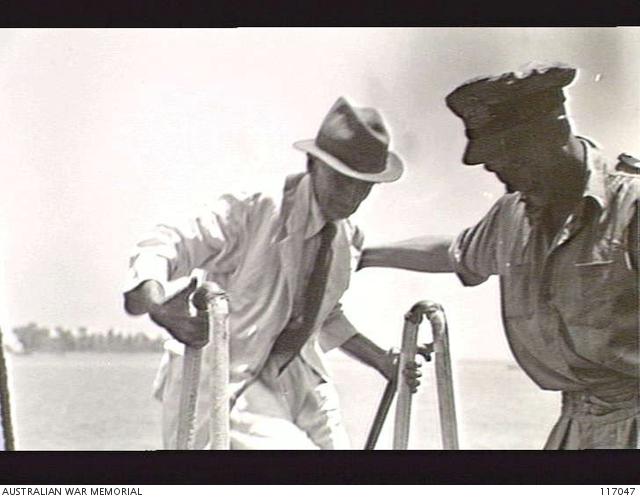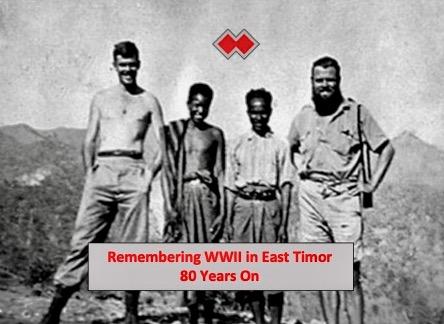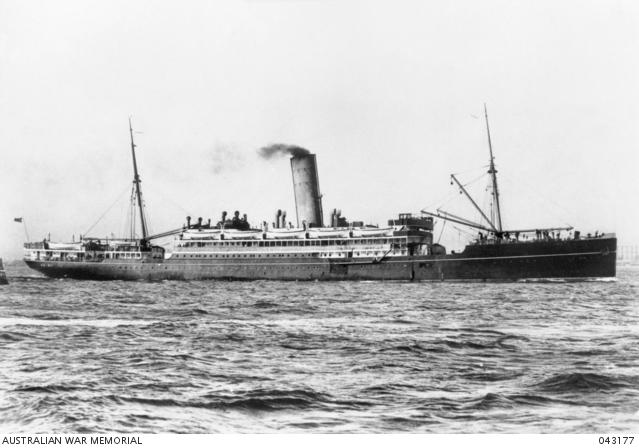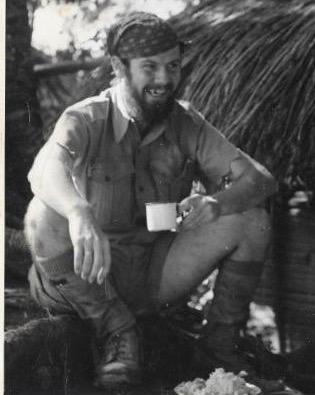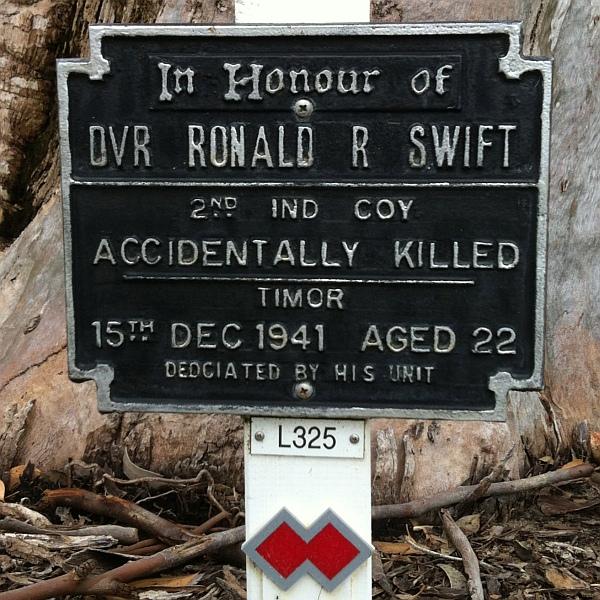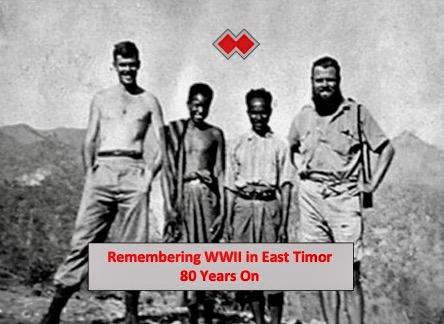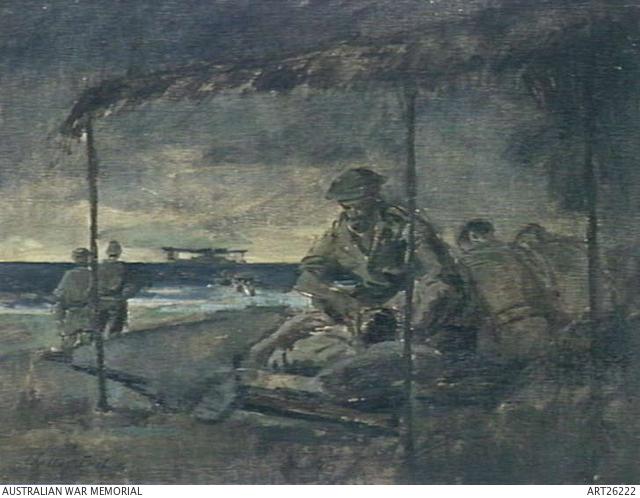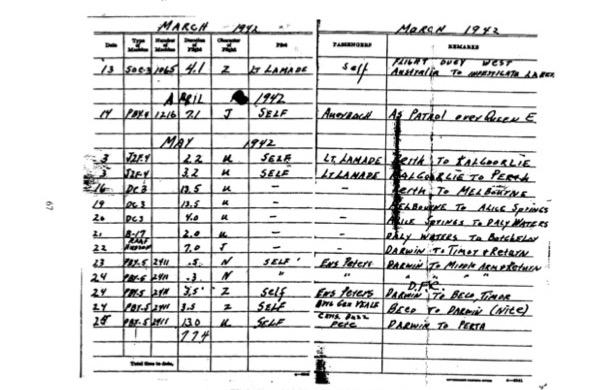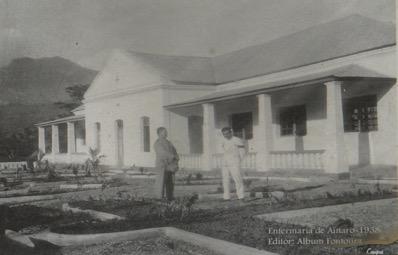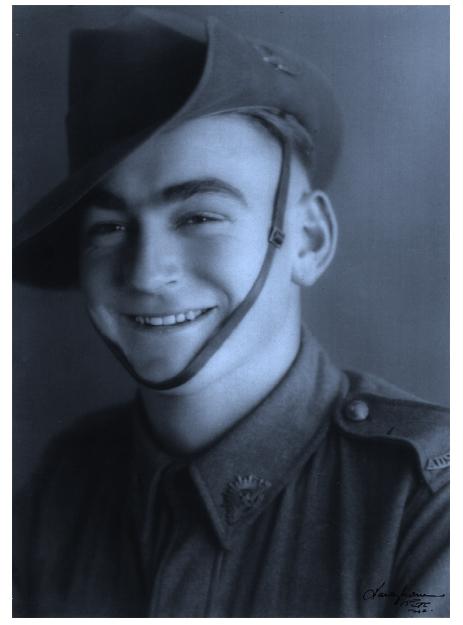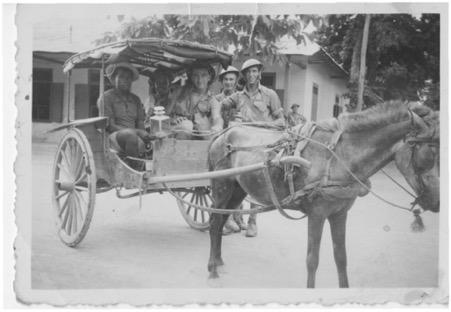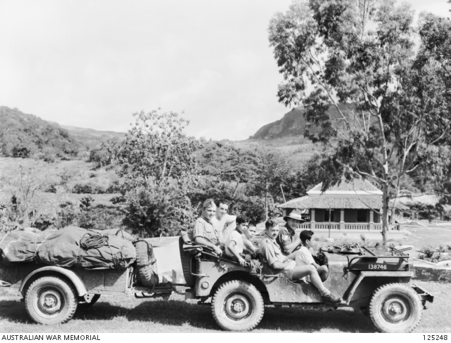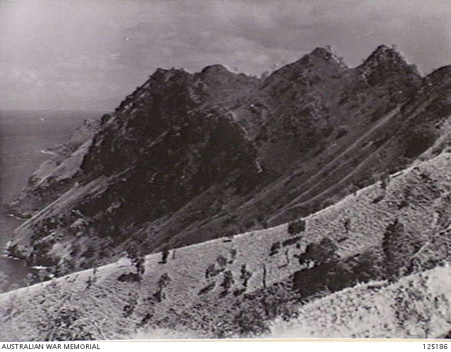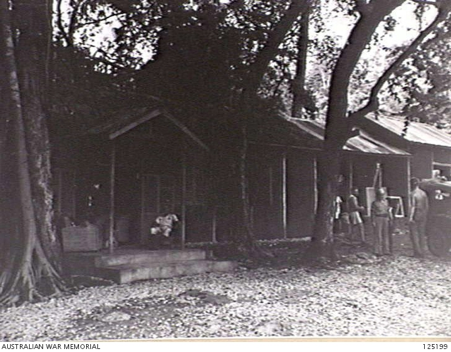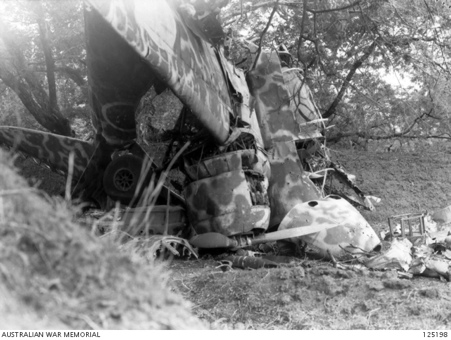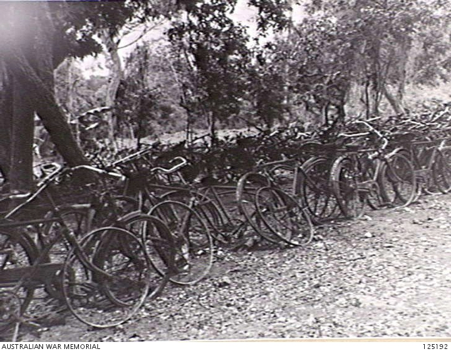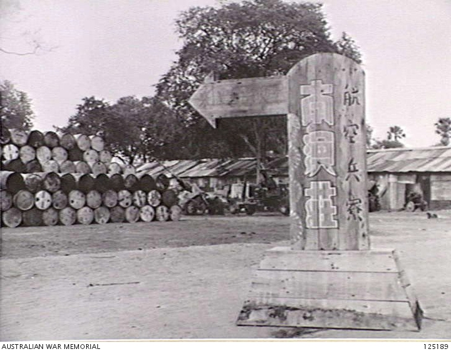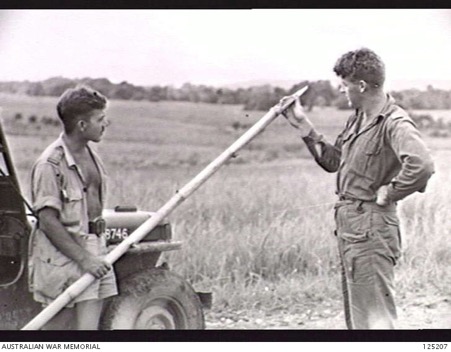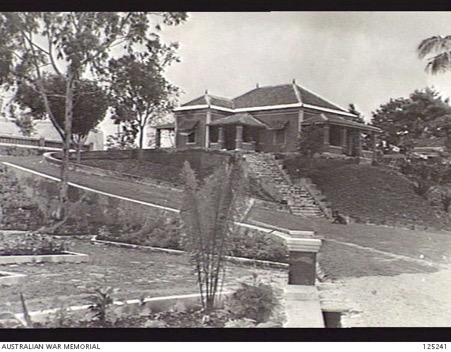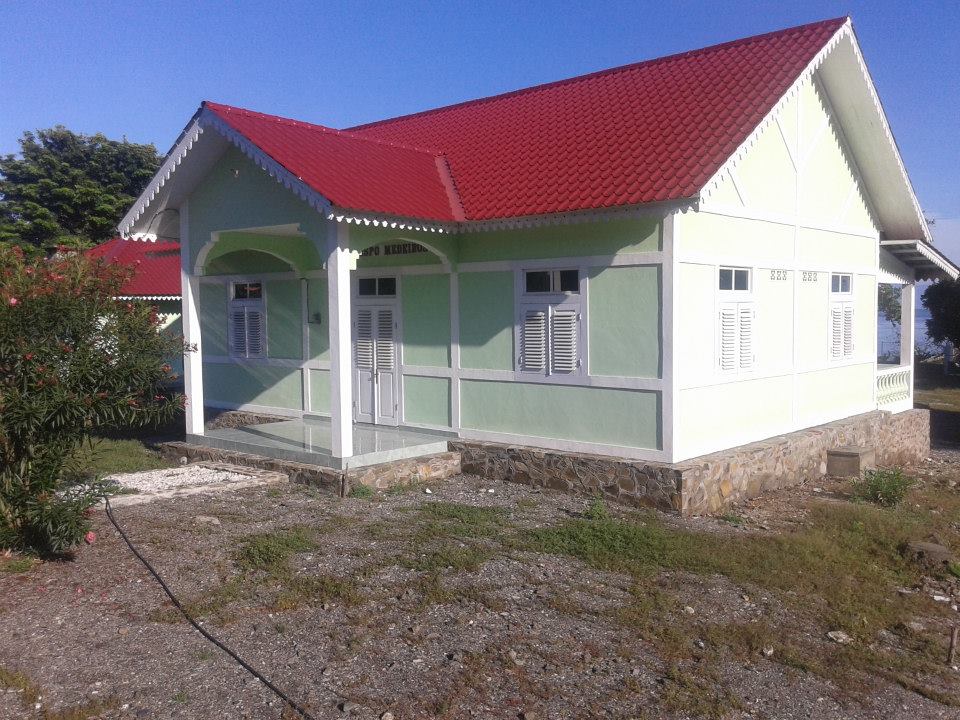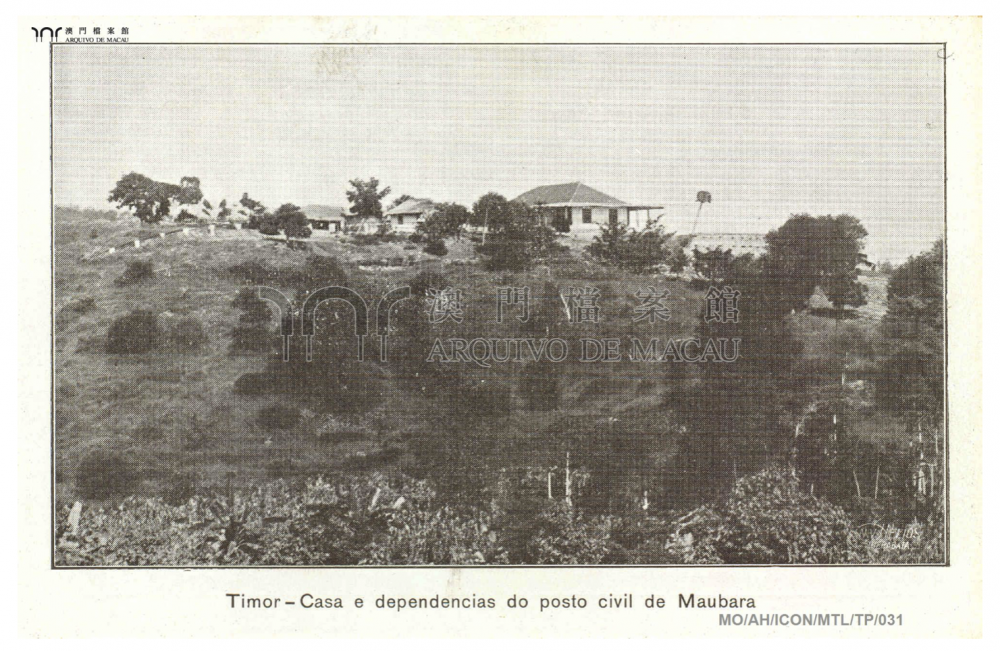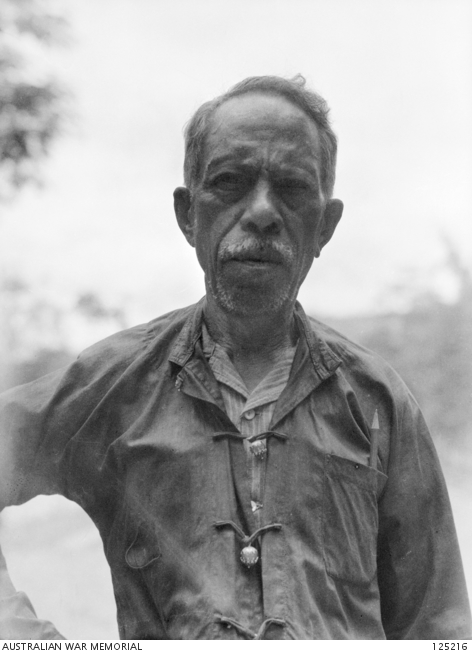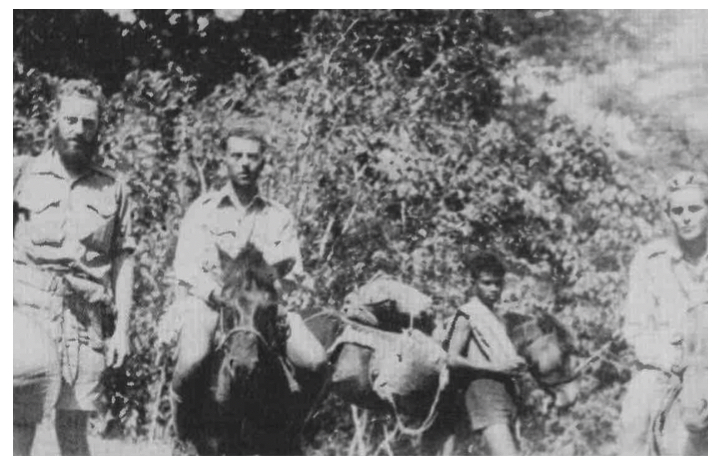-
Posts
618 -
Joined
-
Last visited
Content Type
News
Video & Audio
Men of the 2/2
Forums
Store
Gallery
Everything posted by Edward Willis
-
‘What the bloody hell is happening in Portuguese Timor’ INVESTIGATION MISSION TO DILI 8 January 1942 INTRODUCTION (Edwin) Harry Medlin (1920–2013) was Deputy Chancellor of the University of Adelaide from 1978 to 1997. [1] As a young man he was commissioned in 1939 and was serving as a Lieutenant in the 2/1st Fortress Company Engineers at the time Sparrow Force took up defensive positions around Koepang in Dutch West Timor in mid-December 1941. He was captured by the Japanese and held as a prisoner of war in Timor from 23 February 1942 and transferred to Batavia in Java in September 1942 until he was freed on 23 September 1945. Medlin wrote in detail about events in Timor, especially in relation to the action, but also before action and afterwards, including his life as a POW in Timor and Java; his objective was to 'set the record straight' about what he believed to be serious errors of omission and fact in all accounts of the history of Sparrow force in Dutch Timor, and his first-hand account provided valuable insights. [2] In early January 1942, prior to the Japanese assault on Timor, Medlin was a member of a small Allied (Australian/Dutch) mission that travelled from Koepang to Dili in Portuguese East Timor to investigate a report that the ‘… Portuguese Governor has complained that Allied Commanders, particularly the Dutch, are behaving in a very high-handed manner and are requisitioning extensively, impressing foreign residents etc. [and] that fresh troops are being disembarked and that Governor is in state of high indignation’. HARRY MEDLIN RECALLS THE MISSION TO DILI Medlin’s recollections of the mission follow [3]: Wigmore [4] reports on a conference in Koepang on the evening of 15 December 1941 between Mr. Niebouer (Dutch Resident at Koepang) [5], Ross [6], van Straaten [7], Leggatt [8], Detiger [9], Commander of the Soerabaja (5644 tons), Wing Commander F. Headlam (C.O. RAAF squadron) [10], Major A. Spence (OC 2/2 Indep. Coy.) [11] and staff officers. The decision was taken to occupy Dili because Japanese ships were said to be in the vicinity. Wigmore then describes negotiations with the Governor of Portuguese Timor (Manuel de Ferreira de Carvalho) and the subsequent occupation by Australian and Dutch troops. There is no record anywhere that I can find of the next development which, it was said, arose out of a curt telegram from the British Prime Minister, Winston Churchill. Portugal (like Sweden and Switzerland) was neutral during WW2, and it suited the (Northern Hemisphere) antagonists’ purposes to preserve that neutrality. Portuguese troopships were said to have been coming from Lorenzo Marques in East Africa. The hearsay catalyst is said to have been the cable ‘Highest British Political Authority demands to know what the bloody hell is happening in Portuguese Timor’. Athol Wilson [12], a Melbourne lawyer, led the Inquiry in Dili. I was chosen as Staff Officer to Major Wilson. I assume that Wilson was chosen because Leggatt, although also a lawyer, had been involved in that initial decision to occupy Portuguese Timor. Although I do not recall the date, I believe it to have been about 10 January 1942, but it might well have been later because photographs show me with a ‘tin hat’ and air raids did not start until 26 January 1942. Fokker aircraft of the type used to fly the investigation team from Koepang to Dili We flew in a 3-engine Fokker with ‘pusher’ engines; we were camouflaged from above and flew extremely low to evade possible Japanese fighters. There were two pilots and three passengers namely Wilson, Headlam and Medlin. I have photographs of Wilson, Ross, van Straaten and Spence in conference and with (Capt.) Callinan [13], Medlin and (? Mr.) Whittaker [14] in attendance. I have other photographs taken that day including one of a small Japanese ship tied up at a jetty in Dili Bay. I think that I know that the recommendations were that our occupation was justified, and that the Dutch presence was no long-term threat to Portugal. In the final event the Japanese invaded the whole island and demonstrated a complete contempt for Portuguese neutrality. There is no reference by Churchill even in his history, The Second World War, nor of any concern for Timor except to comment [15] (v.4 The hinge of fate, p.128) upon its loss to the Japanese. I repeat that I find it, at best, strange and possibly somewhat sinister that there is no record either of Wilson’s inquiry or of his report. The Inquiry was conducted -- I was there - and I knew Athol Wilson well enough to know that there was a Report. WHERE IS IT? Medlin recorded another recollection of this event: [16] Senior officers always have to have junior officers around, looking after their needs and what not, so I went. We met with Major Spence who was the commanding officer of 2/2nd Independent Company, and the governor of Portuguese Timor, and as I say I have taken photographs in the plane and we flew very low because we were camouflaged from above, not below and there was a risk of being shot down by Japanese fighters. And I believe that the conclusion of Athol Wilson and of the governor, and of the Dutch was, that although Dili had been occupied there was no long-term risk of the sovereignty of Portugal over Portuguese Timor. Now I have tried myself to find a copy of that report, I knew Athol Wilson well enough to know that there would have been a report, but it could find nothing. But you have triggered me into remembering this, I will look again, there will be a report somewhere, and I know enough about the army to know that they never destroy anything, not openly anyway. So that was that. Well, I think I said before, when the Japanese landed, they took no account of Portuguese neutrality, and the Independent Company just withdrew and harassed them from the hills. PHOTOGRAPHIC RECORD OF THE MISSION Harry Medlin notes that a camera was in his possession during the mission and he took photos at various times featuring the participants and street scenes and aerial views of Dili. As Medlin himself appears in some of the photos, Athol Wilson probably took some of them. These images provide a unique and valuable record of the occasion; the personal photos are remarkably candid and evocative. [17] 1. Major Athol Wilson (rear), unidentified soldier (front) 2. Frank Whittaker (Australian Naval intelligence officer) (left), Dutch officer Lieutenant Jan Zijlstra (right) 3. Frank Whittaker (Australian Naval intelligence officer) 4. Wing Commander Frank Headlam (left), Lieutenant Harry Medlin (right) 5. Lieutenant Harry Medlin (left), Wing Commander F. Headlam (RAAF) (right) 6. David Ross (Left), Lieutenant Colonel Van Straten (right) 7. Left to right – Lieutenant Colonel Van Straten, Major Athol Wilson, David Ross, F.J. Niebouer (Dutch Resident Koepang) 8. Major Alexander Spence (left), Lieutenant Harry Medlin (right) 9. Portuguese artillery piece 10. Portuguese artillery piece close up 11. Dili street scene 12. Dili street scene 13. Dutch soldiers 14. Dutch soldier 15. Japanese spy ship Nanyei Maru 16. Dili harbour 17. Residence British Consul, David Ross 18. Dili street scene 19. Aerial view Dili 20. Portuguese military barracks, Dili (Dutch HQ) 21. Dili street scene 22. Rua de?, Dili 23. Aerial view Dili (Taibessi?) 24. Aerial view Dili Harbour 25. Aerial view Dili 26. Sunset, Port of Dili THE DOCUMENTARY RECORD OF THE MISSION Medlin is correct in asserting that ‘… there would have been a report’ submitted on the mission but the documentary record is patchy and difficult to locate. The earliest relevant document located thus far originated on 26th December 1941: DEPARTMENT OF EXTERNAL AFFAIRS CABLEGRAM 2648, sent 26th December 1941 TO BRITISH CONSUL, DILLI. C.G.S. has been informed by Sparrow force through Army channels as follows: ‘Dilli position most unsatisfactory. Governor organising troops who may harass our troops and will certainly assist any Japanese landing. Van Straaten awaiting instructions Dutch headquarters. Essential to take military control and disarm Portuguese. Delay through political negotiations becoming dangerous. Urgent.’ Inform Commander of Australian forces that on other hand Portuguese Governor has complained that Allied Commanders, particularly the Dutch, are behaving in a very high-handed manner and are requisitioning extensively, impressing foreign residents etc. that fresh troops are being disembarked and that Governor is in state of high indignation. You will observe that this is [a] complaint which reaches us from U.K. via Portugal. I am greatly surprised that you have not sent regular reports as I have asked. We desire urgently your comments and suggestions on above. In particular what restrictions or censorship are being imposed upon Portuguese authorities. MINISTER FOR EXTERNAL AFFAIRS [18] On the next day, the following signal was received by Sparrow Force; note the reference to ‘highest political minister’ that connects with Medlin’s recollection of the stimulus for the mission: To Sparrow Force From Army Melbourne MC4088 27/12 Immediate For OC SPARROW stop Your message 27/12 through DARWIN regarding situation DILLI stop Whole message now being considered main body highest political minister officially informed essential SPENCE OC no contact ROSS and last named forward his views immediately. [19] No documents have so far been located that specifically refer to the establishment and conduct of the mission though Medlin’s recollections and subsequent reports confirm that it actually took place; for e.g., the No. 2 Independent Company War Diary entry for 8 January 1942 recorded: … Visit to Dili by NEI resident from KOEPANG. PORTUGUESE GOVERNOR has reported adversely on behaviour of NEI and Australian commanders in requisitioning Portuguese property and impressing foreign nationals, particularly NEI commander. This report which has just reached Dili has surprised all – at the same time as he sent report off – told Colonel VAN STRAATEN that the behaviour of the occupying force had been good. The opinion of interested persons have that Colonel VAN STRAATEN, who has CO of Force, carried out all negotiations with governor, has been most restrained, in spite of lack of cooperation from Governor. 15 natives arrived at company HQ for work on shelters. [20] Prime Minister John Curtin communicated the findings of the investigative mission to the British government on 10 January 1942: PRIME MINISTER'S DEPARTMENT CABLEGRAM. DECYPHER TO SECRETARY OF STATE FOR DOMINION AFFAIRS, LONDON 0.985 0.986 0.987 DATE SENT: 10 January 1942 No. 38. Repeated to Governor of the Straits Settlement for Commander in Chief, Far East, No, 3, and Prime Minister of New Zealand No. 18. SECRET. TIMOR. Your telegram 25th December No. 895 paragraph 1. Ross reports that allegations against occupying force attributed to Governor entirely without real foundation and that no serious complaint had been made by any inhabitants including foreign nationals now under restraint. No Portuguese property other than open land has been requested. Ross adds that complaints to Lisbon referred to are even contrary to the views expressed personally by the Governor to the Dutch Commander. In his opinion complaints are nothing more than an attempt to stir up trouble and influence political negotiations. No restrictions of any sort have been placed on Portuguese authorities who are at liberty to send and receive any radio messages on Government business. Whole attitude of Dutch Commander has been one of extreme courtesy and consideration oven when latitude allowed has been abused and petty obstructive tactics employed against him. CURTIN Copy sent to Dr. Evatt, Mr. Forde, Col. Hodgson, Mr. Shedden 13.1.42 [21] The British Secretary of State for Dominion Affairs responded to Curtin’s message two days later (12 January 1942): ‘Ross’s reports as to allegations against the Allied Force noted’. [22] REFERENCES [1] https://en.wikipedia.org/wiki/Harry_Medlin [2] Peter Henning. - Doomed Battalion: mateship and leadership in war and captivity - the Australian 2/40 Battalion 1940-45. – 2nd ed. - [Exeter, Tasmania]: Peter Henning, c2014: 7. [3] Dr. Harry Medlin ‘Timor and Java’ https://studylib.net/doc/9066385/timor-and-java---the-recollections-of-lt-harry-medlin: 11. [4] Lionel Wigmore. - The Japanese thrust. - Canberra: Australian War Memorial, 1957. (Australia in the war of 1939-1945. Series 1, Army; v. 4) - Ch. 21 ‘Resistance in Timor’: 469. [5] Mr. F.J. Nieboer, Dutch Resident (Governor), Koepang 1941-42. [6] Mr. (later Group Captain) David Ross, British Consul, Dili, Portuguese Timor, 1941-42. [7] Lieutenant Colonel N.L.W. van Straten, Commanding Officer, Dutch contingent, Portuguese Timor 1941-1942. [8] Lieutenant Colonel W.W. (Bill) Leggatt, Commanding Officer, 2/40 Battalion, also original Commanding Officer Sparrow Force, 1941-42. [9] Lieutenant-Colonel W.E.C. Detiger, Commanding Officer, Dutch Timor and Dependencies Territorial Command, 1941-42. [10] Wing Commander Frank Headlam, Commander, No. 2 Squadron, Penfoei, Dutch Timor 1941-42. [11] Major Alexander Spence, Commanding Officer, No. 2 Independent Company, Portuguese Timor, 1941-42. [12] Major Athol Wilson, Commanding Officer, 2/1 Heavy Battery, Koepang, Dutch Timor, 1941-42. He died of wounds 20 February 1942 at Klapalima, Dutch Timor. [13] Captain Bernard Callinan, 2nd In Command, No.2 Independent Company, Portuguese Timor, 1941-42. Callinan was in fact not present at the meeting. [14] Mr. F.J.A. (John) Whittaker, Civil Aviation clerical officer, British Consular Office, Dili, Portuguese Timor, 1941-42. In mid-April 1941, the Director of Naval Intelligence proposed appointing an officer to Dili ostensibly in the role of a Civil Aviation clerical officer – citing an Australian War Cabinet agendum (No.109/1941 – February 1941) that directed their military intelligence services should arrange ‘for special watch to be kept by them on the peaceful penetration by Japanese into Portuguese Timor … ‘. The Australian Naval Board concurred and coordinated with DCA for a naval intelligence officer – Paymaster Lieutenant F.J.A. Whittaker, to operate ‘nominally as a clerk to assist Mr David Ross’ and ‘who would, in the guise of a civilian, be able to discharge the Naval Intelligence duties required of him’. See Navy Office, Memorandum 018820 - 43/85, Melbourne, 28 April 1941 (NAA: 981 TIM P 6, p.57; NAA: B6121, 114G). [15] Winston Churchill. – The hinge of fate. – London: Cassell & Co., 1950: 126. [16] ‘Edwin Medlin (Harry) - Transcript of interview Date of interview: 8th March 2004’ Australians at War Film Archive http://australiansatwarfilmarchive.unsw.edu.au/archive/1503 [17] These photos were in the personal papers of Sir Bernard J. Callinan and were kindly made available to the 2/2 Commando Association of Australia archives by his son Nicholas. [18] 26/12 War Cabinet Agendum - No 270/1941 and supplements 1-3 - Occupation of Portuguese Timor - NAA_ItemNumber11294556 2.pdf – NAA, A2671, 270. [19] Sparrow Force war diary, message received 27 December 1941 – Australian War Memorial RCDIG 1024692. [20] No. 2 Independent Company War Diary 8 December 1941 - 16 December 1942. An entry in Colonel Van Straten’s dairy covering this period also provides confirmation: Furthermore, the ashes in Lisbon are burning quite violently, which even resulted in an official complaint via London, whereupon the GG (Governor-General Sjarda van Strakenborgh Stachouwer) sent the resident of Koepang (Niebouer) for an investigation, which, however, was entirely in my favour. Source: E-mail from: Gerard van Haren to author sent Thursday, December 23, 2021 10:13 PM. [21] War Cabinet Agendum - No 270-1941 and supplements 1-3 - Occupation of Portuguese Timor - NAA_ItemNumber11294556.pdf – NAA A2671, 270/1941. [22] Occupation of Portuguese Timor - (File 1) to 30-1-1942 - NAA_ItemNumber170185-2.pdf. – NAA A816, 19/30. Prepared by Ed Willis Revised 9 January 2022
-
CHRISTMAS DAY IN DILI 25 DECEMBER 1941 INTRODUCTION The fullest (and frankest) account of how the men of the 2nd Independent Company spent Christmas Day 1941 in Dili is provided by Cyril Ayris in ‘All the Bull’s men’ (pp.71-74). Annotation on rear of photo: Timor-Dilli Chinese Studio Xmas 1941: Colin Criddle – Pinky L, Fred Smith – Smithy C, Cyril Doyle – Tiger R - [Source: 2/2 Commando Association of Australia photo archive] One photo located in the Association archives was taken on Christmas Day 1941 in Dili. It is a remarkably evocative informal group portrait of three men from No. 2 Section: Colin (Pinky) Criddle, Fred Smith, and Cyril (Tiger) Doyle; they distinguished themselves in the defence of the airfield when the Japanese landed nearly two months later on February 19 1942. 2nd Independent Company men on leave in Dili – January 1942 – Tony Adams tentatively identified on the right – [Source: 2/2 Commando Association of Australia photo archive] The men of the Signals Section also spent the day together and Corporal Harry Wray recorded his memories of it and related events and personalities. HOW THE SIGNALS SECTION SPENT CHRISTMAS DAY IN DILI, 1941 [1] For the first few days at the Dili aerodrome my Section was camped in a lean to shed of palm thatch, about six feet high in front and three feet high at the back. The mosquitos were very thick at night and we slept under nets, all snowy white, and could be seen for hundreds of yards at night. The Dutch had green nets, and green tents, all our equipment shone with new whiteness, and was difficult to camouflage. Photo included in 'Report on a visit to Portuguese Timor' by Captain Johnston, Dr. Bradfield and Mr. Ross - 29th December, 1940 - 1st January 1941 (NAA: A816, 19/301/778) Later we shifted to a coconut grove skirting the aerodrome and pitched tents there. The ground was very wet, almost boggy in fact, and even with ground sheets under our sleeping bags became damp.On Christmas Day, we were allowed leave to visit Dili in the afternoon, and several of us hired a tiny carriage drawn by two Timor ponies and set off in state. We had a look at the cathedral, and a walk around the town, which did not take long. Portuguese postcard showing the Dili Cathedral We bought soap and Chinese cigarettes from some of the numerous Chinese shops, then went to the waterfront and had a look at the small Jap ship tied up at the jetty. This ship used to lie off Dili prior to our arrival and before the Jap entry into the war, and every day would go out beyond the three-mile limit and send and receive messages from Japan on the very powerful wireless set, which had been installed on board. After the Japs came into the war our Hudson’s based at Koepang heard of the ship and how it went out each day to send and receive messages, so one day a Hudson swooped down and machine gunned it to such an effect that most of the crew jumped overboard, and the crew of the Hudson had the pleasure of seeing sharks put an end to those who did so. The remainder of the crew took cover and let the ship run as she pleased until she piled up on the beach of a nearby island. Later a Dutch ship found her deserted and towed her back to Dili where the Dutch almost tore her apart searching for what they could find. When I saw her the panelling was ripped off walls, bedding ripped open, and everything in a terrible mess after the search. Goodness knows if anything worth having was found. We managed to get a few batteries from the radio installation, which came in very useful later on. A fair number of drums of oil and petrol were found in the holds of the ship; however, the Japs had put sand in the oil and petrol before leaving her derelict. After filtering, some of the oil and petrol came in quite handy to the Dutch, and us also. The Japs had also taken the precaution of removing a few vital parts from the engine, which made it hopeless to attempt to get the engine running. I noticed that the Hudson had made a good job of the doing over, which it gave the ship, as the bridge and decks were holed like the top of a pepper pot. Patricio Luz, a radio operator at the Portuguese radio station prior to the occupation. Behind him is the wreckage of the Japanese ship, ‘Nanyei Maru’, in Dili harbour. It had been bombed and strafed by the RAAF immediately after the declaration of war with Japan and after drifting unmanned was eventually towed to Dili harbour. (Photographer Sgt K. Davis). Source: AWM photo ID number 121402: Dili, Portuguese Timor 1945-12-09. After visiting the Jap ship, we went back to the town square near the cathedral and hired a couple of the carriages to take us back to the aerodrome. The drivers at once whipped at their horses and off we went at a gallop. Our ponies managed to take the lead, and one of our chaps in the other carriage thinking he could make a better job of the driving took the reins from the native boy, and with whip and shouts urged the ponies on to greater efforts. This resulted in his carriage gaining on us, and in trying to pass he took his carriage too near the edge of the drain running alongside the road. This drain was about twelve feet deep and about twelve feet wide. Jerry’s carriage hung balanced on the edge of the drain while the ponies hung down the sides. We ran back to the rescue and soon dragged the terrified little ponies back onto the road and righted the carriage. Jerry had to pacify the boy with an extra Pataka (1/8). Annotation on rear of photo: Taken January 1942 – One of the carts used to a great extent – L to R – M. Ryan, F. Smith, A. Dalbridge. Source: 2/2 Commando Association of Australia photo archive. All hands were supposed to take quinine twice a day. This quinine was in powder form, and it was very difficult to persuade anyone to take it, and I imagine this contributed to the heavy toll malaria was soon to take. I had the job of seeing that my Section had his quinine, and watched to see that everyone did take it, but I used to wrap each dose in a cigarette paper, and consequently did not have much trouble getting everyone to have his dose. One man who preferred the powder neat, and said he liked it: a peculiar taste. The only other time I was in Dili was one morning when we had a few hours leave. One of our officers said he would take a few of us who had happened to run into him in the street, to dinner at one of the few hotels. [2] On the way, there he told me that he was short of money and perhaps I could lend him some. I did and had the pleasure of him standing us all drinks and dinner at my own expense, as I only recovered a very small part of the loan a few days later. Source: Hudson Fysh ‘Australia’s unknown neighbour – Portuguese Timor’ Walkabout, vol. 7, no.7, May 1st 1941, p.7. At this hotel, we met a man who was an employee of Imperial Shell and had been making a survey of Timor for the purpose of assessing the geological possibilities as regards oil. [3] This chap told us an amusing tale, or rather an amusing experience. Not long before the Jap declaration of war, such as it was, the Japs had concluded a treaty with the Portuguese by which they were given full rights to the use of Dili aerodrome, for civil purposes of course, or what they told the Portuguese at the time. On the day that this treaty was finalised the Shell man happened to be in Dili staying at the hotel. Later in the day a Qantas flying boat pilot came along to the hotel for the night. The flying boats stayed overnight at Dili at that time. The pilot and the Shell man were old friends. The pilot asked the Shell man to accompany him to a function that evening to celebrate the treaty between the Japs and the Portos. The Shell man was finally persuaded, and the pilot obtained the necessary invitation for his friend. Mr George Bryant, an Australian who has lived in the area for the past 24 years, being welcomed aboard the RAN vessel HMAS ‘Warrnambool’, a section of Timforce, which has arrived in the area to ensure that the Japanese forces carry out the surrender terms. Source: AWM phot ID number 117047: Dili, Portuguese Timor, 1945-09-23. The Shell man told us it was a terrific celebration, with both the Japs and the Portos getting more and more drunk as time went on. Everyone was on the best of terms with everyone else, the Japs sang songs in praise and honour of their Porto friends, and the Portos did likewise, but the cream of the piece came when the Japs and Portos decided to honour their English and Australian friends by roaring out ‘God save the King’ in the heartiest fashion. Only a few weeks after this token of their everlasting friendship, they were at war with us. I do not know what became of the Shell man, as several Qantas flying boats called after I saw him, and before the Japs appeared on the scene. He may have left safely, and in time. There was an old man living in Dili, an Australian who had been there for years. He did a little prospecting at times, but latterly I think he was living at the Australian Consul’s house doing odd jobs there. As it happened, he was the uncle of one of our men, quite a coincidence that they should meet in Dili of all places. I do not know what became of this man, he was in Dili during the Jap occupation I believe and may still be there. [4] I forgot to say that our Lieutenant [John Rose] managed to buy a bundle of fresh fish something like herrings in appearance, and full of bones, for our Christmas dinner. We also provided a few fowls, which we souvenired from a deserted house nearby. The owner of the house was an Arab, and we learned later a spy in the pay of the Japs. He kept well out of the way while we were at the aerodrome. We did hear subsequently bumped him off for some reason best known to themselves. They liquidated several of their friends at different times, as you will hear later, one of their very good friends just because he was unlucky enough for appearances to be against him. To get back to the Christmas dinner, the fowls gave us a terrific chase in the heat of the day, but we managed to catch about six of them, so with the fish did quite well for ourselves. NOTES [1] Corporal Arthur Henry Kilfield ‘Harry’ Wray (WX11485), Recollections of the 2nd Independent Company Campaign on Timor, 1941-42, manuscript in 2/2 Commando Association archives. [2] This was probably Lieutenant Colin Doig. [3] This was M.L.E.J. Brouwer, a Dutch geologist from Bataafsche Petroleum Maatschappij (Shell), arrived in Timor during April 1941. There was considerable suspicion that Brouwer was a Nazi sympathiser, but a later memo indicated that 'Brouwer is a geologist for cover only' suggesting that his primary role was not exploration. See Tim Charlton ‘History of petroleum exploration in Timor-Leste’ http://www.timcharlton.co.uk/other-projects/timor-leste-history-of-oil-exploration [4] Bernard Callinan described Bryant as David Ross’ ‘general factotum’. Bryant’s nephew was Cpl. Bryant, William Frederick VX29713, a cook in Q Section. Bryant was born in Melbourne in 1882 and had worked in Portuguese Timor for at least 28 years. Although ill, Bryant survived the war in Dili. For an interesting summary of Bryant’s life, see J. Carey ‘Link with the past’ 2/2 Commando Courier vol. 140, September 2002, pp.10-11 https://doublereds.org.au/couriers/2002/September/ Revised and adapted from an earlier post commemorating the 75th Anniversary of this event Ed Willis 23 December 2021
-
THE OCCUPATION OF DILI BY THE NO. 2 AUSTRALIAN INDEPENDENT COMPANY AND THE DUTCH CONTINGENT – PART 2 December 16-20, 1941 Paul Hasluck prepared a succinct and authoritative summary of the events leading up to the joint decision made by the Australian, British and Dutch governments to proceed with the occupation of Dili in neutral Portuguese Timor in mid-December 1941. [1-2] Hasluck’s summary of the Allied decision-making process and concomitant diplomatic negotiations with Portugal regarding this initiative is complemented by Lionel Wigmore’s brief narrative of the actual events. Both Hasluck’s and Wigmore’s contributions were prepared for the official history ‘Australia in the War of 1939-1945’. This post supplements an earlier contribution commemorating the 75th anniversary of this event from a more personal viewpoint; see: https://doublereds.org.au/forums/topic/89-75-years-on-the-australian-and-dutch-landings-at-dili-17-20-december-1941/#comment-135 Hasluck’s summation follows: THE ‘TIMOR PROBLEM’ Australia itself, adding to the measures previously taken for collaboration with the Netherlands East Indies and for the security of New Caledonia, had given further attention to the position of Portuguese Timor. Early in 1941 the Australian Government had become concerned at reports of Japanese activities in Portuguese Timor and particularly the way in which Japan was gaining support from the local population by arranging to purchase the exportable surplus of their coffee crop. As in the case of New Caledonia the first move by Australia was in the direction of giving commercial support to the Portuguese dependency. At the same time arrangements had been made to use Dili as an alternative stopping place on the Australia-Singapore civil air route and advantage was taken of this arrangement to appoint the Chief Flying Inspector of the Department of Civil Aviation, Mr David Ross, [3] as Australian Civil Aviation representative there. From the outset, however, it was indicated that Ross, who was furnished with light aircraft for his use, should also report to the Australian Government on the general situation in Portuguese Timor, both keeping an eye on what the Japanese were doing and also advising the Government on any opportunities which Australia could take to improve its position. The measures for the defence of Timor in the case of Japanese action against the Portuguese were also discussed in the course of conversations with the Dutch and the British in February 1941, and it had been agreed to have certain Australian troops available with Dutch troops at Koepang in Dutch Timor. Later in the year the possibility of a German move through Spain and Portugal caused the Department of External Affairs to draw attention to the possibility that, if control of the colony from Portugal were broken, Japan would probably seize the opportunity to take Timor under protective custody. The Government therefore approached the United Kingdom Government with a view to reaching an understanding between the United Kingdom, the Netherlands and Australia regarding the occupation of Portuguese Timor, either jointly or by the separate forces of one of the three nations in the event of either German occupation of Portugal, a Japanese landing in Timor without the outbreak of war between Japan and the Allies, or, in the final extremity, in the case of war with Japan. [4] The United Kingdom agreed with the sense of the Australian proposals and also proposed discussions with Portugal. For the purpose of these discussions the United Kingdom asked Australia whether, if Portugal agreed to accept reinforcements, Australia would be willing to accept commitments in respect of Portuguese Timor in addition to the commitments already accepted in respect of Ambon and Koepang. By a War Cabinet decision of 15th October Australia agreed that Portugal should be asked whether she was ready to accept outside help if help should be found necessary by the military authorities on the spot, and that both the Netherlands and Portuguese Governments should be asked to agree to local discussions between Australian, Dutch and Portuguese military authorities regarding the necessary preventive measures. The War Cabinet also decided that, in view of the threat to Australia which would arise from a Japanese occupation of Timor, Australia should cooperate to the fullest practical extent in measures for the defence of the colony. To that end the Australian air forces to be provided for reinforcement of Ambon and Koepang should also be available for operations in Portuguese Timor and an additional battalion of supporting troops should be made available to reinforce Portuguese Timor if the Portuguese agreed to accept reinforcements. [5] At the suggestion of the United Kingdom, Ross was given rank as Australian Consul at Dili in order to facilitate his work. Negotiations with the Portuguese Government had not been concluded when war came. BRITISH NEGOTIATIONS WITH PORTUGAL As mentioned earlier, some 1,600 Australian troops had been sent to Dutch Timor from Darwin on 12th December. That day the Portuguese Government agreed to a proposal made by the British Government, with Australian and Dutch approval, that the Governor of Portuguese Timor should acquiesce in the arrival of Australian and Dutch forces in Portuguese Timor if it was attacked. The colony of Portuguese Timor, consisting mainly of the eastern half of Timor Island, only 400 miles from Darwin, had a population of 450,000 including only about 300 Europeans and being half a world away from a metropolitan state of limited economic and military resources was itself backward in development and practically undefended. Defensively it was the weakest point in the Indonesian chain and the point nearest to the Australian mainland. There had been signs of increasing Japanese interest in the colony for some years. The diplomatic weakness of the Portuguese arose both from the position of Portugal as a small Continental European state conscious of the dominating power of Nazi Germany on the Continent and from the fact that the most important of its Asiatic colonies, Macao, was under immediate threat from the Japanese army in South China. The Portuguese Government, under Dr Salazar, though holding to the current alliance with Great Britain, was susceptible to Axis pressure both in Europe and Asia. They had no love for the Japanese but were not strong enough to risk offence. THE DIE IS CAST On 16th December the British Government informed the Portuguese Government that a Japanese attack on Timor seemed imminent and it had arranged with the Australian Government that Dutch and Australian officers should see the Governor of Portuguese Timor and, in anticipation of an invitation to lend help, some 350 Dutch and Australia n troops would arrive two hours after the interview. [6] On the 17th the Australian Lieut-Colonel Leggatt [7] and the Dutch Lieut-Colonel Detiger, both in civilian clothes, arrived at Dili, the capital of the Portuguese colony, and were introduced to the Governor by Mr David Ross, the Australian Consul there. The Governor said that his instructions were to ask for help only after being attacked. He was told that troops were on their way. (Netherlands Indies troops numbering 260 and 155 Australians had embarked for Dili in a Dutch warship on the 16th). Meanwhile in Lisbon: Dr Salazar's reaction was sharp and violent. He refused to allow the Governor to agree to assistance except in the event of an attack. He argued that an earlier admission of Allied troops would mean the abandonment of Portuguese neutrality and would be followed by the Japanese seizure of Macao. [8] At Dili at 9.45 a.m. on the 17th the Governor told the Australian and Dutch envoys that he had received a message from Lisbon and wanted an hour to decode it. This was agreed to. The Dutch warship carrying the troops had already arrived. At 10.50 the Governor said that the message instructed him not to allow troops to land unless Portuguese Timor was attacked, and therefore his forces must resist. Leggatt and Detiger replied that they hoped there would be no fighting and pointed out that the defending force was too small to succeed. The Governor said that he would see the commander of his troops and, in the words of Leggatt's report, ‘ascertain what arrangements could be made’. That afternoon the troops landed unopposed. The inhabitants seemed friendly. The British Government, anxious to avoid a break with Portugal, proposed that the Allied forces should be withdrawn on the arrival of Portuguese reinforcements, and this was agreed to. On 31st December the Australian Advisory War Council was informed of a proposal to replace Dutch forces in Portuguese Timor with an equivalent number of Australian troops from those already in Dutch Timor. They were also informed of Japanese pressure on Portugal to secure withdrawal of Allied forces, under threat of Japanese action, and advised of the proposal that Australian and Dutch forces be withdrawn from Portuguese Timor on the arrival of 700 Portuguese troops. [9] The Australian Chiefs of Staff, however, in a report dated 4th January, expressed the view that 700 Portuguese would not constitute an adequate protection. It was decided to place this view before the British Government. By 22nd December the Australian force around Dili had been increased until it comprised a complete Independent Company. Soon it was learnt that the Portuguese reinforcements were not expected before the second week in March. On 20th February, however, Japanese forces landed in Dutch and Portuguese Timor. [10] By the 23rd the main Allied force in Dutch Timor had been overcome but the Independent Company fought on in the mountains where it was joined by a considerable number of men from Dutch Timor. [11] Lionel Wigmore continues the story of the occupation in a more narrative fashion: [12] DECISION MADE TO OCCUPY DILI Preceded by about 100 additional troops from Java, Colonel van Straaten arrived at Koepang by air on 15th December to command the Dutch forces on the island. He was to be under Leggatt's command. A conference held that evening was attended by the Dutch Resident at Koepang (Mr Niebouer); the Australian Consul at Dili, Mr Ross; van Straaten; Leggatt; Detiger; the Commander of the old 16-knot Dutch training cruiser Soerabaja (5,644 tons); the Officer Commanding the Australian air force squadron, Wing Commander Headlam; [13] the Commander of No.2 Australian Independent Company, Major Spence; [14] and staff officers. Van Straaten said he had been informed by the Governor-General of the Netherlands East Indies, Jonkheer Tjarda van Starkenborgh Stachouwer, that as a result of negotiations between the United Kingdom, Dutch, Australian and Portuguese Governments it had been agreed that in case of aggression against Portuguese Timor by Japan, the Governor of Portuguese Timor would ask for help, and Australian and Netherlands East Indies troops would be sent there; further, that if the Government of the Netherlands Indies considered the matter urgent, and an attack on Dili was imminent, the Portuguese Governor would be informed and would ask for these troops to be sent. The colonel added that he was instructed by the Governor-General to say that Japanese ships were now in the vicinity of Portuguese Timor, and it was urgent that troops be sent to Dili. It was agreed that Leggatt and Detiger leave for Dili next day by the Canopus, [15] and convey this information to the Governor at 8 a.m. on 17th December. Ross flew back to Dili to arrange the interview. INDEPENDENT COMPANY AND DUTCH TROOPS TRANSPORTED TO DILI Netherlands Indies troops numbering 260, and 155 of the Independent Company embarked on the Soerabaja at 8 a.m. on 16th December, leaving the remainder of the Independent Company to follow aboard the Canopus on its return to Koepang. Wearing civilian clothes, Leggatt and Detiger were introduced by Ross to the Governor on the 17th, and Leggatt conveyed to him the message he had received through van Straaten. The Governor said that his instructions were definitely to ask for help only after Portuguese Timor was attacked. He was told that this would be too late; the troops were on their way and must land. He then asked that the matter be put in writing, and when this had been done, asked for half an hour to discuss the matter with his Ministers. At 9.45 a.m. he said a message had been received from Lisbon, and he wanted an hour to decode it. This was agreed to, but meanwhile the Soerabaja had arrived off Dili, escorted by Australian aircraft. At 10.50 a.m. the Governor announced that the message was to the effect that he definitely must not allow troops to land unless Portuguese Timor was attacked, and that therefore his forces must resist such a landing. Obviously, the Governor was seeking to follow a diplomatically ‘correct’ procedure which would avoid prejudice to Portugal's neutrality. The delegation, however, expressed the hope that there would be no fighting, pointing out that the Portuguese force was too small to succeed. The Governor said that when the landing occurred, he would see the commander of his troops, and ‘ascertain what arrangements could be made’. [16] Leggatt and Detiger then boarded the Soerabaja and reported the interview to van Straaten. DILI TOWN AND THE AIRFIELD OCCUPIED That afternoon the troops landed. Spence told his men that they might have to fight as soon as they stepped ashore; but they and 50 Dutch troops landed unopposed, on a sandy beach about two miles and a quarter west of Dili, in the early afternoon. A small party of signallers went into the town under Lieutenant Rose, [17] to take over the radio station and signal Sparrow Force at Koepang. They were agreeably surprised to find the inhabitants apparently friendly towards them, and to experience no difficulty in taking over the radio station. The Dutch were to occupy the town, and the Australians the airfield about a mile and a half west of it on the coast. As a precaution, the Australians took up positions near their objective, while Spence advanced with his No. 1 Section to the airfield and met the Governor, the Dutch Consul at Dili, and Ross. Australian occupation was agreed to by the Governor, though apparently with reluctance. Spence was unable to discover the whereabouts of the Portuguese troops, or their strength. The Australians then moved in, and at dusk were digging in around the two runways, and the hangars. The attitude of the Portuguese authorities continued to cause concern. Leggatt and Detiger returned to Koepang on 17th December, but Leggatt was back in Dili for a few hours on the 19th. He found that at van Straaten's request the Governor had sent most of the Portuguese force out of Dili, but that the Portuguese Council was meeting that day to discuss the situation brought about by the landing. Subsequent indications were interpreted as meaning that the Governor was definitely against the occupation, was obstructing by all means in his power, and probably would assist any Japanese attack. Leggatt reported to Australian headquarters that the pro-British Portuguese in Dili could form a government, with the support of the Allied force, and that Ross recommended that that support be given if the Governor persisted in his attitude. On 31st December a message was received by Sparrow Force to be passed to Ross that, owing to a severe Portuguese reaction and threats to break off diplomatic relations, British proposals had been submitted to Portugal with Australia's approval. These were that the Dutch force withdraw to Dutch Timor and be replaced by more Australians from Koepang. The message added that this might relieve the situation, as the Portuguese were highly antagonistic to the Dutch, and had presented a note amounting to an ultimatum. [18] Sparrow Force replied to the message from Australia that the arrangement whereby forces had to be maintained at Koepang and Dili meant that they were weak at both points. If the proposals were carried into effect Koepang would be further weakened. INDEPENDENT COMPANY DISPOSITIONS By 22nd December the remainder of the Independent Company, comprising a third platoon (Captain Laidlaw [19]) with signallers and engineers had reached Dili, and the company had received its only transport vehicles - two one-ton utilities and three motor-cycles. The Australians quickly set about obtaining a thorough knowledge of the country in which they might have to fight. [20] They formed friendships with the people of Dili so quickly that a picquet with transport had to be sent to the town to bring men back to their lines after the hospitality they enjoyed on Christmas Day. REFERENCES [1] Paul Hasluck. - The government and the people 1939-1941. – Canberra: Australian War Memorial, 1952. (Australia in the War of 1939-1945, series 4 (Civil), v.1). See esp. Ch. 13 ‘Danger from Japan, July-December 1941’: 538-539. https://www.awm.gov.au/collection/C1417319/538-539/ [2] Paul Hasluck. - The government and the people 1942-1945. – Canberra: Australian War Memorial, 1970. (Australia in the War of 1939-1945, series 4 (Civil), v.2). See esp. Ch. 2 ‘The enemy at the gate, February-March 1942’: 100-102. https://www.awm.gov.au/collection/C1417320 [3] Gp Capt D. Ross, RAAF. Aust Consul in Timor 1941-42; escaped from Japanese; joined guerrilla forces; Dir of Transportation and Movements RAAF to 1946. Of East Malvern, Vic; b. 15 Mar 1902-1984. [4] War Cabinet Minutes 1313, 13 Aug and 1333, 3 Sep 1941. [5] War Cabinet Minute 1410, 15 Oct 1941. War Cabinet Agendum 270/1941. [6] L. Woodward, British Foreign Policy in the Second World War (1962), p. 376, a volume in the official series, History of the Second World War. [7] Lt-Col Hon Sir William Leggatt, DSO, MC, ED. (1st AIF: Lt 60 Bn.) 2/22 Bn; CO 2/40 Bn 1941-42. MLA, Vic 1947-56. Barrister; of Mornington, Vic; b. Malekula Is, New Hebrides, 23 Dec 1894-1968. [8] Woodward, p. 376. [9] Advisory War Council Minute 639, 31 Dec 1941. [10] The Portuguese troops had left Lourenco Marques in a slow troopship on 28th January and were still on passage. They returned to East Africa. [11] Hasluck’s contribution, though written between 1952-1970 is still relevant and prescient. For a comprehensive up-to-date account and interpretation of these events, see, Bernard Collaery. - Oil under troubled water: Australia's Timor Sea intrigue. – Melbourne: Melbourne University Press, 2020. See esp. Ch. 2 ‘The Allies, Australia and Portuguese Timor’: 36-62. [12] Lionel Wigmore. - The Japanese thrust. - Canberra: Australian War Memorial, 1957. (Australia in the war of 1939-1945, series 1 (Army), v.4). See esp. Ch. 21 ‘Resistance in Timor’: 466-495. https://www.awm.gov.au/collection/C1417309 [13] Air Cdre F. Headlam, OBE. Comd No. 2 Sqn 1941-42; Comd various training schools 1942-44; Staff Officer Administrative HQ North-West Area 1945. Regular airman; of Hobart; b. Launceston, Tas, 15 Jul 1914-1976. [14] Lt-Col A. Spence, DSO, QX6455. OC 2/2 Indep Coy 1941-42; Comd Sparrow Force 1942; CO 2/9 Cav Cdo Regt 1944-45. Journalist; of Longreach, Qld; b. Bundaberg, Qld, 5 Feb 1906- 10 July 1983. [15] A steam yacht of 773 tons displacement, normally part of a civil force used in peacetime by the NEI government for customs and police duties, but in time of war attached to the navy. [16] Report by Lieut-Colonel Leggatt. [17] Capt J.A. Rose, NX65630. 2/2 Indep Coy; "Z" Special Unit. Salesman; of Manly, NSW; b. Wagga Wagga, NSW, 8 Jul 1920-1972. [18] Throughout the colonial history of Timor the Portuguese had mistrusted the Dutch, fearing that they would seek to annex their part of the island. Now they suspected that the Dutch would use the war as an excuse for doing so. [19] Maj G.G. Laidlaw, DSO, NX70537. 2/2 Indep Coy; 2/2 Cdo Sqn. Salesman; of Maryville, NSW; b. Gosford, NSW, 12 Dec 1910-1978. [20] The company's mapping work was so extensive that it enabled the Allied Geographical Section of South-West Pacific Area Headquarters, established later, to produce early in 1943 the most detailed map of Portuguese Timor that had been made. See ‘75 years on - exploring around Dili, December 1941-February 1942’ https://doublereds.org.au/forums/topic/91-75-years-on-exploring-around-dili-december-1941-february-1942/#comment-138
-
SPARROW FORCE DEPLOYS FROM DARWIN TO KOEPANG, DUTCH WEST TIMOR 8 – 15 December 1941 With the passage of 2021 and the transition to 2022 we move through the 80th anniversary years of significant events in the history of the Doublereds. December 10 2021 marks the 80th anniversary of the embarkation of the unit for Timor. Over the course of the new year we will post other stories marking significant events that occurred during 1942 during the 2nd Independent Company’s campaign on Timor. The following post utilises content from Cyril Ayris’s official history of the No. 2 Australian Independent Company (2/2nd Commando Squadron) All the Bull’s men. [1] DARWIN, MONDAY 8 DECEMBER 1941 When the 260-strong No. 2 Australian Independent Company (No. 2 AIC) arrived by train in Darwin at midday on Monday 8 December 1941, orders came through to board ship, their destination, as always, a mystery. Zealandia at sea [2] Their ‘troopship’ was the battered old coal steamer S.S. Zealandia, which, it could be conservatively stated, had seen better days. She had been around during World War I and had spent her last 25 years as a tramp steamer on the Australian coast. Other units to board the Zealandia were the 2/40th Battalion, the 2/1st Heavy Battery, 2/1st Searchlights, an L.A.D., a company of 2/11th Engineers and 2/1st Fortress Signals, all under the command of Colonel W.W. Leggatt, Commanding Officer of the 2/40th Battalion. The 2/40th was in an unhappy frame of mind. The men had been pushed from pillar to post in the Territory, while their numbers were continually depleted, supplying reinforcements to units already fighting overseas. To make matters worse they had been promised leave in the south and were waiting to board the Zealandia, which had been sent to Darwin to collect them. They had been looking forward to a leisurely cruise down the coast, followed by some leave in their home states when the order came to board ship – for somewhere overseas. …… Sergeant Bill Tomasetti said: ‘The embarkation was marked by some shameless pillaging of our stores by wharf labourers. It was brief because some No. 2 AIC personnel with a sense of justice, jumped down to the wharf and violently stopped it. We later heard that there had been a formal complaint over our intervention, however, there was no apparent follow-up’. Sergeant Bill Tomasetti [3] DARWIN, MIDNIGHT WEDNESDAY 10 DECEMBER 1941 It was about midnight, 10 December 1941, when the Zealandia finally slipped her moorings and turned her bows towards Beagle Gulf and the open sea. Most of the men lined the rails to watch the last Australian lights slide silently past until eventually there was nothing but the darkness, the ship’s creamy wake and the seagulls, wheeling and diving. It was a moment for reflection and perhaps a private prayer. Two escort ships took up positions on either side of the Zealandia – the Ballarat a corvette, and the Westralia a merchant cruiser which had been armed for her new role. Sunrise saw the little convoy clear the heads. At the same time a couple of Hudson aircraft appeared overhead to keep a watch out for enemy warships. It is a measure of the secrecy surrounding the formation of the independent companies that the commanding officer, Colonel Leggatt, had to ask Major Spence, on the Zealandia, precisely what the No. 2 AIC had been trained to do. He did not know its strength, what weapons the men carried or even what the company’s role was likely to be in the event of hostilities. It was after the No. 2 AIC’s special training had been explained, that the Colonel revealed they were going to Dutch Timor. He said their probable role would be to guard the aerodrome at Atamboea in the middle of the island. He explained that although the airfield had been rendered unsafe it could soon be repaired if captured by the enemy. The No. 2 AIC, with their expertise in stealth, booby traps and surprise raids, could keep the airfield unusable, unless the enemy committed a large force to its protection. The assembled officers were told that the group had been named Sparrow Force. They were given maps of Timor and reports on local conditions to study so that they could relay the information to their men. The reports revealed that rainfall on the island was best measured in metres rather than millimetres (it ranged from 490mm to 2950mm, depending on the location). The interior, it was noted, was populated by headhunters. The No. 2 AIC’s 60 Thompson sub-machine guns meanwhile had aroused so much interest, Lieutenant Tom Nisbet gave a talk on the weapon to the other officers. The men received the news that they were bound for Timor with mainly blank looks – only a handful knew where it was. The announcement that the Dutch would not allow the troops to bring Australian currency into the colony was also of academic interest as most were still broke. However, anybody who had any money had to hand it in for crediting in his pay book. The tropical heat turned the Zealandia into a floating furnace. The sun and the coal-fired boilers combined to create near-impossible conditions in the cabins and holds. Metal was too hot to touch and scarcely a breath of air reached below deck. A beer ration was announced but the grog was so warm it was almost undrinkable. More speed was required – the old ship could raise only seven knots. Volunteers were called to help the stokers shovel more coal into the boilers and, for once, there was a mini rush for the job. The reward was a beer which, the men were assured, would be cold. The three ships glided smoothly through the coppery sea, sending flying fish darting in silver flashes from the bows. The only sound was the steady thumping of the ship’s engines and the low chatter of the soldiers and crews. Signaller George ‘Happy’ Greenhalgh was one of the men who enjoyed standing near the bow. He recalled 60 years later: ‘We had never seen flying fish before. It was all so new to us, a great adventure. I remember the sea – it was like a millpond. You could stand on the bows and spit into the sea and you could see your spit land in the water’. Ray Parry: ‘We could see the seabed and odd patches of seaweed. The extreme heat and high humidity made conditions close to unbearable’. It was difficult to imagine amid such serenity that in other parts of the world nations were tearing themselves apart in mortal combat. It was even more difficult to imagine the tumult overflowing into these quiet waters. KOEPANG, DUTCH WEST TIMOR, AFTERNOON FRIDAY 12 DECEMBER 1941 On the afternoon of the second day, 12 December 1941, a faint smudge appeared on the horizon which slowly materialised into the island of Timor. As the Zealandia approached Koepang, a Dutch destroyer swept up alongside and took over escort duties from the Ballarat. (The Westralia had sailed ahead and was already in Koepang with a battery of 2/1st Australian Heavy Regiment). The Sparrow Force that landed in Koepang comprised 70 officers and 1330 men. The resident Netherlands East Indies garrison was about 500-strong. The Zealandia and her new escort slid through the channel between the small island of Roti and Timor, before turning north towards Koepang Bay. The men stared in dismay at the height and ruggedness of Timor’s mountains; those of Wilsons Promontory seemed tame by comparison. Koepang was like many north Australian harbours – shallow with big tidal variations. The Zealandia dropped anchor in the bay, leaving about 150 metres of mud between the ship and a causeway protruding across ugly brown coral. The shore was flat and palm fringed, but beyond the palms were low-lying hills which gave way to the distant mountains etched in rugged silhouette against a blue sky. From the sea there was nothing attractive about the place – and the brief glimpse of Koepang’s scattering of off-white buildings did nothing to improve first impressions. The unmistakably tropical smell of decay and cloying humidity, combined with the grotesque, betel nut grins of the ship’s new lumpers, left nobody in doubt that they had entered a new world; a world foreign to their own, a mere 600 kilometres over the horizon. Panorama of Koepang waterfront at low tide, taken from end of pier [4] Lighters pulled alongside swarming with Celebes boys who were much favoured by shipping companies because of their almost superhuman strength. They were a happy, laughing people, varying in colour from brown to black. Their short, slightly built stature belied their physical strength. The men climbed down the ship’s side on ropes and waded ashore through the shallows. Any hopes of a cold beer and some relaxation in Koepang were dashed when they were formed into ranks to march to their camp on an airfield at Penfoei. The situation on the waterfront was chaotic – there was no transport and no facilities for handling the big volume of stores and supplies that had to be transferred to the aerodrome. Callinan was given a lift to the airfield to inspect the camp site. At first glance he was agreeably surprised – it had been established on a hill of coral rock and was enclosed by a three-metre, barbed wire fence. It was a busy scene, home to a thousand men. Teams of 10 or 20 women, working under the direction of generally less energetic men, were hurrying everywhere with building materials in four-gallon petrol tins, suspended from bamboo poles across their shoulders. Their loads were in excess of 35 kilograms, yet they flitted barefoot over the rocky ground like swarming ants. Huts with cement floors and palm stem walls supporting thatched roofs had already been built for men and stores. There were even iron bedsteads, one for every man. And there were showers ...... and toilets. The drainage for these last two luxuries was not yet complete but work was progressing. Callinan’s spirits lifted at the sight of all this activity – then a Dutch adjutant broke the news that as the Australians were expected to go to Atamboea almost immediately, and as the camp was still under construction, they had been allocated an area outside the eastern fence. Tents would be supplied. The area proved to be a stretch of broken ground that had recently been excavated for its gravel. It was littered with refuse and in the middle was the locals’ latrine. It was mid-afternoon when the troops shouldered their weapons and struck off along the causeway through the coastal fringe of palms and scrub to their new home. Describing the campsite, Harry Sproxton said: ‘It looked like a limestone quarry. The ground was so hard we couldn’t get a tent peg in’. By nightfall tents were erected and water was boiling on a campfire. ….. The 2/2nd’s camp guard during that first night in Timor was extremely efficient, which was not well received by several officers and NCOs from other units who were challenged and made to say the password. A number of officers took offence at this perceived impertinence, but the guards stood their ground. PENFOEI, DUTCH WEST TIMOR, MONDAY 15 DECEMBER 1941 The No. 2 AIC suffered its first casualty on 15 December 1941, soon after its arrival at Koepang, when Lieutenant Doig accidentally shot and killed Private R.R. Swift, a driver. Doig was immediately suspended from duty and his commission was held in abeyance pending a court of inquiry. The court was never convened – the company was overtaken by events and the inquiry was put on hold, eventually to be forgotten. Company records … note: ‘December 15 1715 hours. Driver Swift VX33731 was accidentally shot with a .45 pistol and died approximately 15 minutes later on way to hospital. Swift was given a military funeral with B Platoon forming the guard of honour’. Driver Ronald R. Swift memorial plaque, Lovekin Drive, Kings Park Colonel Leggatt quickly realised that he had nothing like the strength needed to defend an island the size of Timor from enemy attack. He twice requested that an officer be dispatched to the island to make an independent inspection. Both requests were ignored. There had also arrived in Koepang about a 100 Dutch troops from Java under the command of Colonel van Straaten. On the evening of 15 December 1941, the day van Straaten arrived, a meeting was convened between the Dutch Resident at Koepang, Mr Niebouer; the former Department of Civil Aviation officer, now British Consul in Dili, Portuguese Timor, David Ross; Colonel Leggatt; Colonel van Straaten; the Dutch Territorial Commander, Lieutenant Colonel Detiger; the senior RAAF officer, Wing Commander Headlam; Major Spence and a number of other officers. The meeting was called to discuss the Japanese advance and the danger of neutral Portuguese Timor falling into their hands. Van Straaten said he had been instructed by his (Dutch) government to inform them that, if the Japanese arrived off Portuguese Timor, the Governor of Portuguese Timor, Manuel d’Abreu Ferreira de Carvelho, would ask for their help. He said that the British, Dutch, Australian and Portuguese governments had agreed that, in such an eventuality, Australian and Netherlands East Indies troops would be dispatched to resist any Japanese invasion. He then dropped his bombshell. Japanese ships had been seen in the area, he said, and it was urgent that troops be immediately dispatched to Dili. The instructions were that Colonels Leggatt and Detiger were to leave the following day, on the steam yacht Canopus, and inform the governor, at 8 a.m. on 17 December, that an allied occupying force was on its way to take over the task of protecting the colony. David Ross was instructed to fly to Dili ahead of them and arrange the meeting. The Netherlands troops and the majority of the No. 2 AIC were to sail at 8 a.m. on 16 December. The rest would follow on the Canopus when she returned from Dili. The ramifications of these orders were explosive, both politically and militarily. In essence, Australian troops would be landing in neutral Portuguese territory, hoping to be welcomed by the incumbent Portuguese, who had a garrison of about 500 mainly Timorese troops, with Portuguese officers and non-commissioned officers. These occupying forces were armed only with six Vickers machine guns … and some early-model Winchester rifles. The bottom line was that if the Portuguese resisted, the Australians would have to take Dili … by force. Australia, it was argued, could hardly stand idly by while the Japanese occupied half an island that was within bombing range of Darwin. …… the die was about to be cast. REFERENCES [1] Ayris, Cyril. - All the Bull's men: No. 2 Australian Independent Company (2/2nd Commando Squadron). - [Perth, W.A.]: 2/2nd Commando Association, 2006: Chapter 3 ‘Invasion’ pp.50-55. [2] Starboard side view of the merchant vessel SS Zealandia. Zealandia was sunk on 1942-02-19 during a Japanese air raid on the Darwin area. (Also, formerly P0444/214/214 and P00444.214) [3] Australian guerrillas in Timor. Sgt. W. Tomasetti (Melbourne) and Sgt. J. Garland (N.S.W. (negative by Parer). https://www.awm.gov.au/collection/C33194 [4] Area study of Dutch Timor, Netherlands East Indies / Allied Geographical Section, South West Pacific Area. - [Brisbane]: The Section, 1943. – (Terrain study; no. 70) https://repository.monash.edu/items/show/26287#?c=0&m=0&s=0&cv=0
-
Hi Tanya: Thank you for making contact -- please see post on the 2/2 Commando Association's Facebook page about Harry: https://www.facebook.com/2nd2nddoublereds Regards Ed Willis, President
-
Thanks Trevor for the reminder about the excellent "Australians At War Film Archive" -- https://australiansatwarfilmarchive.unsw.edu.au
-
Thank you for making contact Robert and letting the Association know about your Timor campaign film project. The video including the interviews with Tom Forster, Ray Aitken, John Burridge, Ray Parry and ‘Doc’ Wheatley is very interesting and will make a valuable addition to our video and image gallery on the Doublereds website. The post WWII fate of the criados was of considerable interest to the veterans of the 2/2 and 2/4 several of whom visited Timor and attempted to locate the young men who had campaigned with them including Paddy Kenneally, Ray Aitken, John Burridge, Arch Campbell and others. References to these activities can be found in the Ayris book and Arch Campbell’s book that can also be purchased and downloaded as an e-book from the Doublereds store (https://doublereds.org.au/store/). Please contact me directly by e-mail at: president@doublereds.org.au and I can refer you to other sources of information that are relevant to your project and also to discuss your request to film the forthcoming 2/2 commemoration ceremony at Kings Park on November 21. Ed Willis President, 2/2 Commando Association of Australia
-
Older members and supporters of the Doublereds may remember a small publication entitled ‘The Independents’ that was written by an original member of the No. 2 Independent Company - James (Jim) Palliser Smailes (WX12381). This is an epic poem written in bush doggerel verse that recounts the exploits of the unit during the Timor campaign. The Association has made available this unique publication for download as a digital book from its online store at a cost of $10 (https://doublereds.org.au/store/product/21-jim-smailes-the-independents-pdf/) and encourages all those with an interest in the campaign and don’t have to access to a copy to make a purchase – please spread the word about its availability to friends and family. The funds raised from the purchase of the book will be used to support projects like those to be delivered by Timor Leste Vision and Palms Australia that the Association provided grants to earlier this year. Smailes recalled: About three quarters of this whole poem was written on small scraps of paper as we moved about the island, and I used to leave it with different people for safety when in danger. Dr. Dunkley offered to carry it in his medical panniers because he was usually in a safe area. This I did, but his party were ambushed one day, and everything was lost. Upon arrival in the Northern Territory, I rewrote it on 20 pages of Salvation Army writing paper while at Larrimah. This was in the neck of my kitbag, and while passing through Mt Isa in Queensland it was stolen out of my tent. During our three weeks leave back in W.A. I wrote it all again from memory, and it lay in a drawer for many years. During the 1950s it was put into book form and sold for two shillings (20 cent) per copy and raised some hundreds of pounds to help finance and reticulate a special lawn area and some 40 trees, as a memorial to the 40 odd men who gave their lives in the Unit's three campaigns in the Pacific War. Now that I have come to write the story of Timor after all these years, it is most interesting how accurate the poetic version of the story is. That is not really surprising when it is considered that the verses were written within days or hours of an event taking place, when names places and figures were so vivid in one’s mind. Paper was very short and hard to find, some was written on a tobacco tin label, some on the back of old letters. The following small sample from ‘The Independents’ recounting the evacuation of the wounded and senior officers from Timor by Catalina that was featured in our previous post: From now on things were not so bad, our folks were all advised, That we were safe and fairly well, least those who had survived. A seaplane came across one night and took our wounded men, And all the surplus pips and crowns from down the Koepang end, The Brig. and all his retinue had joined our little band, (Brigadier Veal) But caught the first chance home again, this place they could not stand An interesting feature of the publication are the line drawn illustrations prepared by the legendary cartoonist Paul Rigby – some examples of which are included with this post.
-
Consolidated PBY Catalina amphibious aircraft on display at the Aviation Heritage Museum, Bull Creek, Western Australia Rai-Mean is 35 miles (56 km.) from Aileu at a bearing of 198° and in the southwest corner of the province; suitable anchorage for small vessels. Good tracks run to Suai, Cumnassa and Beco. Cumnassa has possibilities for air strips. This town was shown on the Asia Co. map 5 miles (8 km.) west of its true position. Rai-Mean: Approximately 6 miles (9 1/2 km.) east of the mouth of the Lono-Mea River (not as shown on map). The anchorage is not very good. The surf is sometimes very heavy and rough and there is no shelter in the southeast season. It was found necessary during April to desist from landing stores and return to Suai, which is more sheltered. Track 26 - Beco to Rai-Mean: This track is subject to tidal rivers which would cause delay to all classes of traffic. Rai-Mean is approximately 2 hours journey north from the beach and the track passes through thickly timbered country; swampy in wet weather. It is situated on the flat coastal belt between the mountains and the sea which varies in depth approximately 5 to 12 miles (8 to 19 km.). [1] During mid-May 1942 there had been quite a deal of activity at Sparrow Force HQ. From Australia a message had come that Brigadier Veale was to return to the mainland for a conference and also that one Dutch officer was to accompany him. It was decided that this officer would be Lieutenant-Colonel van Straaten. It was also decided that Major Spence would take command of [Sparrow] Force HQ so on 20 May he was promoted to Lieutenant-Colonel and shifted down to Mape. From Australia it was also advised that a Catalina would be making a flight into Portuguese Timor to evacuate wounded and sick personnel and the Australian and Dutch Officers. Captain Dunkley was notified of this evacuation and leaving Ainaro with four or five of his worst patients he travelled to Mape where he collected three more men who had been on their way to the hospital. On 21 May, Force was informed that the evacuations to take place at Suai on the south coast, so the doctor took the sick and wounded men down there to wait for the plane. However, on 22 May twenty two it was advised from Norforce that the plane would not be landing at Suai but at Rai-Mean the next anchorage along the coast towards Betano. Captain Dunkley could be given only one day’s notice of this change and had to then move his patients to the new evacuation point. He left on the morning of 23 May and commenced the trek along the coast, only to find that one of the many unnamed rivers running down to the coast was swollen from the recent heavy rains and was absolutely impassable. The party was forced to remain that night on the wrong side of the river with the knowledge that the plane was due in and would not be able to wait for any length of time, certainly not overnight. However, about 10 p.m. word was passed through to Captain Dunkley by native runner that the arrival of the plane had been put back a day and would not arrive until the following night the 24 May. Route followed by Captain Dunkley and party to Rai-Mean The next day the river was down sufficiently to allow the party to cross and move on down the coast to the village of Rai-Mean. They stayed in the village only a couple of hours before proceeding down to the beach where the plane was to come in. On the fading light of day the Catalina winged across the bay and touched down on the water. Stores were unloaded onto rubber rafts which had been brought over from Darwin and the sick and wounded, Lance Corporal P.G. Maley, Privates E.H. Craghill, A.A. Hollow, C.D. Varian, H.R.C. Cullen and K. Hayes went on board with Brigadier Veale and Lieutenant-Colonel van Straaten. Charles Bush - Depicting a scene of the evacuation of the wounded by Catalina from Rai Mean, Timor [2] The Catalina took only two hours to unload and load then took off and headed for Australia, leaving behind it the first mail the troops had received for some months. [3] Lieutenant Thomas H. Moorer, US Navy The pilot of the Catalina was Lieutenant Thomas H. Moorer of the US Navy. Moorer’s prior battle experience probably explains why he was personally selected by General Douglas MacArthur, Supreme Allied Commander Southwest Pacific Area, to undertake this hazardous mission: [On the 20 February 1942] one of the Darwin-based U.S. Navy Catalinas, commanded by the C.O. of Patrol Wing 22, Lieutenant Thomas Moorer, had the misfortune to cross the path of the incoming air fleet just north of Bathurst Island. Attacked by nine Zeros, the plane crash-landed on the water in flames. The crew escaped in their inflatable dinghy and were soon picked up by Florence D, one of two Filipino-manned ships in the vicinity. The other was Don Isidro; and both were blockade-runners, loaded with supplies for MacArthur’s men on Corregidor. [Both ships had been] sent off … by a circuitous route, to avoid Japanese-held territory, that passed just north of Melville Island - and they, like Moorer’s Catalina, had the bad luck to be directly in the path of the carrier-based Darwin attack force. …. The [Japanese] Hiryu squadron saw Florence D, bombed and sank her. For the second time that day, Moorer and his men found themselves in the water. All but one of the flying boat crew lived to get ashore on Bathurst Island, with 40 survivors from the ship. Some walked across the island to the Catholic mission. Most, with the crew of Florence D, were picked up during the next three days by the rescue corvette H.M.A.S. Warrnambool. [4] After that harrowing experience, Moorer and his crew enjoyed a quieter time flying reconnaissance missions from the Catalina base that had been established at Pelican Point on the Swan River in Perth. Moorer wrote to Archie Campbell in December 1992 and gave him an account of his role in the Timor rescue mission: This is an extract from my Flight Log for May 1942. Note that I flew from Perth to Melbourne to see General MacArthur on May 16, then from Melbourne to Darwin, Alice Springs and Daly Waters on May 19, 20 and 21, I then went by car from Batchelor to Darwin Harbour to join my plane crew and support ship. On May 22, I took a seven hour flight in a RAAF Hudson to the Beco, Timor area to examine the coast line and select my landing spot. On May 23 and 24 I took short flights simply to check out my plane and familiarise myself with the Darwin area. On the night of May 24 I made the rescue flight to the Timor coast near Beco [Rai Mean], returning to Darwin precisely at midnight. All the six men were in bad shape and my crew had some difficulty loading them aboard. I remained at the aircraft controls in case a Japanese patrol boat showed up. I never did get a good look at all of my passengers and that explains why I could not remember exactly how many we rescued. I did remember Brigadier Veale. I returned to Perth on May 25, having gone full circle - flight time 64.3 hours. [5] Flight log of Lieutenant Thomas H. Moorer [6] Moorer served in several other demanding roles during WWII and then progressed a distinguished and decorated career in the US Navy for the remainder of his working life, retiring in July 1974 as a full Admiral and Chairman of the US Joint Chiefs of Staff. [7] [8] REFERENCES [1] Area study of Portuguese Timor / Allied Geographical Section, South West Pacific Area. - [Brisbane] : The Section, 1943. – (Terrain study (Allied Forces. South West Pacific Area. Allied Geographical Section) ; no. 50.): 16, 46, 82. https://repository.monash.edu/items/show/26455#?c=0&m=0&s=0&cv=0 [2] https://www.awm.gov.au/collection/C174949 [3] [Timor (1941-1942) - (Sparrow Force and Lancer Force) - Operations:] The Campaign in Portuguese Timor, A narrative of No 2 Independent Company. (Story prepared by Cpl SA Robinson) (No 5 Military History Field Team) - AWM54 [not digitised]: 50-51. [4] Alan Powell. - The shadow's edge : Australia's northern war. - Rev. ed. - Darwin, N.T. : Charles Darwin University Press, 2007: 91-92; see also Tom Lewis and Peter Ingman. – Carrier attack Darwin 1942: the complete guide to Australia’s own Pearl Harbour. – Kent Town, S.A.: Avonmore Books, 2013: 96, 121-122, 224, 226-228. [5] Archie Campbell ‘Sequel to Admiral Tom Moorer's query in October Courier’ 2/2 Commando CourierDecember 1992: 10; see also Archie Campbell ‘Where are the Sparrow 20? Appeal from Admiral Thomas Moorer’ 2/2 Commando Courier October 1992: 15. [6] Archie Campbell. - The Double Reds of Timor. - Swanbourne, W.A. : John Burridge Military Antiques, c1995: 67. [7] ‘From Pearl Harbor to Hiroshima: the World War II experience of Admiral Thomas H. Moorer’ American Valor Quarterly Autumn 2008: 4-8. https://view.joomag.com/american-valor-quarterly-issue-4-autumn-2008/0040648001422301760; see also Greg Tyerman ‘The life and times of Admiral Thomas Moorer’ 2/2 Commando Courier September 2004: 13-17. [8] Archie Campbell. - The Double Reds of Timor. - Swanbourne, W.A. : John Burridge Military Antiques, c1995: 68. Prepared by Ed Willis Revised 3 September 2021
-
[1] At the time of the Japanese advance into Hatu-Lia in mid-March 1942 the town was occupied by three No. 2 Independent Company signallers. They were in communication with headquarters through the party-line telephone service, and by Aldis lamp with a small party of signallers under Corporal Harry Wray at Cailaco on the other side of the valley. As the Japanese approached Hatu-Lia the signallers remained in the town to report on the enemy's movements until they were almost upon them. After signalling by Aldis lamp that they were leaving due to the Japanese advance, the signallers withdrew from Hatu-Lia to an observation post overlooking the town. During the afternoon the Australians saw a party of men dressed in khaki uniforms approaching their observation post. Believing the approaching men to be Australians, one of the observers, Signaller Gerry Maley, stepped forward and waved to them. The advancing men went to cover and Maley, realising that they were Japanese, yelled to his companions to take cover before throwing himself down behind a tree. He was too late, and a burst of machine-gun fire shattered his thigh. Maley's companions dragged and carried him away to a native hut a short distance away. With the assistance of the inhabitants the wounded man was hidden in a storage area in the ceiling of the hut. The other signallers then set out for assistance through the Japanese-occupied countryside. The Japanese knew that one of the Australians had been wounded and for several days they searched for him questioning Timorese in the area. Fortunately, they did not carry out a thorough search of the hut in which Maley was hidden. For much of the time the Australian was delirious with the pain of his wounded leg, but the Timorese tending him were able to keep him quiet while the Japanese searched the area. Lieutenant Campbell, whose section was at Cailaco, wanted to lead a party to rescue Maley, but it was impossible as the Japanese were in force between his position and Maley's hiding place. Captain Dunkley, the unit medical officer, was determined that Maley would be rescued and, accompanied by Lieutenant Turton and a party of Timorese, he set off for Atsabe. After days of dodging Japanese patrols, including one group of about thirty Japanese who they found swimming in a buffalo wallow, the party rescued Maley. After Dunkley splinted and dressed Maley's wound the injured man was carried by Timorese in a litter back to Atsabe where he received the best medical care available. Later Maley was flown back to Australia with Private Hollow on the first flying boat to reach Timor. [2] Maley said many years later that he owed his life to the Timorese boys, whose initiative in making the stretcher got him to safety: ‘I owe my life to Antonio and Manere in the first place. If they weren’t able to rig up that stretcher in the first place I was gone’. [3] Gerry never forgot his debt to the East Timorese for saving his life in 1942. Following the influx of Timorese refugees to W.A. in 1975 Gerry, as the 2/2 Commando Association's liaison officer did a sterling job, helping them settle in their new country, encouraging them to maintain their culture and joining in their social activities. COL DOIG TELLS THE STORY The following account of Gerry Maley’s wounding and rescue was prepared by Col Doig for his unit history: A saga of the early Timor Campaign which to date has not been adequately told, was the wounding and rescue of Signaller Gerry Maley. "Sometime in the middle of March 1942 Sig. Maley was at Hatu-Lia with the Sigs attached to C Platoon. A patrol led by Cpl Alf Walsh, comprising Ptes ‘Rocky’ Williams, Carl Maher, ‘Slim’ Elder and Sig Gerry Maley, were detailed to go into Aileu to rescue Merv Ryan who had been reported by Timor rumour to be in the vicinity of that Posto. The patrol got into the vicinity of Aileu but somehow or other the whole plan went awry and anyhow word was received that Ryan had never left Dili. The patrol came back to Hatu-Lia. Orders were received for Sigs ‘Taffy’ Davies, ‘Rip’ McMahon and Maley to wait in Hatu-Lia and join another Section coming through. The rest of ‘C’ Platoon moved on. Signallers Observation Post (OP) Overlooking Hatu-Lia At this time the Nips came through from Vila Maria and Gerry Maley had time to contact Capt Callinan by party phone at Atsabe and Bernie told the Sigs to move to Calaico. The Sigs requested permission to set up an OP over Hatu-Lia. Permission was readily granted as Callinan was particularly keen to get the best possible information at this time of Jap movement and the methods of operation. This OP was set up on a spur (Timor absolutely abounds in spurs overlooking something or other) overlooking Hatu-Lia. The Sigs were still watching for the Section which was to come through as they did not want them to march into a nest of Nips. Gerry Maley Wounded From the OP the party saw a small body of troops in khaki moving along the track towards the spur. They covered these but they turned and went below the spur. Timorese, who were with the Sigs, said ‘Australie’. Gerry and co exposed themselves and waved to indicate their position. Gerry used a beaut white hanky to do the waving. Soon as the other party saw this they smelt a rat and broke up. Our boys soon woke up this was no Aussie party but a small band of Japs on the prowl. Gerry, Taffy and Rip dived for cover. Rip was a little slow still firmly believing it was some of our boys. Taffy whipped behind the biggest tree that could have grown on the island, Rip scrambled for cover behind Gerry as the fire opened up. Bullets everywhere. One grazed Rip's forehead and the very first burst of machine-gun fire got Gerry through the knee and shoulder. The three could not move as they were pinned down by Jap fire. This all happened about 8 a.m. Gerry Left In The Care of Local Timorese There was nothing for it but to wait and see just what the Nips would do. They did not advance on the position, so Gerry told Rip and Taffy to try and fashion a stretcher. With a couple of bamboos and stuff they made a stretcher of sorts and put Gerry on and carried him to a native village not so far away from the OP. As the stretcher party came into the village the Nips opened fire on the village. Gerry suggested to Taffy and Rip that they open fire on the Japs to draw their fire and leave him to the Timorese to look after. The Timorese were the staunchest of allies. They got Gerry into a hut, into the darkest possible corner and covered him up. The Japs moved in, occupied the village and searched right and left to try and find Gerry. They stayed in the village a day or so. Gerry was in this village for several days. He then sent a message to Cailaco by the Timorese advising of his plight and where he was. All this time he was in terrific pain with the wound in the shoulder and the broken knee. Gerry's message was acknowledged by Lt Arch Campbell. After a few days nothing happened so Gerry got the Timorese to build a strong stretcher and talked them into taking him to another village. All this was done while the Japs were having a siesta! The loyal Timorese carried Gerry to another village after dark. This village was on the Atsabe side of the ridge from Aileu. Probable route to and from Ainaro and Hatu-Lia via Atsabe taken by Dunkley and Turton to rescue Maley Doc Dunkley And Don Turton To The Rescue At this time 5 Section who had gone back to Nasuta to recover gear which had previously been buried, had returned to Atsabe. Also, there was Cpl Ray Aitken and Pte Charlie King who had gone with 5 Section to recover the gear, including a 108 [radio] set. Capt Dunkley had set up his hospital at Ainaro. Lt Campbell had got word to Major Spence that Maley was badly wounded and would require assistance. Capt. Dunkley got wind of this, God alone knows how, and suggested that he go and handle the rescue. Dunkley was firmly told that Sgt Major Craigie would handle the evacuation of Gerry from Cailaco. Dunkley was never the type of man to take no for an answer or an order and promptly set off from Ainaro to get on with the rescue. He moved to Atsabe and contacted Lt Don Turton who was there with a small number of Sappers, including Spr ‘Smash’ Hodgson. Dunkley left it up to Turton to decide the best method of going about the rescue. ‘Smash’ told this writer many months after that the cool, calm and collected manner in which Turton and Dunkley set about going after Maley, who for all they knew was still in a Jap occupied village, made his blood run cold. ‘Smash’ said if requested by Turton to accompany him on the venture he would have gone but he was just as pleased when he wasn't asked. As dusk started to fall Turton and Dunkley set off for the village. It was pretty dark when they ran in with some Timorese and managed to make them understand that they were seeking a wounded ‘Australie’ soldier. Lucky they were that these were Timorese of that particular village and they led the two officers into the village to the hut where Maley was hidden practically unconscious with the pain. Dunkley immediately set the leg and splinted it while Turton arranged for a strong stretcher to be made and a party of Timorese to carry it. The ingenuity of the Timorese in fashioning stretchers had to be seen to be believed. The Return Journey The concourse pushed and prodded by Dunkley got away from the village and headed for the hospital at Ainaro, via Atsabe. Aitken and Tapper went on to Ainaro to try and get someone to assist with the crossing of the river which ran below Ainaro. They weren't very successful and returned to the river just as the Doc and the party arrived. When Dunkley realised it was only Aitken and Tapper, he asked, ‘Where are the others?’ then ‘Don't tell me!’ and proceeded to give tongue. The river crossing was effected with much incident. All Timor streams are strewn with big boulders in the bed and flow at a rate of knots. Every jerk of the stretcher was sheer hell to Gerry and the poor native carriers got an impatient cuff from the Doc for their trouble. Once over the river it was plain sailing and on reaching Ainaro the Doctor had a few well-chosen words to say in a few pink ears for the lack of assistance. Ainaro hospital in 1938 The hospital was probably the best one used by Dunkley during the whole campaign and was built for hospital purposes originally. The beds were hard but there was one mattress normally used by the Doc, but Gerry soon found himself in a comfortable bed on the Doc's mattress. The writer also remembers, at a later date, having the use of this same mattress smartly surrendered by the Doc when he came into hospital a bit the worse for wear. Aftermath There remains little more to tell of this incident except that Gerry had his knee properly set, his shoulder dressed and after contact was made with Australia, Gerry, along with Allan Hollow, Eddie Craghill, the Brigadier and Col Van Straaten, was evacuated to Australia with the first landing by a Catalina. It was not long before he was in hospital in Hollywood. The whole of this epic from the time of wounding until the evacuation deserves a better pen than mine. It shows the terrific endurance of Gerry Maley. It shows the intense loyalty of the Timorese who not only secreted him from the Japs but acted as his stretcher bearers. It shows the rare medical skill combined with outstanding courage by Capt Dunkley who, with no regard to his own safety, went after a wounded man in what was thought to be Jap occupied territory. It shows the strength and dependability of Don Turton, a thing so much in evidence then and always as the various campaigns went on. If ever a show deserved recognition by way of a decoration, then this was it. Properly handled Dunkley should have received a DSO, but once again we missed out and all that came of Dunkley's many epics was C in C's Commendation Card and an MID. Captain Roger Dunkley’s MID citation All that can be said in passing is that we were, as a Unit, singularly fortunate in our Capt ‘Cadbury’ as our MO. [4] Gerry Maley’s Early And Postwar Life Gerry passed away in the Hollywood Hospital on Sunday 24thJune at the age of 78. He suffered indifferent health for many years brought on by a severe leg wound he received back in 1941. He was born in Subiaco on the 2nd August 1922 into a large family, having three brothers and five sisters. He enjoyed his school years excelling at sport and was a very bright pupil. He was awarded a scholarship to attend Perth Modern School, which had the reputation of being the most progressive school for learning in W.A. One of his teachers was the great Gerry Haire. Gerry was to meet up with his tutor later in the 2/2nd. His education at Modern School gave Gerry a sound grounding for his working life. Gerry Maley in later life Gerry enlisted in the A.I.F. at 18 and went on to join the 2/2nd as a signaller. He was badly wounded in the shoulder and right leg in an encounter with a Jap patrol near Hatu-Lia in March 1942. With the help of friendly natives who hid him in a hut for several days he was eventually rescued by a party led by Doc Dunkley and Don Turton. He then spent nearly two months in Ainaro before being flown to Darwin on a Catalina on 24th May 1942. A lengthy spell in a number of military hospitals followed. While in Heidelberg, he had 37 operations on his leg with many of the skin grafts not taking. It was a case of try and try again. It was a very stressful time for Gerry, but he stood up to it well. He was discharged in July 1944. He ended up with one leg shorter than the other, a disability that was to cause severe back problems in later life. Gerry spent his post war years in Sydney where he stayed with Jack O'Brien and did a course of accountancy under the rehab scheme. Jack had the honour of being the NSW branches first president and Gerry their first secretary. This was in 1946. Gerry moved to Melbourne in the early 1950s marrying his first wife Margo. They had three children and Gerry worked as an accountant for a wool firm. He was an active member of the Victorian Branch being secretary for six years from 1952-57. He returned to his home state in the 1960s living first at North Beach then at Yokine. He ran an Ampol Service Station in Nollamara for a number of years, during which time he met Dorothy whom he later married. They had one son Rodney. Gerry went on to work as a purchasing officer for John Court (Northwest} before ill health forced his early retirement. Gerry served on our WA executive and was Secretary from 1970-73 and president in 1978-79. He was made a life member in 1972. He had the distinction of being secretary in three state branches - a fine achievement indeed. His advice was often sought after when contentious matters arose concerning the Association. He also played a major role in the affairs of the TPI Association, Gerry himself being a TPI. He went on to become the State President of that association and later their National President. Under his leadership and guidance, he welded the state branches into a cohesive and effective lobby group, which eventually ensured its then 23,000 members, obtained their full entitlements. This took all of Gerry's guile as at the time the NSW and Victorian Associations didn't see eye to eye when it came to TPI matters. All in all, he made 13 train trips to Canberra on the TPI Associations behalf and each trip was a real effort for him. In 1987 Gerry was awarded an Australian Honour, an OAM for his contribution to the TPI cause. Gerry never forgot his debt to the East Timorese for saving his life in 1942. Following the influx of Timorese refugees to W.A. in 1975 Gerry, as our Association's liaison officer did a sterling job, helping them settle in their new country, encouraging them to maintain their culture and joining in their social activities. Gerry and Dot moved to Coodanup in Mandurah in 1989. A devoted couple this was a happy time for them until Gerry's health deteriorated to the point he was in constant pain. He was a well-read man, took a keen interest in botany and was a good lawn bowler when a member of the Yokine Club. He enjoyed our Anzac Days and always had a ready grin and was good company. We will miss him. The large attendance at Gerry's funeral service on 27th June [2001] was an indication of the respect and esteem in which he was held. [5] REFERENCES [1] Ayris, Cyril. - All the Bull's men: No. 2 Australian Independent Company (2/2nd Commando Squadron) / Cyril Ayris. - [Perth, W.A.]: 2/2nd Commando Association, 2006: 177. [2] Wray, Christopher C. H. - Timor 1942: Australian commandos at war with the Japanese. - Hawthorn, Vic.: Hutchinson Australia, 1987: 95-96. [3] Gerry Maley interview in ‘Independent Company: The Australian 2/2 Independent Company, Timor 1941–42’ (Documentary), Media World, 1988. [4] A history of the 2nd Independent Company and 2/2 Commando Squadron / compiled by C.D. Doig. - Carlisle, W.A.: Hesperian Press, 2009. [First published: 1986]: 89-91. [5] Jack Carey ‘Vale Philip Gerard (Gerry) Maley WX10772’ 2/2 Commando Courier September 2001: 4-6.
-
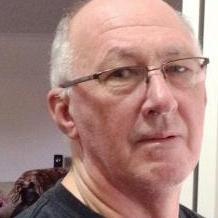
THE MERV RYAN STORY – Courage, Survival and Resilience
Edward Willis replied to Edward Willis's topic in History
Thanks Rob -

THE MERV RYAN STORY – Courage, Survival and Resilience
Edward Willis replied to Edward Willis's topic in History
Thanks John - discovered Merv Ryan's statement to the Australian War Crimes Section team in a file at the National Archives in Melbourne - a real 'eye opener' - I don't think his story has been fully told before. -
Merv Ryan [1] Sporting journalist Ross Elliott headed a story about No. 2 Independent Company veteran Merv Ryan: ‘Hobbling Army mate is not a ghost’ [2]. The reason for him heading the article this way is revealed as the story unfolds: It was February 1942 when the Japanese landed in Portuguese Timor in thousands. To oppose them were 350 [sic] Australian commandos of the 2/2 Independent Company. The Japs swept through the capital Dili and attacked the airfield. Knowing there was no hope of holding the field, a small section covered the retreat of their mates to the hills which was to be the base from which they harassed the Japs for 12 months. Bren gunner Merv Ryan was hit by a hand grenade and his leg shockingly injured. Corporal (later Lieutenant) Kevin Curran gave Ryan a field dressing and also gave him his water bottle. There was little else he could do. Ryan was one of 17 men who were wounded and unable to get away. In one of the first recorded atrocities of WWII, the wounded were shot and bayoneted. At that time all the men were thought to be dead. In 1948 Hawthorn ruck man Kevin Curran won the Simpson Medal as the best player of the match between WA and Victoria at the Subiaco Oval. WA had won the match and as the siren sounded, thousands of delighted local fans swarmed on to the ground. As the weary Curran trudged his way towards the Victorian dressing rooms he was brought up short as a man on a walking stick hobbled towards him. A shaken Curran stammered ‘It must be – but it can’t be’ …… [2] The hobbling man Curran encountered on the oval was his former compatriot, Merv Ryan who two years before this event, in late July 1946, had recorded a more detailed account of how he came to be injured in a sworn statement prepared for the 1st Australian War Crimes Section investigating the ‘Ration Truck Massacre’: STATEMENT BY MERVYN PETER RYAN IN THE MATTER of War Crimes and IN THE MATTER of the shooting of a party of Australian POW at DILI Aerodrome, Timor, during February 1942 I Mervyn Peter RYAN of 11 Federal Street, NORTH COTTESLOE, in the State of Western Australia, formerly WX13624 Private M.P. RYAN of 2/2 Aust Independent Company (AIF), being duly sworn, and say as follows: 1. I arrived with my Unit in Timor on or about 15 December 1941. From the 15 December 1941 I camped with the main group of my unit on the aerodrome at DILI. I was then removed with ‘A’ Platoon to an area known as 'Cactus Camp’ approximately 18 kilometres from DILI. We were stationed there until approximately the first week in February 1942 and then proceeded to relieve No. 1 Section of guard duty on the Aerodrome, where we remained until action started against the Japanese on 19 February 1942. 2. On the night of the 19 February 1942 I went into action with my Company against the Japanese and was wounded in the leg and arm. My mate, Private F. SMITH was also wounded and died later on. I remained lying on the ground for 24 hours. During that time, at approximately 1000 hrs on the morning of the 20 February 42, I happened to see a party of men being escorted by Japanese in front of the hangers our old gun positions. I couldn’t see much as I was fired upon by some Japanese. I was lying on top of a drain when they opened up on me and I rolled over into the drain, which was about six feet deep. I could see, however, that the men being escorted were Australians by their physique and their looks, although I did not recognise any of them. I did not actually see Private AIREY in this part as my visibility was poor and I was lying, on the ground. I only assumed later that AIREY must have been in this party when I heard what had happened from Private ALEXANDER. 3 . After rolling into the drain, where I found Private SMITH dead, I remained there for approximately 8 hours. I then crawled across the road to a seal drain where I must have laid for some time. I was next awakened by the sound of an Army truck, which was an Australian truck bearing a Japanese flag. I hailed for water and a Japanese officer got out of the truck and after interrogating shot me through the shoulder. I collapsed and later on awakening I crawled to a nearby native hut. On the morning of the 23 February 42 I came to again and tried to contact some natives travelling through the area. At approximately 1100 hours I eventually got one native to contact the Portuguese doctors, who arrived about 1300 hours. Travelling with the doctors were Portuguese Police who assisted me by having the doctors attend to me and remove me to the Portuguese hospital. The Japanese interrogated me and other POW in the hospital at DILI, where I remained until April 42. From hospital I went to the prison camp at DILI, where I met up with Private ALEXANDER. 4. The Portuguese Police were held responsible by the Japanese for holding me while I was in hospital at DILI. A Portuguese Police Officer gave me the information that he had been a witness to the burial of approximately 11 or 12 Australian soldiers who were executed by the Japanese on the DILI aerodrome. He could not give me information as to who was responsible for the executions although he tried to find out for me. I did know the name of this officer at the time, but I have now forgotten it. He actually took information from me to the Companies in the hills which can be verified by Private Mervyn WHEATLEY, who was a member of my unit and received information from him. This Portuguese officer had lived in DILI for the best part of his life and was the owner of the Australian Tearooms in DILI which was run up till the time of the invasion when the Japanese took it over. This Portuguese Officer was about 5'10" in height; weight about 10 stone; age about 45 years; could only speak Pidgin English. 5. While I was at the hospital a Portuguese Roman Catholic Priest came to the hospital. The Portuguese Officer referred to above told me that this Priest had said that he had buried 11 or 12 Australian soldiers at DILI aerodrome. This Priest visited me later on when I was still very low in health, but he would not give me any information about the men who were buried. He just refused to tell me anything about the burials because of my sickness. From what the Portuguese Police told me this Priest was a very creditable witness and these Police later brought me very accurate information on other subjects about the Japanese. I saw this Priest about four times while I was at the hospital but only conversed with him the once. The Portuguese Police said that the Priest could not identify the bodies as there were no identification discs and the bodies had suffered from attacks from animals. I did not learn the name of this Priest, but he was a tall man, about 6'; weight about 13 stone; age about 30 years; spoke English very well. 6. While I was in hospital I had a native laundry boy to act as my servant. He told me that he had heard from other natives that a party of men had been executed by the Japanese at the DILI aerodrome. Three of the men he said had escaped and from the description of one who was found dead in a culvert I took this man to be S/Sgt WALKER who was CQMS of 2/2 Independent Coy. I also learned :from this native boy that another soldier had died in a coconut plantation. The third escapee I was given to understand had been treated by natives and returned inland. When I returned to Australia I learned that this man was Pte. HAYES. 7. About two months after I became a POW I met Pte ALEXANDER at the DILI guard camp. He related to me that about 0800 hours on the morning of the 20 February 42 one section of ‘B’ Company [Platoon] who were stationed approximately 20 miles out of DILI on outpost duty were proceeding to DILI in a ration truck for supplies and four hours leave. He told me that he was a member of the party, which numbered approximately 15 men. As the truck was entering a cutting through the hills near DILI I they were surrounded by Japanese who came out of the bush and opened fire on the truck, causing them to stop. The party had no time to return the fire and they were all captured. Pte. ALEXANDER said that no-one was wounded. The Japanese then escorted the truck into DILI. At the DILI aerodrome Pte. ALEXANDER said they were all taken away behind the hangars where he, ALEXANDER, was released from the file and escorted to DILI town where he was interrogated by the Japanese officer there. He said that was the last he saw of the men. Pte. ALEXANDER said he thought the men were being used by the Japanese as a working party. I told him what I knew about a party of men being shot. 8. From April 42 I was a POW at DILI prison camp and then I went to KOEPANG about June 42. Until August the 3rd I was at KOEPANG and then I embarked for Java. SWORN by the said Mervyn Peter RYAN at PERTH in the State of Western Australia this 30th day of August 1946 Before me: G. Neal A Commissioner for taking affidavits in the Supreme Court of Western Australia. [3] Pte. Merv Ryan field tests the showers at Dili drome [4] The Portuguese Dr Mario Borges Olivera who treated Merv Ryan’s wounds at the Lahane hospital also gave a statement to the 1st Australian War Crimes Section: AFFIDAVIT I MARIO BORGES OLIVERA, being duly sworn state: I am a physician of the DILI HOSPITAL and reside at DILI. I am a Portuguese subject and a captain in the Portuguese Army. On 20th February 1942 I was in Dili when the Japanese landed, and I remained in Dilli for four months after the first Japanese occupation. At the time of the Japanese landing there was an Australian civilian named BRYANT living at the Australian Consulate. Mr ROSS was the Australian Consul. I had been treating BRYANT but when I went to visit him to give him an injection, I was prevented from entering the Consulate by the Japanese. Both Mr ROSS and BRYANT were confined to the Consulate and no one was permitted to see them. On the 20th February, a man named DOMING0S SALDANHA, a native, told me there was a wounded Australian soldier lying on the DILI aerodrome. Fighting between the Japanese and the Australians had taken place on the aerodrome. I sent four men to bring the wounded soldier to the hospital. He arrived at about 10 am and I examined him. He was conscious and gave his name as RYAN. He was suffering from a high fever and twenty seven wounds which appeared to have been caused by shrapnel. The soldier was covered in blood. He asked for water and I commenced my treatment of him. The Australian soldier stayed at the hospital for one month. During this time, he recovered and was able to walk. At the end of his months stay in the hospital, a Japanese officer and three Japanese soldiers came to the hospital and took RYAN away together with one Dutch soldier and three Javanese soldiers. All these soldiers had been wounded. The Director-Doctor of the hospital protested to the Japanese officer telling him that the Portuguese were neutral and that the hospital was showing the Red Cross and under International Law, they could not be taken away. The Japanese took no notice and the soldiers were taken away. I do not know what happened to the soldiers and furthermore I do not know of anyone who does know what happened to them. [5] Annotation on rear of photo: Taken January 1942 – One of the carts used to a great extent – L to R – M. Ryan, F. Smith, A. Delbridge. [6] News of Merv Ryan’s survival and capture by the Japanese was relayed to his parents after the No. 2 Independent Company was evacuated from Portuguese Timor: A crumpled note, its pencilled message hardly decipherable, is a cherished possession of Mr. and Mrs. W. Ryan, of Simper Street, Wembley, for it is the last direct link they have with their 20-year-old son Pte. Mervyn Peter Ryan, now a prisoner of war. The note was smuggled out to his mates by Ryan after he had been taken captive. At first he was reported missing; later came advice that he was reported to be a prisoner of war, believed wounded in action. Although he had fallen into enemy hands and was wounded Ryan did hot despair of his freedom. Members of his own guerrilla company also had plans made to effect his escape. A faithful native of the country in which they were fighting was their principal go-between. Partly crippled, he is understood to have been shot later by the enemy as a spy. Ryan's message, addressed to one of his company pals, was as follows: Here's the answer to your note. You will find it hard to read for I have lost the power of my right hand also my right leg. But it won't keep me from having another go at these Japs. I have been in hospital for five weeks now, but I won't be a pris[oner] for I am getting help from your native as you know. Give my regards to all the boys. I have some good information but dangerous to write. See you all in two weeks. Your 'old faith, Merv. ENEMY LANDING Story of Ryan's adventures has been pieced together from scraps of information communicated to his parents by members of his company. Ryan and another West Australian named Smith were out on patrol with a machinegun. They were hidden at a point hear the coast about midnight when they heard the noises made by a party obviously landing in force. At first they had reason to assume these were friends, not foes, but they soon learned to the contrary. It was an enemy landing and Ryan and Smith found themselves in a tight corner. They opened fire and in the exchange of shots Smith was killed by a grenade burst and Ryan wounded in the arm and leg. NEWS AT LAST For two days Ryan was able to lie hidden, thanks to the co-operation of friendly people. A revolver was procured for him and patrols from his company instituted a search for him and for others. A note was got through to Ryan and the message quoted was his reply. The enemy evidently got wind of the rescue attempts before escape plans could be fulfilled. That was the last heard of Ryan until recently when news came that he was well and that his people should not worry. Ryan was well-known in the Brunswick district and was employed there when he enlisted. A younger brother, Private Ronald Patrick Ryan, is serving with an A.I.F. engineering unit. [7] After his repatriation to Australia at the end of the war, Merv Ryan gave more detail about his wartime experiences in a newspaper interview: Wounded badly, in an agony of thirst, and on the point of exhaustion, Private Mervyn Peter Ryan pleaded with a Japanese guard for water. Laughing his request to scorn, the Jap whipped out his revolver and shot him through the shoulder. This was the worst but not the only example of the enemy's inhuman treatment which came the way of Ryan, now home at Shenton Park after being a P.O.W. in Timor, Java and Malaya since late 1941. Ryan, who is 23 and a strapping physical specimen, lost more than four stone during his incarceration. He belonged to the 2/2nd Commandos who landed on Timor shortly before Christmas, 1941. He and the two other members of his gun crew shared the brunt of the fighting when the battle occurred for Dilli drome. One of the trio escaped unwounded, a grenade burst open Ryan's right leg some inches above the ankle, while the third man was severely wounded and died two days afterwards. As the scene of the fighting moved away the two men lay in their 'nest’. With his mate dead Ryan crawled painfully towards the native house. Lack of food and water and the untreated, bleeding wound caused him torture and he had spells of dizziness and coma. It was while he was making this desperate journey that the water incident occurred. He was apparently left for as good as dead. It took him four hours to cover 25 yards. RAW MEAT Near the house he located a kerosene tin half-filled with brackish water, risked drinking it and munched buffalo grass shoots. He awakened from another fainting fit to find himself surrounded by a group of gesticulating natives. These gave him buffalo meat which he sucked raw, water and rice. They then brought Portuguese and native doctors to him and they got permission for him to be taken through the enemy defence lines to the nearby hospital. Here he had to be given intravenously such sustaining liquids as goat's milk. The doctors and natives established communication with his unit which was then engaged in furious fighting with the Japanese in the foothills. He planned an escape but was put in a prison camp. NIGHT RAIDERS One night in May, 1942 a small party of his unit daringly stormed the camp, apparently bent on rescuing him and Peter Alexander, of Kalgoorlie, who was also in the camp. They heard the sound of .303 bullets and a volley of these was fired on to the verandah of their camp hut, the guard being wounded. The whole camp was roused and the Dilli town alarm sounded while Jap infantry moved off with armoured cars and M.G. carriers. They claimed next day to have, shot one of the raiding party. With his leg wound still unhealed Ryan was moved south to Asaper Bessar camp from where, after a spell of hard work, he was sent to Batavia, still having to spend periods in hospital for treatment of his leg and shoulder. Here a number of Australians worked in the gardens and found the food situation greatly improved, but when there came another shift to Singapore the food was scarce and unsuitable, consisting almost exclusively of rice. They crossed to Singapore in a ship carrying 2000 prisoners who were so jammed they had to remain seated for the three-day voyage. TORTURE While working in the Singapore docks area they had a grandstand view of an Allied air raid which burned out the installations. Fires burned for four days. The Japs persistently tried to draw out Ryan regarding our guerrilla operations and were particularly inquisitive to find out why our men persisted in fighting in the interior. Once he was examined along these' lines by a Jap admiral and three generals. They usually had some fiendish torture to accompany these interrogations. Considering the great hardships and suffering he was forced to endure Ryan has made a remarkable recovery. [8] Merv Ryan was in fact much closer to the raiding party than they realised. Here is his account of the raid as experienced as a Jap prisoner: May 15, 1942 - was being held a prisoner of war by the Japanese at Dili. About midnight Peter Alexander and I were asleep in a house with about 30 soldiers of different nationalities, when all of a sudden hell broke loose. We had a window open to let some air into the room. I dived over and closed it so no silly bugger would throw a grenade in. The bullets were really flying around the place. 303s and Tommy guns could well be heard. After about a quarter of an hour the world around us became quite calm until the Nips started to have their say. They sure gave us a headache that night. Peter and I were repeatedly woken up to make sure we had not gone A.W.L. They came and checked us every hour. (Do you think I hated the army then?) The raid certainly worried the little ape men. They raced through the town like mad, bringing anything that would roll on wheels for we could count the carriers and trucks going up and down the road all night long. For a long time after they would patrol at night, so the raid gave them a lot of sleepless nights. May 16, 1942, 5.30 a.m. - We were all made to stand under a big tree and were told by Gorilla Pete that the Australians who made the raid were all wiped out. They produced one hat and one rifle, but we had found out that it was a Jap body, so we all started to laugh. The Japs didn't appreciate our mirth, so they made us face each other and told us to slap each our mate's face. (That Alexander sure can throw a good right). After the show had quietened down I went out the front of the house to have a look. Was I pleased to be behind a 12 inch stone wall in that raid for the verandah was just riddled with bullet holes. I spent a whole day digging out .303 bullets and Tommy gun rounds. [9] Merv Ryan’s parents were unaware of his fate after the report they had received in March 1943, so it was a great relief for them when a photo of him appeared in a newspaper report about released Australian prisoners of war in Singapore at the end of the war: Pte M.P. Ryan pictured in the group published in yesterday's issue of ‘The West Australian’. The first indication that her son, a prisoner of war in Japanese hands since his capture on Timor, was alive and well was when Mrs W. Ryan of 39 Evans Street, Shenton Park, saw his photograph in a group published in yesterday's issue of ‘The West Australian’ under the caption ‘The Australians Enjoy the Situation’. She recognised her son and hurried into this office to see the original print – ‘just to make sure’ she said. He is WX13624 Pte Mervyn Peter Ryan, who was one of the famed Timor guerrillas and a member of the Second Independent Company (commandos). Pte Ryan was wounded at Dilli aerodrome on February 19, 1942 and captured by the Japanese. He was immediately dispatched to a Japanese [Portuguese] hospital where he remained for about five weeks. This information was relayed to his unit by a native messenger who was subsequently shot by the Japanese as a ‘spy’. The next indication of his whereabouts was about five months later when he was located in Java X camp - the news also being received by a native messenger. During his internment his mother received no mail from him. On Monday, however, she was informed by a telegram from the Minister for the Army that Pte Ryan had been reported alive at Tangong Pagar, Singapore, on September 4. However, it was not divulged whether he was in good health. Mrs Ryan saw his likeness for the first time for nearly four years when the photograph was published in ‘The West Australian’. That morning she received a letter from him stating that he would be home in about a fortnight. ‘It is the greatest day in my life’, she said, ‘and I have never felt so excited. I did not know whether he was alive or dead and the photo in the paper dispelled any doubts I had. It was marvellous’. Pte Ryan is 23 years of age and was educated at the Leederville State school. He was born at Goomalling. [10] Merv Ryan’s travails and adventures weren’t concluded at the end of the war as related by Col Doig in this ‘friendly fire’ anecdote about the aftermath of the Association 1947 reunion dinner: Perhaps the highlight of this function was the aftermath. Jack Denman had his car and when the show was over got a few passengers to be delivered in all directions. Merv Ryan was precariously perched on the running board (yes, cars had running boards in 1947) and in swerving to avoid another vehicle coming onto the Causeway, sideswiped Merv on to a light pole, leaving him grounded, slightly bruised only (who ever heard of a drunk getting hurt in a minor accident) and proceeded over the Causeway unaware that one of his precious cargo was adrift on the roadside. [11] Merv Ryan passed away in 1986 aged 64 years: VALE - MERV RYAN With a great depth of sadness we report the passing of a man who put up a grand fight against tremendous odds and finally, after courageously attending the Canberra Safari, succumbed to the almost unbeatable scourge. Merv was an original in our formative days at Foster and was a member of 2 Section, 'A' Platoon, under Gerry McKenzie, his platoon commander, Rolf (Baldy) Baldwin. From the word go Merv made his mark in a very competitive section, the earmarks of a fine soldier apparent from very early days, so it turned out to be. He was tall, athletic, tough, full of humour, very much a man's man who acquitted himself in every possible situation with distinction. He was well liked by every member of the Unit and that continued into post war years. Merv's war years were destined to be served under the yoke of the Japanese for on the night of the 19th February 1942, when 2 Section took the brunt of the Japanese landing, he was badly wounded in close contact with the enemy and that was the last we saw of him until the war ended. The years under the Japanese were torrid indeed, that is putting it mildly, but Merv made of the right stuff, terrible injuries and all, was still in there punching, making his presence felt, as Nippon would well know. For a short while he had Peter Alexander from 7 Section as a mate but that was only temporary. Merv's injuries could not see him moved from Singapore and Peter was sent up to the ‘Railway’. August 1945 saw the Japanese surrender and in its wake came the emotional reunion of families long parted. So it was with Merv who settled back into civilian life easily for he had a tremendous partner in Dulcie, raised a family, worked hard on the wharves at Fremantle and threw in his lot with our 2/2nd Commando Association and he was an invaluable member. He showed the same fortitude post war as he did when a P.O.W., for life was not easy. The injuries received on that fateful night in February 1942 caused untold problems and pain, but he dismissed them all with the well-known Ryan grin. Over all the years Dulcie was a tower of strength to Merv, a wonderful wife and mother, a lovely person. We send our heartfelt sympathy to Dulcie and her family and trust time will in some way heal the great void left by Merv's passing. May God give you and yours strength to face the years ahead with peace of heart and mind being yours in abundance. We will miss Merv so very much, a well-loved mate and comrade. To all with whom he had contact his memory will make these words live for they are indelibly imprinted in our hearts. 'LEST WE FORGET' [12] REFERENCES [1] Cyril Ayris. - All the Bull's men : No. 2 Australian Independent Company (2/2nd Commando Squadron) / Cyril Ayris. - [Perth, W.A.] : 2/2nd Commando Association, 2006: 109. [2] [Newspaper article - Source unknown] [3] ‘Statement by Mervyn Peter Ryan’ in National Archives of Australia: MP742/1, War crimes - Timor Asia (general) : TIMOR 4 - War crimes - Timor Asia (general) [component 1 of 7] 336/1/1724 PART 1. [4] Archie Campbell. - The Double Reds of Timor. - Swanbourne, W.A.: John Burridge Military Antiques, c1995: 33. [5] ‘Affidavit of Dr Mario Borges Olivera, Physician, Dili Hospital (Lahane), Dili, Portuguese Timor, 25th June,1946’ in National Archives of Australia: MP742/1, War crimes - Timor Asia (general) : TIMOR 4 - War crimes - Timor Asia (general) [component 1 of 7] 336/1/1724 PART 1. [6] Source: 2/2 Commando Association of Australia photo archive. [7] ‘Japs thwart escape plan’ Daily News (Perth, WA : 1882 - 1950), Friday 19 March 1943: 7. (http://nla.gov.au/nla.news-page7966930) [8] ‘Wounded man shot when craved water’ Daily News (Perth, WA : 1882 - 1950), Saturday 20 October 1945: 15. (https://trove.nla.gov.au/newspaper/rendition/nla.news-article78481096.txt) [9] A history of the 2nd Independent Company and 2/2 Commando Squadron / compiled by C.D. Doig. - Carlisle, W.A. : Hesperian Press, 2009. [First published: 1986]: 115-116. [10] ‘Son recognised in Singapore picture: WA mother's "greatest day”’ West Australian (Perth, WA : 1879 - 1954), Thursday 20 September 1945: 4. (http://nla.gov.au/nla.news-article51769482) [11] A great fraternity: the story of [the] 2/2nd Commando Association, 1946-1992 / compiled by C.D. Doig. - [Perth, W.A.: C.D. Doig], 1993: 28. [12] ‘Vale - Merv Ryan’ 2/2 Commando Courier vol. 62, August 1986: 7-8. Prepared by Ed Willis 29 June 2021
-
At the end of WWII, ex No. 2 Independent Company soldier George Milsom (TX4141) was promoted to Sergeant and became a member of a three-man team Military History Team that was sent to both Dutch and Portuguese Timor to record significant campaign sites. [1] George was the guide of this team; Lieutenant Charles Bush was the official war artist and sometimes used George as a model and Sergeant Keith Davis the photographer. [2] In Dili they received help from two new criados Fernando and Akiu. George Milsom was an avid letter writer and his parents kept all of his letters. This post features a letter dated 14 January 1946 that he wrote after the Military History Team had completed its patrol to campaign sites at the eastern end of Portuguese Timor. The twelve day patrol travelled through the following locations: Dili, Manatuto, Vemasse, Baucau, Lautem, Lore, Fuiloro and Ossu then back to Dili. Milsom’s narrative of the patrol is complemented by photographer Keith Davis’s photographs of some of the locations visited by the Team. The adventures and social activities of the men and their reliance on the hard working jeep as their mode of transport makes for interesting and entertaining reading. Map 1: Route followed by the Military History Section Team Date DECEMBER 1945 29 Dilli-Manatuto-Baucau 30 Baucau-Lautem 31 Lautem-River Laivai-Baucau-Manatuto JANUARY 1946 1 Manatuto, Baucau, Lautem 2 Lautem 3 Lautem, Fuiloro, Lore 4 Lore, Baucau 5 Baucau, Venilale, Ossu, Viqueque 6 Viqueque, Ossu 7 Ossu 8 Ossu, Mundo Perdido, Venilale, Ossulata Beach, Baucau 9 Baucau, Laleia River, Manatuto, Dilli Table 1: Military History Section Team’s itinerary Ossu, Portuguese Timor. Members of the Military History Field Team and local children in the team's Jeep. Identified, left to right: Sergeant (Sgt) Manuel Da Camara, Portuguese colonial forces; Sgt Keith Davis, Military History Section (MHS), official war photographer; Antonio; Fernando; Lieutenant Charles Bush, MHS, official war artist; George Milsom, MHS; and Akiu, the criado of Arthur Stevenson of Z Special. Dilli 14/1/46 I have not written to you this year and what with all the festivities and running round I have hardly had time to enter all the unusual and amazing experiences in my diary, we shall never forget New Year's Eve and New Years Day. When I write the entry in my diary I found I had put all the happenings in the one day, did not even bother to start a New Year. The QUANZA a Portuguese ship is in port unloading thousands of tons of supplies after which it will go to Fremantle on its return to Lisbon; I hope to send this let or by her. She may go out in about a week. I wish I had some more money to buy things off her; I have a lovely Omega watch and would like to get another but now I am short, there are some beautiful things here too. We cannot even get word to Koepang for some money; I suppose we shall find some way out of it. Cigarettes are pretty plentiful, many different brands and some from South Africa; I'll try to get as many as I can if only for souvenirs. To get back to where I left off in my last letter. We set off for the Eastern end of the island on 29th Dec, this time with a Porto sergeant named Manuel Camara; one big happy jeep-load of four Tuans and three Creadosplus a trailer of gear and food. Had a good trip round a glorious coast road that sometimes ran over salt pans, then round a cliff high above the sea and in places the roadway was built up over the sea. We climbed a range where the road was just a ledge cut into the steep side of the mountain. SUBAO GRANDE, PORTUGUESE TIMOR. 1945-12-29. SPARSELY WOODED HILLSIDES LEADING DOWN TO THE SEA BESIDE THE DILI TO MANATUTO ROAD. (PHOTOGRAPHER SGT K. B. DAVIS ) We forded some rivers and crossed others on Japanese constructed bridges. Had a nice lunch at MANATUTO and later pushed on to BAUCAU. Encountered very heavy rain at VERMASSE and the road became sticky, especially over the BAUCAU plateau. This town is the next largest to DILI but has been mauled and bombed till almost beyond repair. Somehow the Portos have things going again and are living in patched houses. We stayed a right there and went on to LAUTEM next day (Sunday). There we found the Administrator Senhor GONSALVES sitting on the verandah of a house that the Japs had built and used for their HQ. He is a big chap, big-hearted, and welcomed us with VINHO DA PORTO. Lautem, Portuguese Timor. Senhor Gonsalves seated on the verandah of a mud house built by the Japanese. VX128043 Charles William Bush (in shorts) Military History Section (MHS), an Official War Artist, is working at an easel. Also identified (far right, back to camera) is TX4141 George James Beedham Milsom, MHS. He has gathered round him all the Japanese junk from the area, broken down bombers and small motor cars; I have never seen such a collection before. We slept in Japanese beds with sheets and mosquito nets and had hot bathe in the concrete bath the Japs had built. Then we went to the airfield and you should see the wrecked planes, all in the most fantastic angles and positions, you will have to see the photo to believe it. LAUTEM, PORTUGUESE TIMOR. 1946-01-02. THIS JAPANESE TWIN ENGINED AIRCRAFT WAS PROBABLY DESTROYED BY THEM AT THE END OF THE WAR. (PHOTOGRAPHER SGT K. B. DAVIS) We did not run short of petrol there because there is a dump of 56,000 44 gallon drums there. The Administrator has trucks, cars and hundreds of bicycles. One shed he has is full of gear, one wall was covered with chiming clocks. He gave us some souvenirs. The junk heap was even able to supply us with two wheels for the jeep. LAUTEM, PORTUGUESE TIMOR. 1946-01-02. DAMAGED BICYCLES IN THE LAUTEM AREA WHERE THE JAPANESE MAINTAINED THEIR LARGEST DUMPS OF PETROL, EQUIPMENT AND STORES. THEY DESTROYED MUCH OF THIS MATERIAL AND MANY AIRCRAFT AT THE NEARBY AIRFIELD AT THE END OF THE WAR. (PHOTOGRAPHER SGT K. B. DAVIS) After staying the night and deciding to go on to LORE on 31st the Administrator said, ‘Would you like to go to the New Year Festival and Dance at MANATUTO?’ We accepted, and here the fun commenced. We left LAUTEM and had a good 11/2 hours run to BAUCAU, had afternoon tea, and continued on our way to MANATUTO. At the VEMASSE river we found the river swollen with muddy water and impossible to cross so decided to wait rather than go back and after about two hours the water had gone down a fair bit. Although it was 8 p.m. and dark I decided to give the jeep a go at the crossing, so I put it into low ratio four wheel drive and ventured forth. She went well till we got about three parts of the way over, then the front wheels went into a hole, the engine gave a choke and conked out. By this time the water was rushing in a torrent straight through the jeep over the seats and even with the glove-box. The rush of water moved the jeep downstream a few yards, so we climbed out and got a mob of natives to push us over. The head and tail lights still burned and I had previously connected the trouble lamp. When on dry land we pulled the plugs out, drained away the mud and water, gave the engine a kick over to empty the exhaust and silencer, and started up and went on to the LALEILA river to have a repeat performance. We reached MANATUTO just as everyone was finishing the dinner and setting off to the dance. As we were wet through and so was our change of clothes we had a bath and managed to borrow a change of clothes; I had a pair of grey trousers and a safari jacket belonging to the Administrator. Then we had a meal and set off to the dance. It was marvellous. A long shed had been especially constructed by the natives and gaily decorated inside and out. It was lighted with Chinese lanterns and in the centre was a raised platform for an orchestra supplied by BARTOLOMEO DIAZ. At the end of the stand was a drink bar with wine, brandy, a native cocktail, and ‘TUAKA’. I think I tried them all. It was not long before I was dancing round in a ring with the INTENDANT of BAUCAU and three CHEFES DA POSTO teaching them to sing ‘She'll be coming round the mountain when she comes’. This amazed the crowd because an INTENDANT is rather a high official; he is one of the Governor's aides. Well it’s the first time I have ever danced until eight in the morning. There were very few white girls there, but I danced with them all and many Timor girls. LAUTEM, PORTUGUESE TIMOR. 1946-01-02. A WOODEN JAPANESE SIGNPOST WITH EMPTY PETROL DRUMS AND MOBILE ANTI-AIRCRAFT GUNS IN THE BACKGROUND. We picked up the dances easily, they are very similar to ours. Charles and Keith faded out about 4 a.m. but everyone who had gone to sleep was awakened by the drums and parade round the houses; about 2000 natives and others went in a long crocodile and I took over the drum for a while, it was all great fun and seemed unreal. ‘FLEIZ ANNO NOVA’ end ‘FLIEIZ NATAL’ will always remain in my memory. At 11 a.m. we set out on our return journey pretty weary. WE had a good lunch at BAUCAU but then we got to the MALAI River that was in flood, so we had to wait again and with a number of natives built a roadway over the deepest part and: crossed over o.k. Had a good dinner at LAUTEM and went to bed and did very little their next day except to get the jeep ready to go on to LORE. Having got it ready it refused to start until I had taken out the plugs and cleaned them. We had a good lunch at FUILORO and arrived at LORE at four p.m. We were shown a crashed HUDSON bomber in which six Australians had lost their lives; the wreckage was fenced in by the natives. [3] The most peculiar thing we saw was some Jap defences on the beach below LORE; the Japs had put small sharp bamboo stakes up in the sand, thousands of them inclined towards the sea and they evidently anticipated a landing. Also on the LAUTEM plateau was a similar sight, thousands of sharp bamboo stakes about 7 or 8 feet long pointing straight up as a defence against para troops. LAUTEM PLAIN, PORTUGUESE TIMOR. 1946-01-04. LIEUTENANT BUSH, OFFICIAL ARTIST, AND SERGEANT MILSOM, MILITARY HISTORY FIELD TEAM, EXAMINING ONE OF THE SHARPENED BAMBOO STAKES THE JAPANESE PLACED ON THE PLAINS AND OPEN SPACES THEY THOUGHT SUITABLE FOR ALLIED PARACHUTE LANDINGS. (PHOTOGRAPHER SGT K. B. DAVIS) We left LORE at 2 p.m. and went back to BAUCAU. Our original plan was to go down the coast from LORE to VIQUEQUE but owing to rains the CHINO river was swollen. At OSSU we picked up the CHEFE DA POSTO and took him to VIQUEQUE where we stayed a night. Next day we tried to get up the coast to HATOLARE, but another big river stopped us (the BEVAI) - it is not marked on my map. We had some fun when the jeep fell through a small bridge, but we managed to lever it out and carry on as usual. Stayed two nights at OSSU which to my mind is the prettiest and best located place on the island. The surrounding mountains LAURTINE and MUNDO PERDIDO present a glorious sight, especially at sunrise and sunset. The CHEFE DA POSTO at OSSU is very young and full of life and we had a great time there. OSSU, PORTUGUESE TIMOR. 1946-01-07. AUSTRALIANS OF SPARROW FORCE USED THIS HOUSE AS HEADQUARTERS WHEN OCCUPYING THE TOWN IN 1942. (PHOTOGRAPHER SGT K. B. DAVIS) When we reached BAUCAU on the 8th we learned that the big bridge over the LALIELA River had a span torn out by the flood and that it was impossible to get through, so we spent another night at BAUCAU. Next morning we started out at 5 a.m. arriving at LALIELA at 7. Viewed the bridge and river with doubt, took some photos of the bridge, had a breakfast of pineapple. The latter event attracted such a crowd of natives that it gave me courage to give the river bed a go. It was about 200 yards across and for the third time we plunged into a volume of dirty water of unknown depth. We got completely stuck in some sand but about 50 yelling natives made light work of getting us across. The water did not come up to the glove box this time. When we got across the natives shouted with delight, so we gave them a 5 pataca note to split up amongst them. How they were going to do that would keep them occupied for the next fortnight I should think. That proved to be the last obstacle and we arrived in DILI for a late lunch. That night we went aboard the QUANZA had some beer in both lounges, had a look at what the bar tenders had to offer and came off the ship each with a nice new watch. Thursday night we went to a party at the HQ Sergeant's mess, more VINHO and VIVA PORTUGAL and singing. We were properly tired that night. On Friday night we went to the Officers' mess where we had another marvellous dinner with iced LAURENTINA beer from Africa. The best thing was the African soldiers' orchestra which played to us all night, lovely music with soft rhythm and many popular tunes. We have been feted so much that we shall have to go to AINARO in a few days for a holiday. Saturday night we went to a concert party put on by the artillery unit, it was very good and even if we did laugh in the wrong places we provided amusement for all. Must now go and post this on board the QUANZA. ACKNOWLEDGEMENT: Thank you to Liz Milsom (George Milsom’s daughter) for making George’s correspondence available for publication. REFERENCES [1] ‘George James Beedham Milsom’ https://doublereds.org.au/history/men-of-the-22/tx/george-james-beedham-milsom-r364/ [2] See Ed Willis ‘75 Years on - Art and photographs in the Australian War Memorial Collection related to the campaign in Portuguese Timor – Charles Bush and Keith Davis’ https://doublereds.org.au/forums/topic/108-75-years-on-art-and-photographs-in-the-australian-war-memorial-collection-related-to-the-campaign-in-portuguese-timor-–-charles-bush-and-keith-davis/?tab=comments#comment-172 [3] Milsom is referring to Royal Australian Air Force (RAAF) 13 Squadron Hudson bomber A16-166 that was shot down by Japanese fighters off Cape Lore while flying in support of an air raid on ships at Nova Ancora. All five [not six] crew members were killed in action. See David Vincent. – The RAAF Hudson story – book two. – Highbury, SA: Vincent Aviation Publications, 2010: 90-91.
-
Perth-based members and supporters of the 2/2 Commando Association of Australia are encouraged to visit an upcoming exhibition at the Wireless Hill Museum, Yagan Mia Wireless Hill Park, 1 Telefunken Drive, Ardross WA 6153. The centre piece of the exhibition will be a 3D textile version of ‘Winnie the War Winner’ created by Sandy Mack whose father was original unit member Terry Paull (WX12340). Sandy’s representation of the iconic radio set is remarkable and should provide quite a conversation piece and draw card for the exhibition. Full details regarding the location of the Museum and the dates and times for the exhibition can be found at: https://www.melvillecity.com.au/things-to-do/museums-arts-and-culture/wireless-hill-museum
-
Dear Ken: See the Doublereds entry for your uncle linked below that includes details of the medals he was entitled to - let me know if you need any additional information. Harvey's service record can also be downloaded from: https://recordsearch.naa.gov.au/SearchNRetrieve/Interface/DetailsReports/ItemDetail.aspx?Barcode=6468894&isAv=N Regards Ed Willis President, 2/2 Commando Association of Australia
-
WWII in East Timor – A Site and Travel Guide LIQUIÇÁ MUNICIPALITY MAUBARA 8° 36' 42.98" S 125° 12' 22.00" E Maubara is 26 miles (42 km.) from Dili at a bearing of 262°. This small posto and market town is situated on the north coast and at the terminus of the coast road. The posto itself is constructed on a knoll with its usual administrative and auxiliary buildings. Several buildings were destroyed by floods during 1939. Other buildings are church, school, and residences, most of which are built of stone with galvanized iron roofing. There is an anchorage on the open beach of Maubara. [1] Map of Maubara The town of Maubara is situated by the sea on a narrow frontage, with the core of the town extending inland towards the hills behind, bounded on the eastern side by the Rio Bahonu and a smaller stream on the west. Callinan was not as impressed with Maubara as he was with Liquiçá: "We did not remain long in Liquissa, but drove on to Maubara, located at the end of the road-and indeed it looked like it! The buildings were dilapidated, and the inhabitants were few. A couple of us walked into the only open building we could see and found it to be a Chinese shop. The occupants were distressed to see such martial figures and insisted on producing coffee and cakes whilst an old man told me how very old and ill he was, and that the only other occupants were women and children, flocks of whom were produced for our inspection. Feeling very embarrassed, we beat a retreat as soon as courtesy permitted after the refreshments". [2] In February 1942 the Dutch contingent stored rations and ammunition at the posto and school in the town as a transition base for their withdrawal by sea to Dutch Timor in anticipation of the arrival of the Portuguese reinforcements. [3] Escola do Padre Medeiros (Father Medeiros’ School) where the Dutch stored rations and ammunition – photo taken 18 April 2014 Despite Callinan’s reservations about the attractiveness of the town it features affectionately in one of the longest anecdotes in his book related to Bols gin, one of the rations stored at the posto: "One of our patrols which was around to the north of Ermera heard of a supply of Dutch stores at Maubara on the north coast. These had been placed there prior to the Japanese landing with the intention of moving them by barges into Dutch Timor. Our interest in the stores was increased when it was learnt that amongst them was some Bols gin, which was normally an issue with the R.N.E.I.A. After the Japanese landing the Chefe de Posto had moved the stores to his posto and sent an inventory to the Governor. The Japanese had visited the town but once, and had not searched the posto, so that the stores were still intact, but the Chefe de Posto, a most conscientious and good man, would not part with the stores without the authority of the Governor. Earlier there had been a misunderstanding between the Chefe de Posto and one of our troops, but this was smoothed over very well by Sousa Santos. Shortly afterwards, through Sousa Santos, I received a letter from the Governor stating that the stores were available and that I could collect them provided I gave a receipt for all the goods received. I was only too willing to supply a receipt, and the next day 200 natives left Bobonaro to skirt around the enemy and collect the stores from Maubara. Within a week they were back with sixty-seven cases of Bols gin-twelve bottles to the case. There were some other stores, but they were of little importance compared with the gin. We sent a case of gin back to the Chefe de Posto at Maubara, expressing our appreciation of his probity and courtesy, and another case went to the Governor. These gifts were entirely unofficial and, of course, were not acknowledged, but were probably enjoyed none the less. One case went to the Dutch headquarters, and gifts were sent to various good friends amongst the Portuguese. The remainder was distributed to the platoons. I do not think any of us really drank much gin in normal times, but I thoroughly enjoyed neat Bols gin out of pannikins of all shapes, sizes and materials. It provided a very welcome break for the whole company, and we lived in the memories and stories of that issue for a long time”. [4] Maubara Posto The posto at Maubara referred to by Callinan is one of the classics of its type. Sited south of the town it overlooks, in a dominant hillside position on the eastern bank of the Rio Bahonu it provides expansive views along the coast to the east and west and inland to the hills behind. Built in the late 1890s at the direction of Governor Celestino da Silva it was one of the network of military posts intended to provide for the effective colonial occupation of Portuguese Timor. The Maubara stronghold represented a particular case, as it was a Dutch heritage, consisting of a solid stone and lime construction with a circular shape, with a European-style “good house” for the commander, a barracks for an inferior officer and another, in Timorese style, for 30 soldiers. [5] "Naturally, the effectiveness of a military network depends on the interconnection of the units that comprise it. In view of the difficulties in establishing an effective road network, Celestino da Silva bet on a telephone network connecting the main towns, whose assembly would be in charge of the postal and telegraph service section of the public works division. In 1900, the first town to be linked to the capital was Maubara, later connecting to Batugadé, and branching to Boibau, Bobonaro, Aileu, Maubisse, Same, Lacló, Manatuto, Laclubar and Viqueque, arriving in Lautém in the last year of Celestino's government". [6] Casa e dependências do posto civil – Maubara, Timor 1925 [7] The posto underwent extensive renovation during 2012-2015 financed by Portuguese government under the Mós Bele Program to transform it into boutique hotel for tourists. It then lay unoccupied for several years, but in December 2020 the keys to the rehabilitated building were ‘handed over to the Ministry of Tourism, Commerce and Industry of Timor-Leste, the competent authority for the steps leading to the future concession of the building for the purpose of tourist exploitation’. [8] Maubara Fort The grey-walled fort that dominates the seafront here is of Dutch rather than Portuguese origin and dates from the mid-18th century. The Dutch had an active interest in Maubara at this time as a prime site for coffee cultivation and introduced it to the island here and at Liquiçá from whence it gradually spread elsewhere to become the important cash crop it is today. Dutch interest in the enclave waned over time and it was ceded to Portugal as part-payment part for a larger territorial deal finally concluded in 1861. [9] Several large shady trees shelter the expansive rectangular interior of the fort that is leaf-littered and weedy bare earth apart from a single centrally located modern building. Two old cannons are aimed seawards from bastions at either end of the northern wall. Rustic and neglected wooden gates provide access to the fort from the north and south; they are installed in arches that stand taller than the walls. [10] MAUBARA, PORTUGUESE TIMOR. 1946-01-29. THE OLD STONE … FORT. AUSTRALIANS OF SPARROW FORCE PASSED THROUGH THIS AREA ON SEVERAL OCCASIONS DURING 1942. (PHOTOGRAPHER SGT K. B. DAVIS). [11] Maubara Fort – photo taken 26 April 2014 Portuguese Internment Zone at Maubara In late October 1942, the Portuguese Governor reluctantly accepted the Japanese edict regarding ‘protective concentration’ and encouraged all Portuguese residents to move to ‘internment’ areas at Liquiçá, Maubara and the nearby hill village of Bazar Tete – this was deemed necessary for protection against the ‘rebeliões de indígenas (rebellious Timorese)’. Initially, the protection zone comprised the entire part of the coast stretching from Liquiçá to the mouth of the Lois River with people encouraged to gather in the towns of Liquiçá and Maubara. However, earlier on, several families stayed in the immediate vicinity where they were better able to cultivate subsistence crops. That situation changed quickly, with constant intimidation and confrontations with the ‘colunas negros’ (black columns). In May 1943, members of the Portuguese military detachment in Maubara were disarmed and demobilised. In the town, some internees still managed to maintain small vegetable gardens. Gradually, through more or less indirect pressure, the Japanese were also urging Timorese to stop selling their produce in weekly markets. Anxieties were further increased by sporadic Allied bombing and strafing attacks that sometimes caused Portuguese and Timorese casualties. In September 1944, without warning, the Japanese ordered the transfer of the approximately 200 people based in Maubara to Liquiçá, further undermining living conditions for the internees. [12] Monument to José Nunes, the Loyal Regulo of Maubara Departing the southern gate of the fort, in front of the grounds of the primary school there is a significant Portuguese monument; the plaque on this monument bears the inscription: ‘Homenagem do Governo de Timor au seu mui fiel regulo de Maubara José Nunes (1874-1952)’. In mid-November 1943, Maubara was defended from attacks by rebellious warriors from Balibó, Cailaco and Atabai by local men led by the loyal liurai José Nunes and his son Gaspar, who supported a small Portuguese detachment of indigenous soldiers. [13] Rui Brito da Fonseca has provided this description of the monument: "D. Jose was always faithful to the Portuguese, so his camp deserved the confidence of carrying out guard of honour to the Governor. I still remember in memory the impressive parade of the Cavalry of Maubara, commanded by the imposing D. Gaspar, son of Jose Nunes, accompanied by his principals, when Governor Alves Aldeia arrived in Portugal on the 20th of March April 1974. He was considered a hero in the Manufahi War in 1913. He helped the Portuguese in such a way when, from the end of 1942, they were confined to the Protection Zone of Maubara and Liquiçá, that many, undoubtedly, owed him for their survival". Monumento fúnebre do liurai José Nunes – photograph taken 26 April 2018 "At the end of the conflict and the Japanese expelled, the governor wanted to publicly show his recognition by granting the honour of being himself the first liurai to fly the Portuguese flag outside Dili, thus beginning the reception of the term by the Portuguese administrative authorities. It is said that, on a certain occasion during the Japanese occupation, some Japanese officials, on the birthday of the Emperor, invited D. Jose Nunes to propose a toast to the Great Japanese Empire, to which he acceded. Soon after, he asked for the floor and, tell the storytellers, that the assembly trembled in fear of what the liurai might say, such was his unbelievable spirit. Then, Jose Nunes, raised his glass, getting cold silence and in his gentle authority he said: - I toast Portugal, which is even greater! As an old man, he expressed to the Government that his greatest desire was to be buried under the shadow of the national flag that he knew. Years later, his will was done, and he was buried in a monument whose shade shadows his grave and the representation of the flag he served. This monument inspired a whole series of funerary monuments in the centre of the neighbouring villages with the rolled-up cover, symbolising the flag in which he believed in life". [14] MAUBARA, PORTUGUESE TIMOR. 1946-01-29. KING NUNIS OF MAUBARA WHO ORGANISED AN ANTI 5TH COLUMN CAMPAIGN AMONG HIS NATIVES. THE AUSTRALIANS OF SPARROW FORCE FOUGHT SEVERAL ACTIONS AGAINST JAPANESE SYMPATHISERS AND WERE AIDED BY LOCAL LEADERS LIKE KING NUNIS WHO REMAINED LOYAL TO THE PORTUGUESE. (PHOTOGRAPHER SGT K. B. DAVIS) [?] REFERENCES [1] Area study of Portuguese Timor: 27-28. [2] Callinan, Bernard. - Independent Company : the Australian Army in Portuguese Timor 1941-43. - Richmond, Vic.: Heinemann, 1984.: 23. [3] J.J. Nortier ‘De bezetting van Dilly, Portugees Timor: geallieerd initiatief in de eerste weken van de oorlog tegen Japan [The occupation of Dilly, Portuguese Timor: Allied initiative in the first weeks of the war against Japan]’ Ons Leger 63 September 1979: 49-60. [4] Callinan, Bernard. - Independent Company : the Australian Army in Portuguese Timor 1941-43. - Richmond, Vic. : Heinemann, 1984: 119-120. [5] Isabel Boavida ‘Celestino da Silva, a rede de postos militares e a ocupação colonial efetiva de Timor português (1895–1905): Um processo (des)construtivo’ [Celestino da Silva, the network of military posts and the effective colonial occupation of Portuguese Timor (1895–1905): A (de) constructive process] Journal of Asian History, Vol. 48, No. 2 (2014): 249. [6] Boavida: 255. [7] https://www.archives.gov.mo/webas/ArchiveDetail2016.aspx?id=58081 [8] Timor-Leste: Delivery of Pousada de Maubara (https://www.instituto-camoes.pt/sobre/comunicacao/noticias/timor-leste-entrega-da-pousada-de-maubara) [9] W.G. Clarence-Smith “Planters and smallholders in Portuguese Timor: the nineteenth and twentieth centuries” Indonesia Circle no. 57, 1992: 15-30. [10] See also Steve Farram ‘The Maubara fort, a relic of eighteenth-century local autonomy and Dutch-Portuguese rivalry on Timor’ Journal of Southeast Asian Studies 50 (2) May 2019: 263–287. [11] AWM 125217 [12] See Manuel de Abreu Ferreira de Carvalho. - Relatório dos acontecimentos de Timor (1942-45) [Report of Timorese events (194245)]. - Lisboa: Edições Cosmos, 2003: 406-412, Antonio de Oliveira Liberato. - Os japoneses estiveram em Timor [The Japanese were in Timor]. - Lisboa: Empresa Nacional da Publicade, 1951: ‘A Zona De Concentração’, 153-208, and Jose Duarte Santa. - Australianos e japoneses em Timor na II Guerra Mundial, 1941-1945 [Australians and Japanese in Timor in the Second World War, 1941-1945]. - Lisboa: Noticias, 1997 for the most detailed account. [13] Rocha, Carlos Vieira da. - Timor: ocupação japonesa durante a Segunda Guerra Mundial (2a. ed. rev. e ampliada). Sociedade Histórica da Independência de Portugal, Lisboa, 1996: 107. [14] Rui Brito da Fonseca. - Monumentos portugueses em Timor-Leste. - Dili, Timor Leste : [Crocodilo Azul?], 2005: 52-53. [15] AWM 12516.
-
‘The RAAF boys who fell out of the sky’. Sgt John Jones with (mounted) RAAF Sgt Webb and Flying Officer Gabb. [1] Introduction No. 31 Squadron was formed on the 14th August 1942. It was to be a long range fighter squadron equipped with Beaufighter aircraft, the first of which was received on the 23rd August 1942. The arrival of the squadron at Batchelor in the Northern Territory on the 27th October improved the RAAF’s fighting potentialities in North Western Area. After a few weeks of intensive training and familiarisation flights, No. 31 Squadron moved to its operational base at Coomalie Creek on the 12th November. Beaufighters, later to be known to the Japanese as “whispering death”, joined the offensive for the first time during the early hours of the 17th November, when two flights of three aircraft each strafed Maubisse and Bobonaro in Portuguese Timor. At this time the RAAF were implementing a policy of bombing and strafing hostile Timorese concentrations in Timor and encouraging resistance to the Japanese authorities. This policy was translated into action by the combination of Hudson and Beaufighter attacks daily stepping up the number of sorties in Portuguese Timor, culminating on the 26th November in the biggest RAAF operation in this theatre to date, when, ten Hudsons and six Beaufighters from No. 31 Squadron bombed and strafed Hatolia and Beco districts, starting a number of fires in the villages of Nova Lusa and Beco. In the first two weeks of operations, the Squadron had recorded 53 sorties into enemy territory, the majority of which were strafing attacks. The targets for all these operations were identified and ‘called in’ by Lancer Force HQ on the ground in Timor. Line up of Beaufighters, Coomalie Creek, 1942 Callinan, by then commanding officer of Lancer Force, previewed the circumstances relevant to the topic of this story: Meanwhile, the Japanese had driven down and occupied Same in strength and had established a camp at Betano with approximately 300 troops. This was most disconcerting, as from there they were pushing eastward, and had already established daily patrols past the Quelan River area which had been used for the evacuation of the 2/2 Company and the Dutch". [2] The No. 31 Squadron attack on the Japanese camp at Betano that was initiated in response to the threat just described by Callinan. Shot Down at Betano Operation Coomalie 43 of December 29th, 1942 was a strafing attack directed at huts in the vicinity of the near coastal village of Betano, on the south coast of Portuguese Timor, just to the east of the mouth of the Sue River, by four Beaufighters of Number 31 Squadron, Coomalie Creek. Of the four planes that made up Coomalie 43 – one (COO 434) turned back around an hour after take-off due to failure of that aircraft’s intercom and WT equipment; the remaining three planes continued on to the target, through at times very poor weather. After eventually locating the target at 2:20 pm, COO 431 commenced their first pass followed by COO 433 and then COO 432 crewed by Pilot Officer Glen Gabb, (21) and Observer/Navigator Sergeant David Webb (22). COO 432 followed COO 433 in the first run over the target, flying in northerly course at 100 feet height, fired three bursts of cannon and machine gun at some native huts. COO 432 finished this run by turning to the west and is was then that Webb observed the tail fin smashed by fire either from a mortar or Oerlikon gun (he saw a red ball go through tail of aircraft) – the aircraft was also holed in several places in the tail and the port motor cut out. Remnant of an Oerlikon gun from the wreck of HMAS Voyager. [3] No. 4 Independent Company veteran Rex Lipman states that the Japanese had salvaged the anti-aircraft guns from the Voyager and used them against the Beaufighters involved in the action described here [4] Gabb then turned the aircraft in an easterly course, and Webb threw out propaganda pamphlets as instructed. The Pilot was unable to maintain height or speed, and after crossing the Quelan River headed the aircraft out to sea. At this time the speed had decreased to 100 knots and the temperature of the starboard engine had increased to 280° and the controls were acting erratically. Gabb then crashed landed on the sea about a quarter of a mile out to sea off Cape Mati Boot. The tail of the aircraft hit the water first and then the engines – the crew had braced themselves for this crash, Gabb also had moved the gun sight out of the way, and the men quickly escaped through the two top hatches. They climbed onto the wings which were then waist deep, and then swam to the shore. The Beaufighter sank in about 20 seconds, the front going down first followed by the tail – it is estimated that the aircraft sank in 15 metres of water, at low tide about a 200 metres off the shore near Cape Mati Boot. [5] [5] Given the fairly precise description of the location of the crash site, the wreck of this Beaufighter should be able to be located. Gabb and Webb Become Temporary Commandos The story is taken up again by Callinan: Then, from company headquarters, came the message that two Australian airmen were with the section posted above Alas. This was rather surprising, as we had not been informed that a plane was missing. Eventually the two men reached us, Pilot Officer Gabb and Flight Sergeant Webb; they had been the crew of a Beaufighter that had strafed the Japanese company at Betano. As they-swept over at tree top height, the Japanese had opened up with everything, and as far as one could judge their tail had been blown off by a mortar bomb. The pilot had managed to get the plane down in the sea a little to the east of Betano. Then, making slow progress they managed to cross unwittingly and without being observed an area subject to regular Japanese patrols. Then by good observation of scraps of evidence carelessly left by the evacuated (Australian) troops they got on to a track that led them towards Alas. They were fortunate enough to meet a native who willingly gave them some food and directed them towards the Australian position. These were great fellows and we were pleased to have them at headquarters. They were new faces with new ideas, and we learned from them not a little about the air side of the picture. Also from then on Australia received improved meteorological reports because we gave that duty to Webb who had attended a RMF school in the subject. We were also pleased to get these airmen as they augmented our guard list. Such was our lack of manpower that everybody on HQ staff from myself and Baldwin down did our turn on guard. And now with two additional men it meant that every third or fourth night a couple of us could get a full night's rest. They entered into the spirit of the show very quickly and were most adaptable. [6] Evacuated To Australia With Lancer Force Gabb and Webb’s sojourn with commandos was short lived as their arrival coincided with the decision to evacuate Lancer Force to Australia. The Force’s position had become untenable in the face of increasing Japanese territorial pressure in conjunction with their Timorese allies. The formerly used landing and evacuation sites at Betano and the mouth of the Quelan River could not be used, so an even less desirable location further east at Quicras was selected. The two men staged with Force HQ over three days from Belulic to Fatu Berliu (Nova Anadia) then Cledec to the coastal village of Quicras (Clacoc). Map of the Gabb and Webb's travels on Timor On the morning of the 9th January 1943 Lancer Force (now concentrated except for a detachment at Ainaro from whom there was still no word) set out with 50 Portuguese (all they could take of over 100 who had asked to go with them) on the last stage of their journey—over open grass country. It was raining heavily. The rivers between them and Quicras might flood and block them. They had to hurry. Soon after they started a Zero fighter suddenly appeared about 1,000 feet above them. They were afraid it would pick them up, but the pilot apparently noticed nothing. The afternoon march led through swamps, often up to a man's chest. The going beneath the surface was slippery with mud and twisted mangrove roots. But by 5 p.m. the whole party was in the bush which fringed the beach. Exactly at midnight recognition lights from the sea answered the signal fires. The surf was heavy. Boats sent inshore from a destroyer—the HMAS Arunta —were swamped. Time was running out. A few strong swimmers swam out beyond the broken water but reported this manifestly too difficult for most. At last, however, through great efforts, the whole group was ferried on board. The sailors were very kind to them. Most of the soldiers were so tired they slept almost all the way to Darwin where they landed on 10 January 1943. Both Gabb and Webb had caught malaria and were hospitalised for several weeks before being fit enough to rejoin their comrades at 31 Squadron. References [1] Rex J. Lipman. - Luck's been a lady. – Adelaide: [The Author], 2000: 87. [2] Bernard Callinan. - Independent Company : the Australian Army in Portuguese Timor 1941-43 / introduction by Nevil Shute. - Richmond, Vic. : Heinemann, 1984: 206. [3] Photographed in Same side street, 1 May 2018. [4] Rex J. Lipman. - Luck's been a lady. – Adelaide: [The Author], 2000: 87. [5] Given the fairly precise description of the location of the crash site, the wreck of this Beaufighter should be able to be located. The narrative of the attack and crash landing has been adapted from Garry Shepherdson ‘The losses of Coomalie 43: it could have been a lot worse’ ADF Serials Telegraph News 7 (2) Autumn 2017: 28-33. (http://www.adf-gallery.com.au/newsletter/ADF%20Telegraph%202017%20Autumn.pdf) [6] Callinan: 209-210.
-
INTRODUCTION It is the 79th anniversary of the Japanese assault on Dili (February 19-20 1942) that began the almost year long Australian commando campaign against the occupying enemy in, then, Portuguese Timor. The earliest account of the history of the campaign was written by Bernard Callinan and titled Independent Company and published in October 1953. The book was reprinted in 1984 and is widely regarded as one of the best of the personal WWII campaign histories genre. Back in 1966 he gave an insightful address to engineering undergraduates at the University of Melbourne (his alma mater) in which he explained how the book came to be written. Callinan developed several ‘threads’ in his explanation with the primary one being ‘therapy’ in reaction to ‘the strain of waging a war against an always greatly superior enemy, and of being dependent for our existence upon a large all-pervading population’. He states that ‘We learnt to live with the strain, but there was a pronounced reaction when we were brought back to Australia’. He goes on to say: ‘Another strand for the thread lies in our success. We had been successful. MacArthur and others had told us so, but much more we knew it; and we knew we had been successful where others had failed - in fact where all others had failed. No other allied troops between the Philippines, Burma, Malaya and Java had met the enemy and survived. We had killed some fifteen hundred enemy for our own loss of less than fifty but, very much more importantly, throughout it all we had remained a cohesive, aggressive fighting force’. ‘Another strand was the desire to get accuracy to the story. I think I am not unusual because I find the part truth difficult to deal with and trying to the patience. This story was front page news when it was released from censorship, many versions sprang up and the emphases were sometimes on the wrong aspects. I wanted to record my version of the true story’. And finally this tribute: ‘After the Japanese landed there were a few weeks of doubt, but from then on, the Timorese became our supporters and loyal friends. They looked after our wounded, they buried our dead, they fed and housed us’. Over the months I moved, often unaccompanied, along our 60 mile front and I never hesitated to walk into a strange village, ask them to feed me and then lie down and sleep amongst them in a hut. They could have cut my throat without hindrance if they had wished’. Bernard Callinan was a Captain and second in command of the No. 2 Independent Company on their arrival in Timor and subsequently took over as Officer Commanding in May 1942 with the rank of Major. In November 1942 he was given command of Sparrow Force at the time it was renamed Lancer Force after being reinforced by the No. 4 Independent Company. Callinan was a peripatetic commander and travelled frequently and extensively visiting the dispersed locations occupied by the Australians. The book reveals that he was an acute observer of the people, terrain and localities over which the campaign was conducted and recorded what he saw with considerable insight and self-deprecating humour. Given Timor’s underdevelopment, especially away from Dili, many of the scenes he describes in his book are still recognisable today. Talk To Fourth Year Electrical And Chemical Engineering Under-Graduates WHY I WROTE ‘INDEPENDENT COMPANY’ Bernard Callinan UNIVERSITY OF MELBOURNE, FRIDAY, 1st APRIL 1966 Introduced by professor C.E. Moorhouse, D.Eng. and E.D. Howells, M.E.E. Dust jacket of the 1st edition of 'Independent Company' [Thank you to Craig Westerndorf for sending this to me - EW] As I grew up, I heard many ‘old sayings’ from the only one of my grandparents to survive my birth. A very strong charactered old lady who had been widowed early in life, but not lost either her spirit or kindly nature; she had many such sayings which were produced just as often to protect me from just punishments as to point a lesson to me. The saying that comes to mind is ‘A task begun if half done’; it is particularly applicable when the task is a difficult one. I have such a task today and I had one in the writing of Independent Company as you will learn. But now I have to talk to you on a subject in which you probably have little interest and, more probably, will never know much about. Professor Moorhouse has been mentioning such a talk to me for years; for so long that I was afraid it might lead us to having to avoid each other to reduce embarrassment to reasonable proportions. There was a time when he said he would prescribe it to be read. I agreed with this proposal ostensibly because of the suggestion that it would be good for the readers, but actually because it might encourage the publishers to bring out another edition, which would enable me to direct potential borrowers away from my bookshelves to the book stores. Professor Moorhouse has said that a primary reason in asking me to give this talk was to get, from someone who happened to have passed through this school, an answer to the recurring question ‘why do people write books?’. I think also he may have had in mind showing you someone who once flogged his way through the school and to encourage you with the thought that ‘if he could do it anyone of you can’. He may be more kind in his phraseology, but whether this be Professor Moorhouse's reason or not I shall be happier about the strain he has put upon me. If just one of you does get the little extra encouragement needed to produce a book - and I specifically exclude text books from my hope. Text books are only an occupational hazard these days. Whatever may have been his reason, time has gone by until the original and sundry other publishers have all said the matter is dead; and all I have is the self-flattery which comes from buying second-hand, at more than the original price, whatever copies I can get hold of to replace the copies borrowed, always of course with the most earnest promises to return. Recently one second-hand book seller telephone to say that he has a rather battered copy which would cost me thirty shillings, about fifty per centum more than the original price. When I expostulated at such extortion, he said he was sorry, but he had had to pay a lot for it because it was autographed by the author. Time having removed all taint of sordid finance from anything I may say to you I can address myself objectively to the subject given me, ‘Why I Wrote Independent Company’? - as bald and brash a title for a talk as ever there was. Even the title of the book Independent Company does not help me; it was not a good one at the time and now with ‘take overs’ and company conspiracies many would expect a financial treatise. I selected it as a second choice, the first having appeared on another book a month or two earlier: there is some consolation in the realisation that the first choice would have been worse. Independent Company was selected because when we went to Timor, we were Number Two Independent Company, but when it came back the unit became the 2/2 Australian Commando Squadron. We thought that the word ‘commando’ had a boastful ring about it, and we preferred the subtle anonymity of ‘Independent Company’ and, in its original conception, the title had been intended to be anonymous. The first two ‘Independent Companies’ were formed and trained in great secrecy under 104 British Military Mission on Wilson's Promontory, which was given the title of Number 7 Australian Infantry Training Centre. When questioned on the selection of this title for such a Special training project, one of the leaders of the mission replied that he understood there were at the time, only five infantry training centres in Australia so he thought that the enemy would spend so much time looking for Number Six that they might never find Number Seven. It is interesting that, a little later, Radio Berlin did make an announcement about the special troops Australia was training on Wilson's Promontory, and went on to comment upon how ineffective they were likely to be if they ever did see any action. The Companies were formed and trained to be independent, they had their own medical officer and section, their own signals and engineer sections, and a much higher than normal proportion of officers and non-commissioned officers. The total strength of a company was something less than three hundred. Every man was expected to be thoroughly trained in his own arm of the service and to be a volunteer for special service before entering on the special training. It was expected that the companies would have to act without the close support of normal army services and were organised, trained and equipped accordingly. As it turned out, we had thrust upon us an independence beyond anything envisaged. So, having been trained for independence and having fought quite independently of Australia and of the rest of the allies for some months, we had a fondness for the word ‘independent’. But I was wrong to select ‘Independent Company’ for the title, I presumed too much, I should have based the title on ‘Timor’ not on ‘Independent’. As I attempt to deal with the subject given me, I shall have to gather strands together and if you are patient - and understanding - there may be a thread to be recognised at the end. I do not think I can avoid spending a lot of time in the first person singular in this talk, and all I can do is to repeat another old saying ‘it hurts me more than it hurts you’; but you may accord this the same doubt as I used to. I recall a remark of another Bernard with the surname Shaw, who replied when the actress Ellen Terry asked if he would agree to the publication of their exchange of love letters, ‘if you don't mind undressing in public, I do’. I had this awful feeling of revealing myself for all to see just as Independent Company appeared in the book stores, and I have a similar feeling today. However, having braved the earlier exposure I shall have to hope for similar good treatment this time. I wrote the story of the Australians in Portuguese Timor as I interpreted it because I had to. It was only recently when 20th Century Fox were wondering whether they could do something with the story that a word was applied to its writing which surprised me, but I think it was apt, the word was ‘therapy’. If one word could describe the main reason for its writing this would be it. In 1943 I came back from twelve months of continuous warfare with its quiet times and its times of intense excitement; but there had been no boredom, because there had always been the strain of waging a war against an always greatly superior enemy, and of being dependent for our existence upon a large all-pervading population. I have said ‘waging a war against’ because this had been a dominant characteristic of the whole campaign, a small inadequate force protecting itself by attacking the much stronger enemy. The strain of such a campaign was with us continually; even in what might be called rear areas there was little real relaxation. I might give you an idea of how life passed for us if I tell you that I put nights into three classes: The usual ones - when you slept fully clothed with your weapon right alongside you. The good ones - when you took your boots of. The heavenly ones - when you took off everything with a reasonable hope that there would be no disturbance. For months on end we all ‘stood-to’ for an hour before dawn. As the bush or tree that you had seen moving and signalling to the unseen enemy became immobilised by the early shafts of light, and the jagged silhouette on the skyline turned into mountains again, you got that reaction which just sapped a little more of your reserves. We learnt to live with the strain, but there was a pronounced reaction when we were brought back to Australia. One very fine young officer who had done magnificent work there went completely off his head and was taken south in a straight-jacket. [?] My trouble was to get clear of the continuous circus of events which kept running around my mind. I shall come back to this strand again a little later. [?] Lieutenant John Rose, Signals Section Other strands are to be found in the factors which dominated the campaign, and I shall endeavour to put these succinctly to you. This island stretching east and west for about three hundred miles has a north-south width of only about thirty or forty miles and yet it rises to ten thousand feet in a confused tangle of spurs and ridges. The near presence of the large Australian land mass effects the climate so there is little jungle, but there were areas of friendly eucalyptus to help us in our struggle. The eastern half of the island - as well as a small enclave in the west - has been Portuguese for more than 400 years. We passed through and occupied small towns which have known Europeans for more than twice as long as this city. There is a heavy population of about half a million Timorese in the Portuguese part, a bright happy mixed Melanesian-Polynesian race of medium height who, in their agricultural pursuits, had cleared large parts of the mountains; so we could stand on a ridge and see friends or foes across the valley and yet know that there was a separation of ten or more hours of intense physical effort. After the Japanese landed there were a few weeks of doubt, but from then on, the Timorese became our supporters and loyal friends. They looked after our wounded, they buried our dead, they fed and housed us. Over the months I moved, often unaccompanied, along our 60 mile front and I never hesitated to walk into a strange village, ask them to feed me and then lie down and sleep amongst them in a hut. They could have cut my throat without hindrance if they had wished. Bernard Callinan on Timor - photograph by Damien Parer They fed us with whatever they had to spare from their own food, maize, rice, bananas, pigs, goats and occasionally water buffalo. After our stomachs had shrunk to match the quantity we could get, we did not feel that we were faring badly for food. But in fact, we were not far above subsistence level, and certainly not at what would normally be considered adequate or balanced enough for continuous fighting. We learnt to drive ourselves continually to meet the physical demands; I considered myself fit and well at eight stone. The young Timorese lads vied amongst themselves to become criados to the Australians; that was to go wherever his soldier friend went, accept whatever the war might send, to carry the personal belongings leaving the soldier free to concentrate upon the use of his weapons. As soon as the action started the criado disappeared to re-appear almost mysteriously alongside his soldier as soon as the engagement was over. Between the Timorese and us grew up a respect and liking that has become deeper with us as the years go by and, I am told, has become legendary with them. Portugal did not enter into World War II, so we and the Japanese fought in what was ‘neutral territory’. We exchanged notes with the enemy through the Portuguese administration; the Japanese Commander sent his compliments at the same time as he sent an invitation to a rather unequal contest. We exchanged courtesies with the Portuguese, and we learnt to respect and to admire them; not one of us has anything but undiluted gratitude to them and respect for their high standards of honour. Most of the Portuguese were government officials and had onerous responsibilities under these conditions to their post and to their fellow country people; they carried these responsibilities nobly and we would not have survived if they had not helped us. Many of the Portuguese risked death and some died horribly for us. Here is not the place to elaborate on what I am sure is surprising to you about the Portuguese as it was surprising to us when we met and had dealings with them. I shall say only that, of all those who have carried European civilisation to the east, the Portuguese have by far the most successful record. The Portuguese and Timorese strands in the thread are attractive and strong. Then there was the steady courage of the Australians - mainly from Western Australia - which changed our role from one of survival to that of the hunter. Our patrols were always probing the enemy and attacking whenever possible. We had a rough rule, if the enemy is only three times your strength attack immediately, if he is stronger attack if you possibly can. There was one over-riding consideration in our tactical decisions too many wounded men would render us immobile - we could have only the fighting and the dead. The Japanese had this problem to, and they dealt with it logically - they shot their own wounded. We had three badly wounded men whom we guarded and carried over the mountains for three months before we could evacuate them to Australia. We had sufficient ammunition because we had gone well supplied, and we had supplemented our own with some that we removed from the dump of the surrendered force in Dutch Timor before the enemy could get to it. When we did establish communications with Australia, we asked for some supplies to be dropped to us from the air; and what we asked for was significant - boots to permit us to remain mobile over those rocky mountains; quinine to alleviate the chronic malaria that afflicted us; and money to pay our Timorese friends for all that they had given us and for what we would need to maintain the fight. Another strand for the thread lies in our success. We had been successful. MacArthur and others had told us so, but much more we knew it; and we knew we had been successful where others had failed - in fact where all others had failed. No other allied troops between the Philippines, Burma, Malaya and Java had met the enemy and survived. We had killed some fifteen hundred enemy for our own loss of less than fifty but, very much more importantly, throughout it all we had remained a cohesive, aggressive fighting force. Not even then did we think that we would have done better than those who fought in those other areas, and I do not suggest it now. But we were proud of the Japanese statement in one of their demands for our surrender ‘you alone do not surrender’; and when I returned to Australia I was told by responsible men that the knowledge, in a time of surrender after surrender, that there was a small force still fighting in Timor had given national morale in Australia a significant uplift. Leaving this as a simple statement without the many qualifications it would require it did strengthen my desire to set the story down. It is easier to tell of success particularly if you are part of it; but this aspect also increased the risks which could come from exposing oneself to the public. Another strand was the desire to get accuracy to the story. I think I am not unusual because I find the part truth difficult to deal with and trying to the patience. This story was front page news when it was released from censorship, many versions sprang up and the emphases were sometimes on the wrong aspects. I wanted to record my version of the true story. I should confess also that there was some personal interest in the pursuit of accuracy. I had been in positions which called for decisions, I had helped with some and made others. Some - not all had been good; some, I still think, were original in their concept and I wanted to record the decisions and the circumstances in which they were made. As in many other parts of life - the initial piece of insight is often forgotten in talking of the acts which flow from it. You can place your own evaluation on this strand. I would add that following some visits in recent years to Vietnam I have taken, after twenty years, a renewed interest in guerrilla warfare. I have read Mau Tse Tung, Che Guevarra of Cuba and Giap of North Vietnam. Each has assembled thoughts on guerrilla warfare in a more orderly fashion than we ever did. Except for their overriding aim of eventual political action they have nothing we did not know and practice; and looking back, if we had not been withdrawn, we would probably have had to depart from our pure militarist approach; the Japanese had already done so. There was one significant difference between us, and the guerrilla forces these masters write about; they rely greatly upon the guerrilla being personally indistinguishable from the surrounding population; we were always distinguishable and proudly so. I have given you the main strands which went to form the thread, but there are a few more and these will be revealed if I tell you how the story became a book. Towards the end of 1943 I was commanding an infantry battalion in what was then Dutch New Guinea and is now West Irian. We were at Merauke on the south coast in what is one of the largest swamps in the world, rivalling that of the Amazon. There was some fighting, but it was mainly in the air or between patrols which bumped into each other as they struggled through hundreds of miles of swamp. Apart from occasional visits of inspection to out-lying posts, my tasks were mainly administrative, and so the story of Timor could still go round and round in my mind like circus ponies. Then I started to write the story in pencil on sheets supplied for letter writing purposes. These I sent to my wife for typing - the task had been begun. It has always seemed significant to me that I did not start to write at the beginning of the story; I started in the middle because this was the part which was always foremost in my mind. If I had not started there, I would never have written the story at all - once I had this out of my mind the other parts grew around it and I gradually wrote both ways from this central part - the beginning had indeed been half the task. What was it I wrote about first - and why? It was the ‘August Show’. In August 1942 the Japanese determined to remove this enemy which had annoyed them for six months, killed about a thousand and had rallied behind them the population both Portuguese and natives. They collected the necessary forces and drove at us with five lines of attack, two from the north, two from the west and one landed from the sea, came from the south behind us and overall was their air force. This we held off - but only just - we survived and followed the Japanese back to their bases. There was much courage and fateful decisions were made in those ten days and it would take too long to deal with them now, but those days were coursing through my mind then and for years after: they are often not far below the surface even now. This, first of all, I must get off my mind. Over the months the story grew into a typescript and I gave it the title ‘False Crests’ because as we crossed and re-crossed the tangled mountains which reach ten thousand feet, we were led on to heartbreak by the ‘false crests’. With near exhaustion as a constant companion it was a test of mind and character to struggle on time after time reaching what ‘must be the top’. This crossing and re-crossing of tangled mountain spurs was a physical strain, but an even greater mental strain. The typescript was read by Major Stuart Love about whom I must tell you a little. A one time under-graduate of this University he went to England about the turn of the century to study mining engineering. In addition to following his profession in sundry parts of the world, he had led an expedition through Arnhem Land in 1910, served with the Royal Engineers in France in World War 1 and had been decorated with the Distinguished Service Order and Bar, Croix de Guerre avec palme, and was three times mentioned in despatches. He had also Studied Renaissance art in Florence and could lecture interestingly and informatively on it; he was a recognised Chaucer authority and had written poetry in English, French and Spanish. Stuart Love had helped to train us at Wilson’s Promontory and, strange as it may seem, his contribution had been not so much towards toughening us mentally or physically as in showing us a fine understanding approach to men and particularly to natives. His contribution to our training played quite a significant part in building up and maintaining the loyalty of the Timorese to us - without this we would have perished. Stuart Love had followed the Timor story with deep insight and interest; he saw applied successfully the principles inculcated whilst we were training under him. He wanted to know the story as fully as it could be told, and my version was the only one there was. Now, we move on almost ten years to 1952, and in those intervening years, Stuart Love had pressed me from time to time to ‘do something about that story’, but the pressures of re-establishing a professional practice, of coping with an increasing family and, what I did not realise at the time, of recovering from six years of war, did not give me many opportunities. Then one day Stuart told me that he had arranged through a friend to get a copy of the typescript for himself if I would agree to it being re-typed. I agreed without hesitation; possibly with the hope that the requests ‘to do something’ would now cease. I did not take note of who the friend was; I was told, but it did not register with me. Later that year Stuart told me that his friend had returned from his long trip back to England, but the re-typing had not been completed as they had hoped; however, his friend had read parts of it that were lying about, and he thought that it should be published. I then realised that the friend was Nevil Norway, an aeronautical engineer, who has left a partial autobiography with the title Slide rule. Norway wrote books under his two first names of Nevil Shute, of these you have probably heard. The rest of my path to publication could be described briefly by saying that Nevil Norway was at that time Heinemann's best selling author, and Heinemann's published Independent Company with an introductory chapter by Nevil Shute. Before Heinemann's made their decision to publish, the typescript had to be recommended by their ‘reader in Australia’ - the author Paul McGuire - and subsequently be further assessed in England. The arrangements for these were made in Australia by an old English gentleman named Bartholomew, who had spent a lifetime with Oxford University Press; and I think, beneath his inexhaustible courtesy, he hid a difficulty he had in not viewing is out here as brash colonials. Bartholomew telephoned me to say that Mr. McGuire had approved of False Crests for publication and that the typescript would now be sent to England for a final decision. By then I was becoming alarmed at the additional work that might be thrust upon me, so I asked how long this would take - the longer the better for me. Bartholomew explained with every courtesy, that if it had been Mr. Norway's manuscript, it would go as quickly as possible by air mail; but, of course, mine would go sea mail. I think he was surprised when I laughed; however, he telephoned a few days later to say that although the cost had been enormous, they had sent the typescript by air mail; and he did not quite hide his disappointment when I was not elated. In England the decision to publish was made promptly and so I took Stuart Love and Nevil Norway to lunch to talk over what would happen from then on. I can still remember vividly sitting on a club sofa between these two charmingly pleasant, but very literary persons, while they discussed the need to polish up the English in the typescript. I had written as the need drove me and as opportunity permitted without any thought of literary polish; and I had drifted into this matter of publication with a vague belief that publishers and some sort of fairy amanuensis who turned rough typescript into smooth flowing impeccable English. As Nevil talked my belief was shattered and Stuart confirmed that the English was undeniably rough. I saw myself being drawn into a complete re-editing and I sank into silent despair until, almost doubting my ears, I heard from Nevil the comment that after all it had a certain ‘freshness’ and possibly it would be better to leave it as it was - and that is how it is. It had been agreed that the story needed to be set into its place in the World War II panorama and Nevil Norway agreed to do this. He wrote a long introductory chapter and he took considerable care to be accurate. He circulated drafts to people such as the official war historian, Gavin Long, our initial commander in Timor, now Sir William Leggatt, Stuart Love and myself; by the time I had received his fourth draft I was thoroughly depressed by the knowledge of my own single draft - comparably I should have been into double figures. This introductory chapter of Nevil's raised for him possible difficult problems of publishing rights, fees and copyright; so he placed the whole matter before his agents in London and when he had their reply, he sent me a copy. The crucial part of the agent's letter was the opinion that, as Colonel Callinan could not possibly afford to pay for the chapter at Norway's usual per line rate he, Norway, might as well donate the whole thing; which was what he had intended. One or two more strands are worth gathering. I kept no dairy in Timor. Conditions were not conducive and the possibility of the enemy getting it by capture or death made it foolish to have tried. But in 1943-44 my memory for places and dates was clear; however, I became filled with fear as the publication date came nearer. I was greatly relieved by the comments from my comrades in arms which had the theme ‘how did you manage to keep all the records you must have had to write that?’ There was none at all, and this is not a facility that I have had at other times in my life. You may see some significance in this. I purposely avoided comments on personalities in what I wrote, and the absence of this enlivening strand is a serious omission from any book. I would think the chief characters go through the pages like disembodied spirits with labels upon them. Where did they come from, where did they go, what were their personalities? I doubt whether I had the high literary ability necessary to give them the bodies and the personalities they carried so clearly for all to see in Timor; and I still do not think that, even if I had been so endowed, it would have been right for me to have attempted it. They were my comrades, some my very close friends; we were all, and as the years go by become more so, bound together by a common unforgettable experience. It would have been misleading to have given only strong points and would have been wrong for me to have attempted to portray a times of weakness and of indecision; it was sufficient to say, ‘they were there’. Timor was a time of trial for all of us and the intensity of the trial built up in each of us a clarity of thought and perception; we all knew our own weaknesses and we had no desire to parade any strengths if we had any. I had been one of those there and I wrote as such. The thread made from these strands appears to me to be more utilitarian than decorative as might be expected from an engineer. There are not many bright colours; mainly browns for the khaki we wore; greens for the courage of soldiers, Portuguese and natives; some red for the he of sacrifice again of soldiers, Portuguese and natives, and one bright steel strand for the shining loyalty of all. The national colours of Portugal are green and red, and they are well represented amongst my strands. What happened to this book? The first printing of 6,000 - four for Australia and two for England - appeared in October 1953 and was substantially sold out before Christmas. A further printing of 2,000 was released in February 1954 and sold fairly promptly; the next printing came out four months later to end the effort. It was widely reviewed and very few adverse criticisms were made; the best review was a long one on the editorial page of what was then one of the best London dailies. It formed the basis for the official war history of the Timor campaign being quoted at length by Wigmore and McCarthy in two volumes of the history. I have wondered sometimes this reliance upon it was too great and whether other views might not have been canvassed more thoroughly. It has been translated into Portuguese and is compulsory reading for the Portuguese army. I would like in later life to attempt another book. I have no idea of the subject - but if this does not eventuate, as is probable, I shall remain forever grateful and humble because I was given a part in the story, the opportunity to write about it, and the good fortune to have friends who took it to publication. It is not a great book; others might have made it one - I could not, but it is ‘mine own’. When I exposed myself to the public my friends clothed me with their charity. Posted by Ed Willis 20 February 2021
-
Dear Ed, Thank you for your suggestion to submit a funding proposal for 2/2nd to contribute to the Veterans Training Centre, Daisua, Same. I have completed the submission as below. Our successful implementation of this will be our partnership with Veterans Care Association, AHHA Education and the Timorese Veteran Foundation in TL/Same. As a result I have copied in CD Singh from AHHA, Gary Stone and Colin Ahern from VCA and Ambassador Ines Almeida from the TL Embassy. I have also copied in MP for Stirling, MP Vince Connelly, who has been highly supportive of our cooperation in Timor-Leste. This will be a remarkable project. The more funding, the better the outcome, better tools, better safety - please push for as much as feasible - Govt spending doesn't look like it is coming any time soon. This budget would buy a few pieces of large machinery in an Australian Mens Shed. With our incredible partners in TL, the money will have maximum effect on the ground as has been demonstrated by all that has been executed so far in the wider VTC project. I was thinking we could paint this building red and paint the double diamonds on the side. Please let me know if there is further that I can provide. I have updated the website that has detailed reporting of the project over the past two years. We can get this done pretty fast. Warm regards, Michael Stone Michael Stone Program Director, Timor Awakening, Veterans Care Association Inc. Honorary Consul of Timor-Leste, Queensland - Australia T: +61 421 013 740 (Australia) T: +670 7771 9597 (Timor-Leste) e: michael.stone@tlembassy.net e: michael@veteranscare.com.au w: www.timorawakening.com 2:2 CDO Association Grant Proposal Trade Skills Workshop - Veterans Training Centre Same.pdf Veterans Training Centre Same VCA Report No 1 Jan 2021.pdf


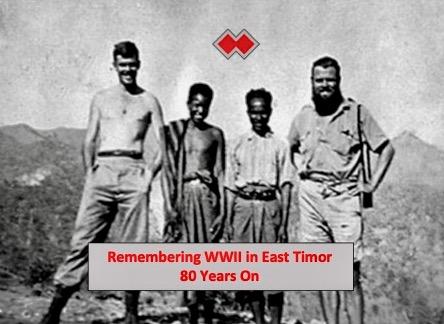

unidentifiedsoldier(front).jpeg.cb36b2f951964381fb88183304ecface.jpeg)
(left)DutchofficerLieutenantJanZijlstra(right).thumb.jpeg.5cfe1e6ad721b2437788d2ec973c0edc.jpeg)
.thumb.jpeg.28161049af05b590e038f1d3f15b41b7.jpeg)
LieutenantHarryMedlin(right).jpeg.cf4d997f3bc0b61e99579a06cd54dc5e.jpeg)
WingCommanderF.Headlam(RAAF)(right).thumb.jpeg.b12de1c234a3f265692cbdbbbab51115.jpeg)
LieutenantColonelVanStraten(right).jpeg.450b37ac3c6883c7a758f434cea65e10.jpeg)
.jpeg.c4feafd103933229f11051b023e6282a.jpeg)
LieutenantHarryMedlin(right).thumb.jpeg.dfdacf9060999b9c9e6560277f53f9b6.jpeg)



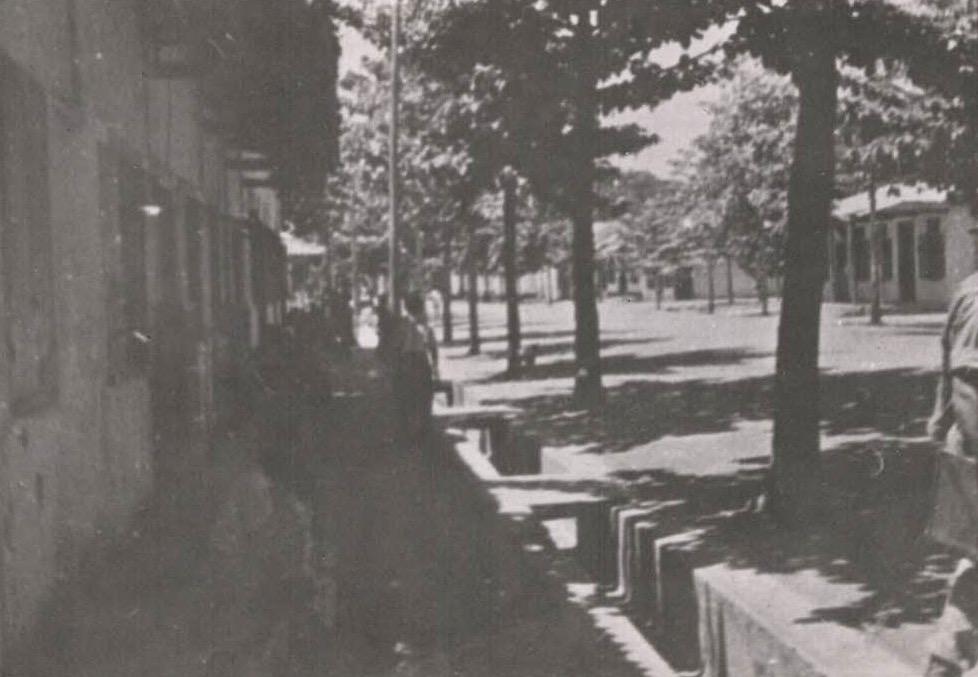
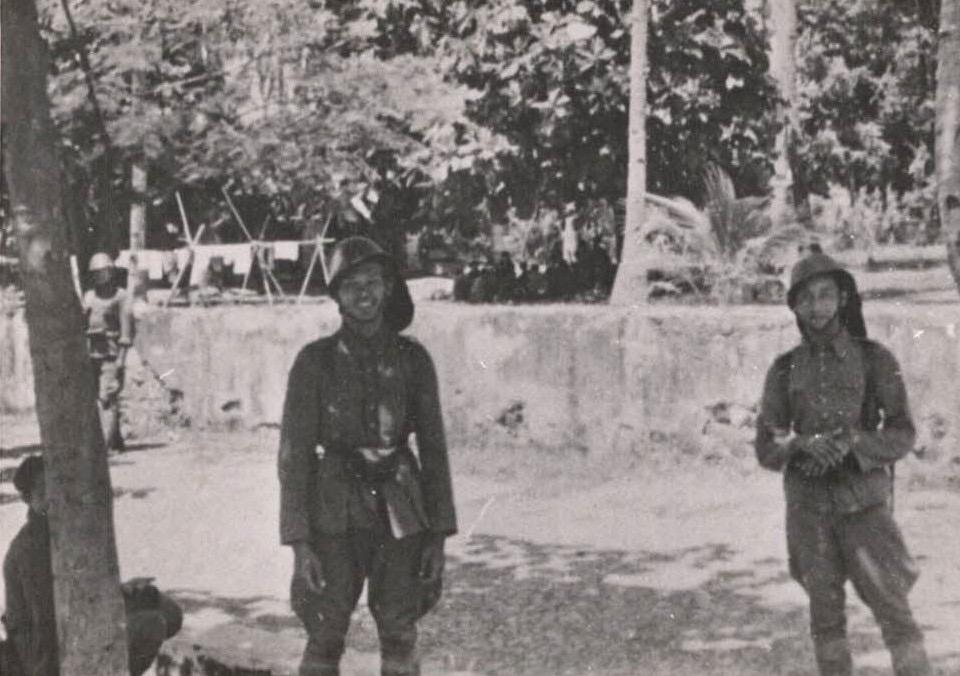

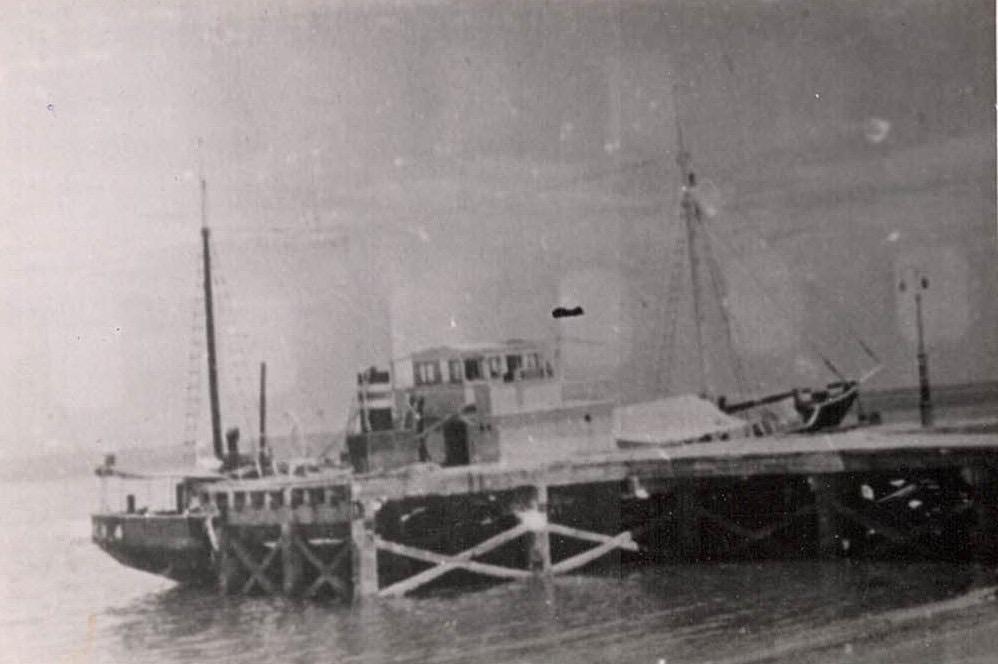
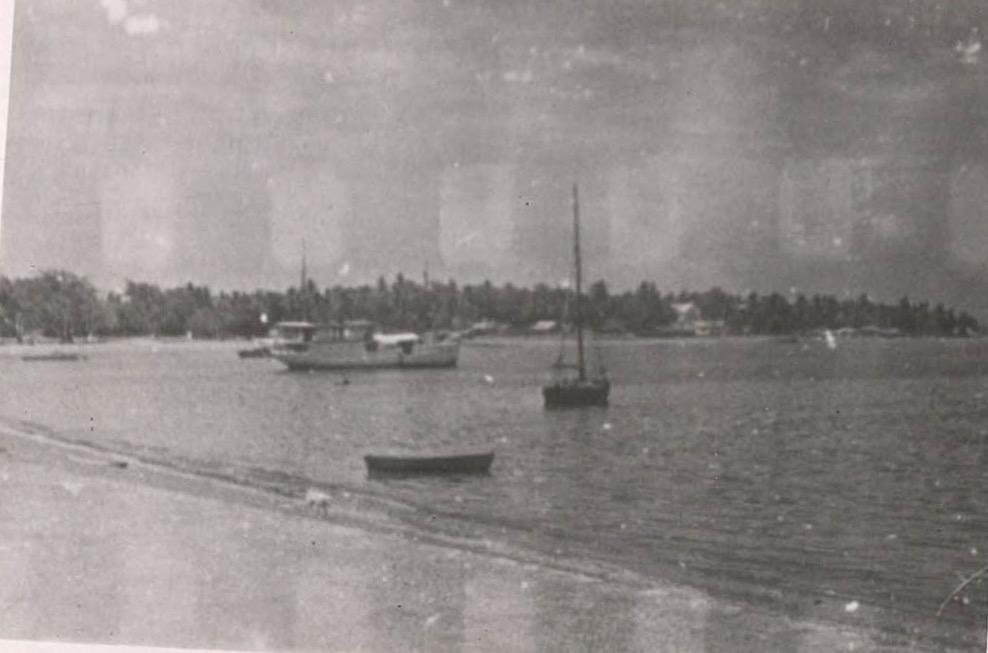
.jpeg.ec6a81b1d2da89fb456885ee270439d1.jpeg)
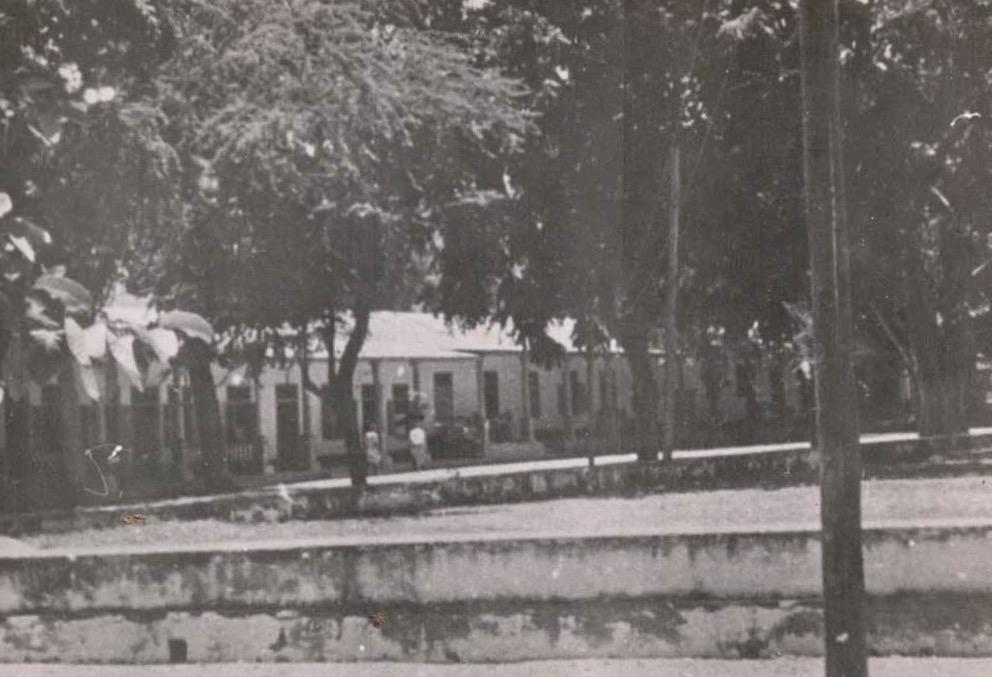
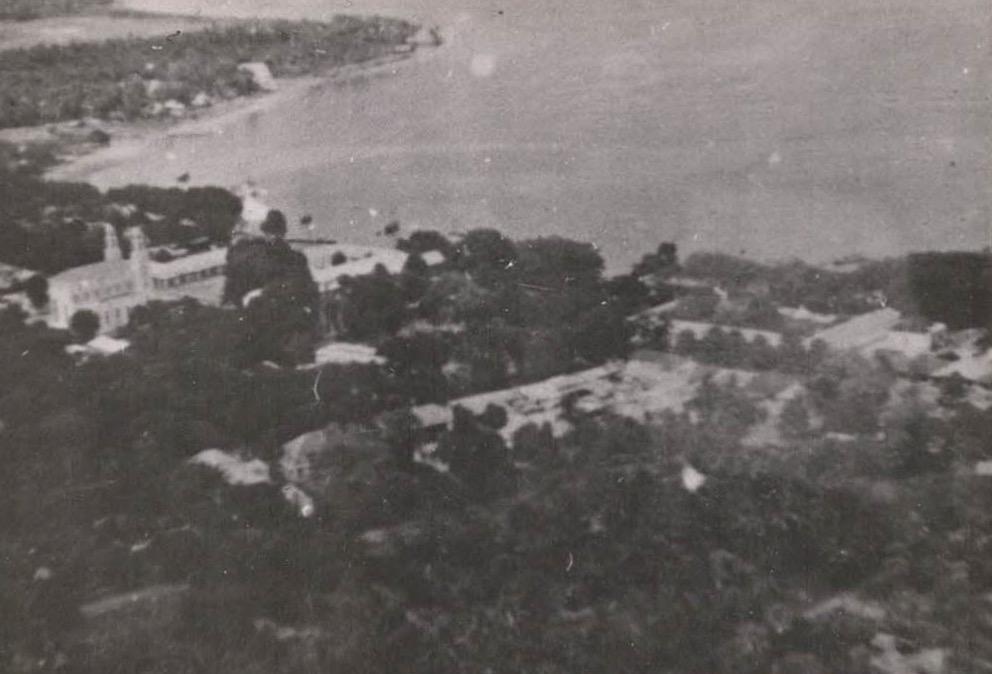
.jpeg.753cadb260c0e25cc4f0c07e8fe1a0c1.jpeg)
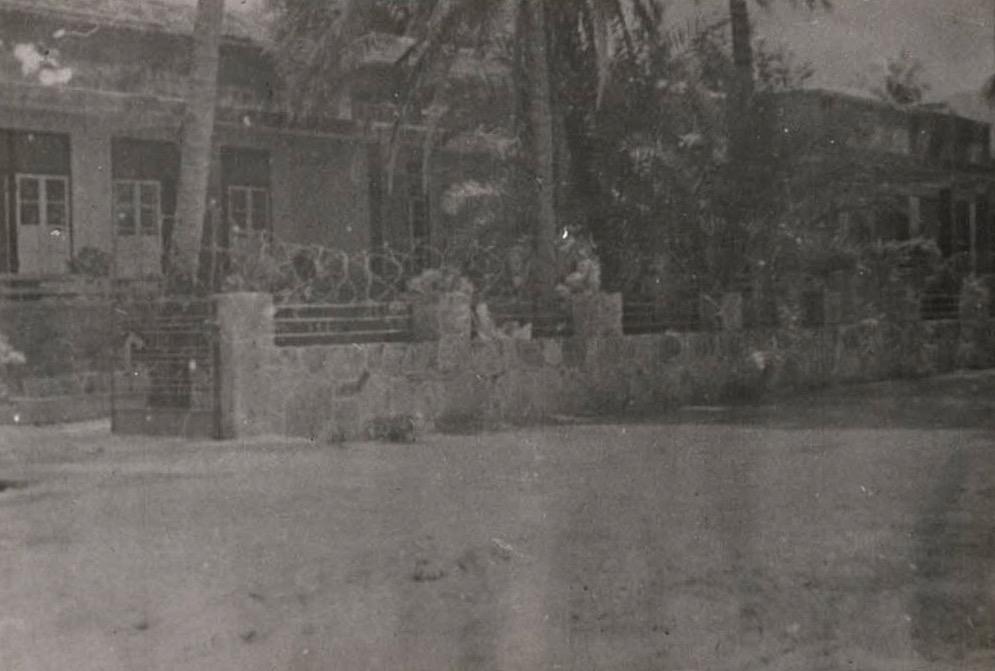

.jpeg.d0785a4f0486da0caea53ab43b9f566d.jpeg)
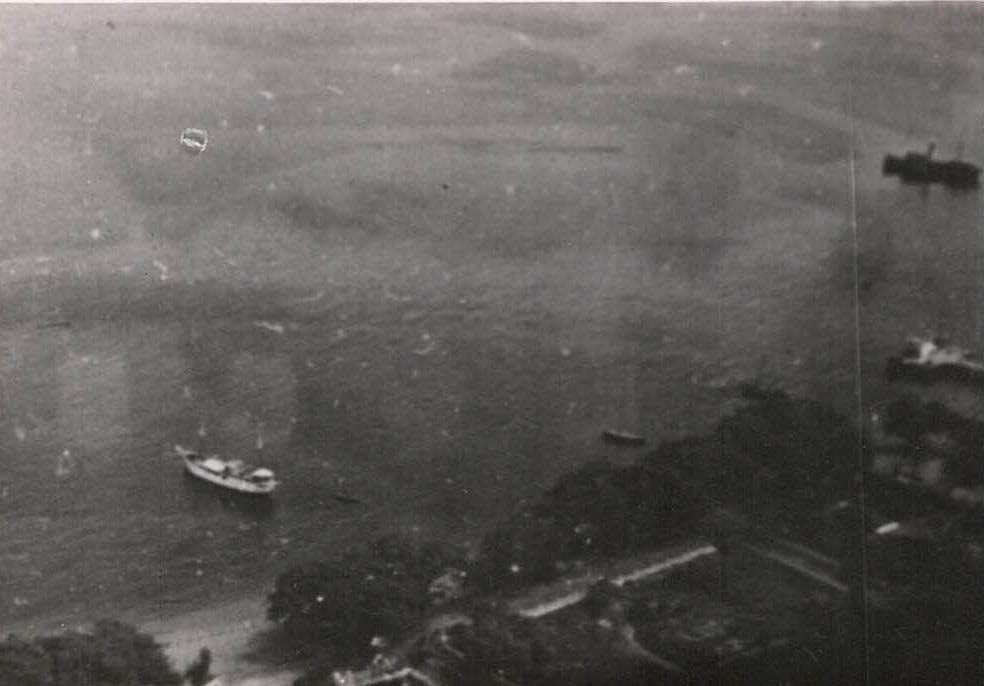

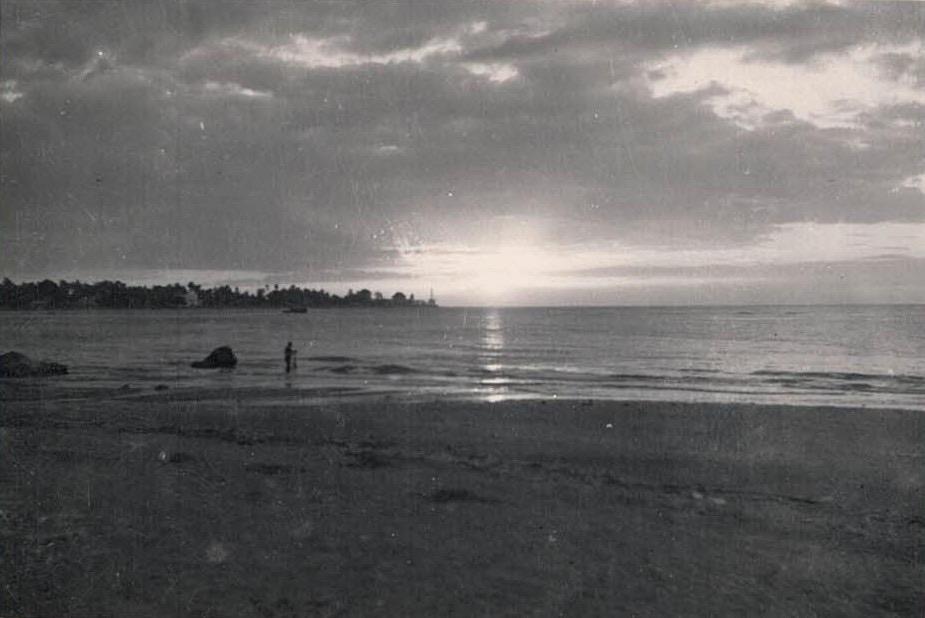
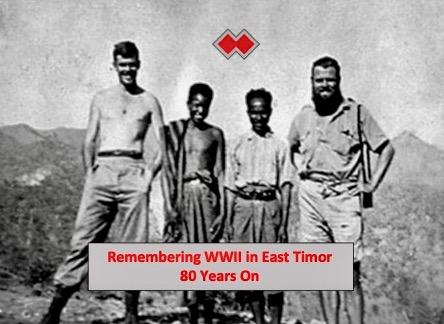
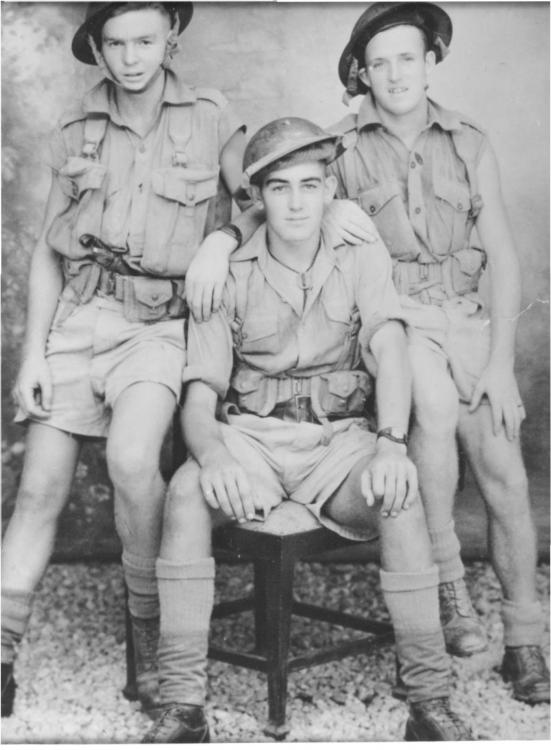
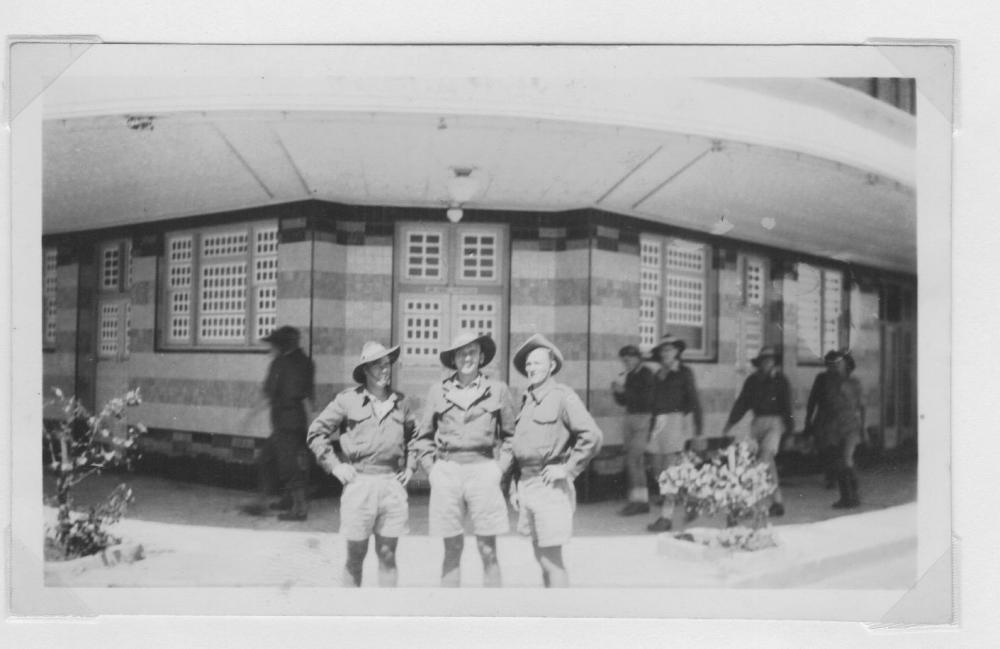
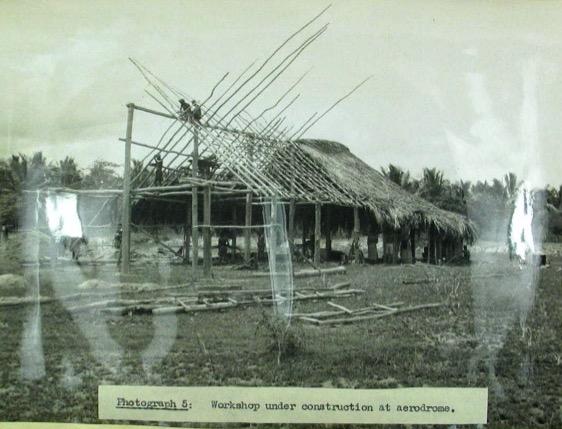
copy.thumb.jpg.1062995dcab73e49415ed4cb6a0cab94.jpg)
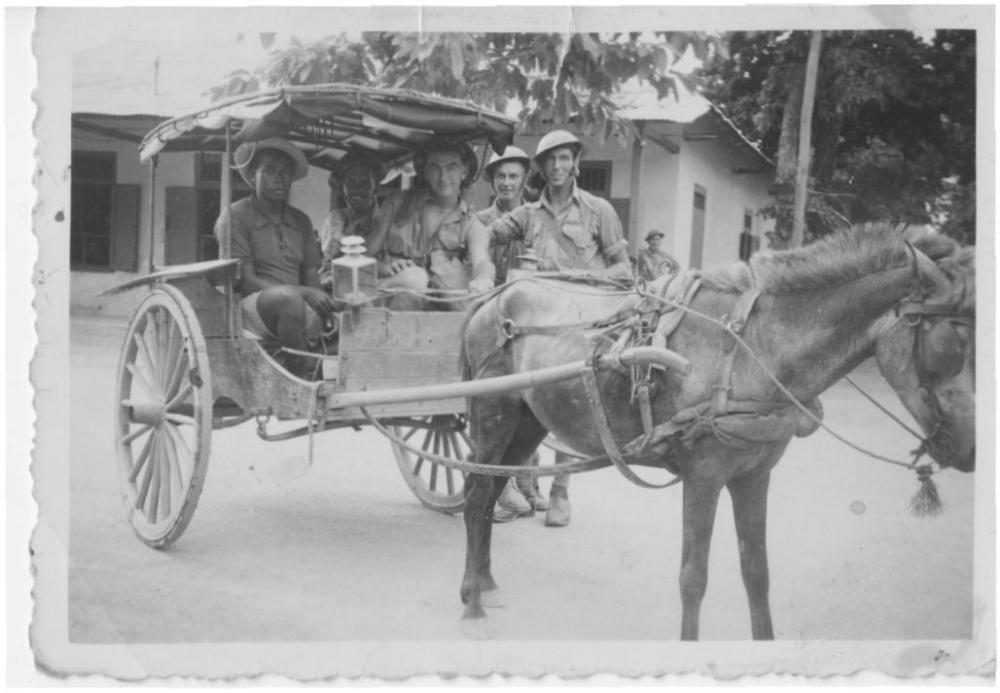
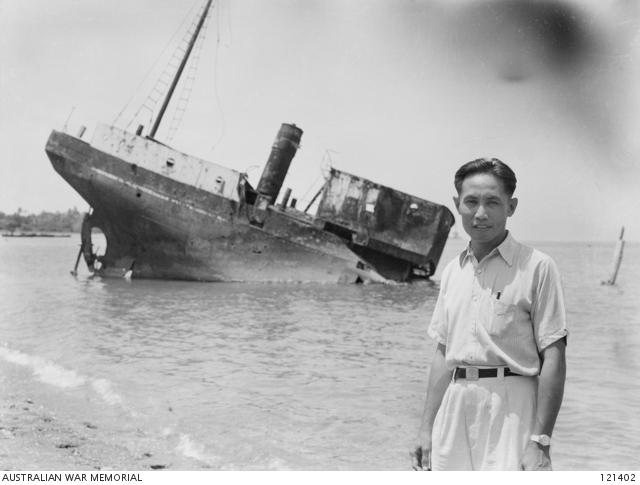
onaregularservice.._copy.thumb.jpeg.fe161070e739cf70401382dac5a58aba.jpeg)
